The records and illustrations here cover some of the more common lichens of Ipswich, Essex County and the surrounding North Shore of Massachusetts. The list does not pretend to be comprehensive or authoritative. Rather, it reflects the ongoing efforts of an amateur to learn about an intriguing form of life, pervasive but very different from our own.
I continually revise earlier entries as I discover the need for corrections and clarifications. I am sure that I will uncover further needs as my knowledge grows.
I welcome comments and questions.
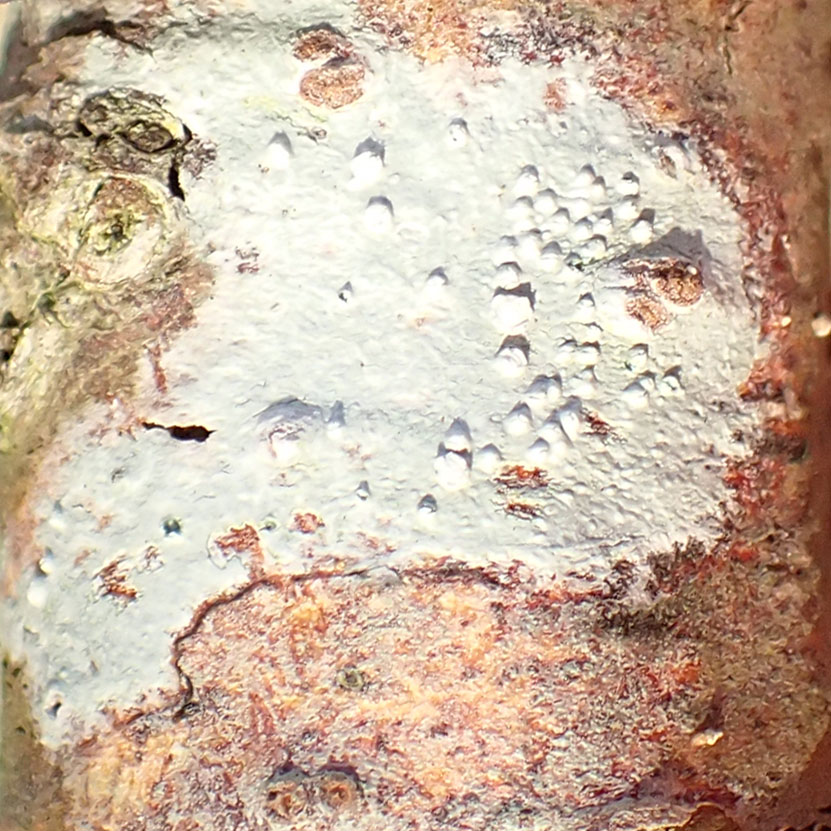
I have hesitated over this specimen for a week. Its identity is not obvious, yet it is clearly there and must be something. Its appearance immediately suggests it is a wart lichen, of the genus Pertusaria. Distinguishing between different species within this genus, however, is generally a lab matter.
In the absence of fuller information, the choice that seems to come closest is Pertusaria consocians. That taxon is "relatively common in the East" and there is one reliable report of it in abutting Gloucester, five or six miles away from my specimen. More and closer records would be nice, of course, but that would be setting the bar a bit high.
* * *
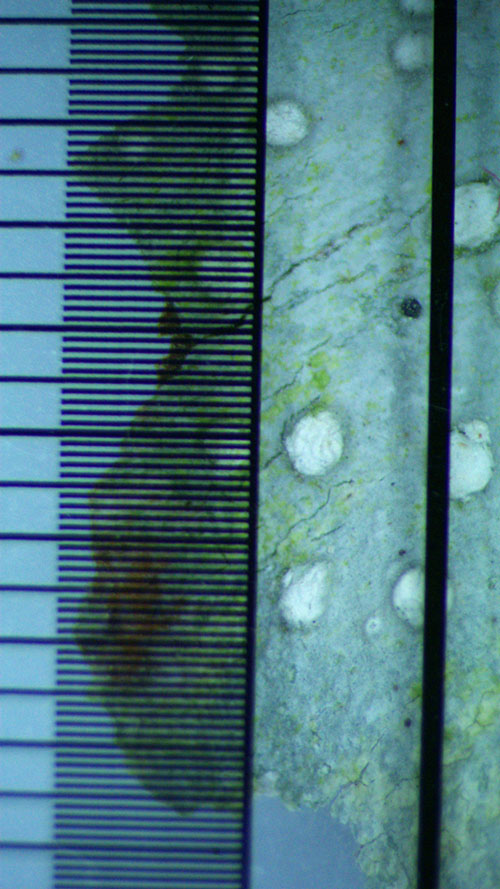
The appearance of the lichen is notable for its greenish gray thallus (body) with white warts. The actual tint is somewhere between that in the two images shown here, rather like it appears on an photograph by Gary Perlmutter. Verrucae are about 0.5 - 1.0 mm (expected, 0.5 - 2.0). The ostioles are small and barely visible. Spot test is K+ bright yellow. The hemlock bark is consistent with the favored conifer substrate.
It is curious that there are darker rings of color on the thallus beneath the warts. They are not above the surface, as with rim lichens.
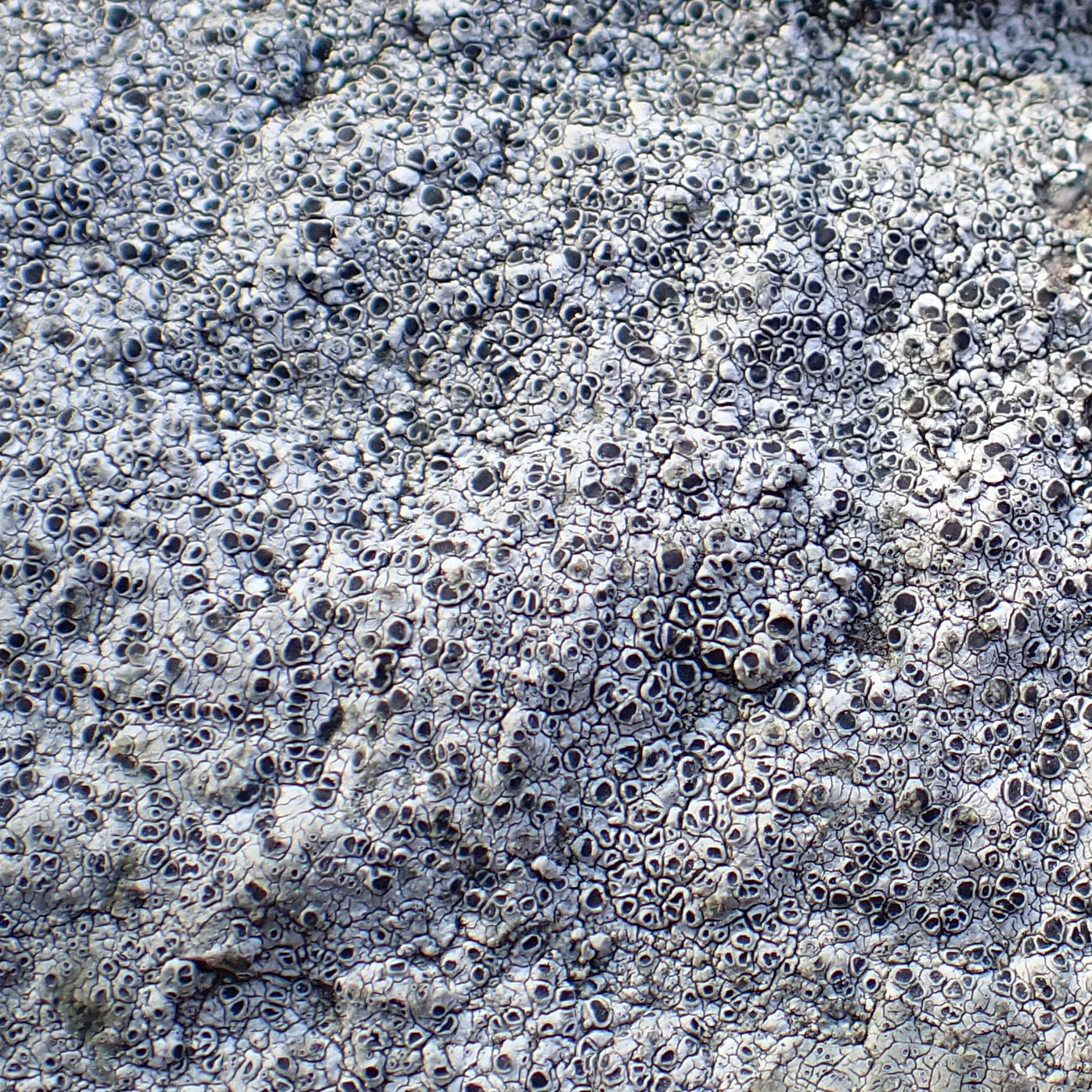
The genus Lecanora – rim lichens – is, in my experience, the most widespread group of lichens in this area. Nearly all of them grow on bark, or less often other woody materials. I have found only one species documented as growing on stone, the smoky rim lichen (Lecanora cenisia).
Lichens of North America comments, "Lecanora cenisia is the most commonly encountered rock-dwelling member" of its group, with a broad range including this area. It is curious that there is only one reported Essex County specimen in the major herbaria. I suspect that there are a number of factors at play: a low frequency, inconspicuous appearance, and the nuisance involved in getting a suitable piece of a granite boulder to submit to the local herbarium.
The one previously reported specimen I have found comes from about five miles away, also in Gloucester.
* * *
The discs of the specimen here are 0.5-1.0 mm (expected, 0.5-1.5 mm). The surface is crustose, verrucose-areolate, i.e. warty and cracked (one of the expected characters). Spot testing shows a K+ yellow stain (as expected).
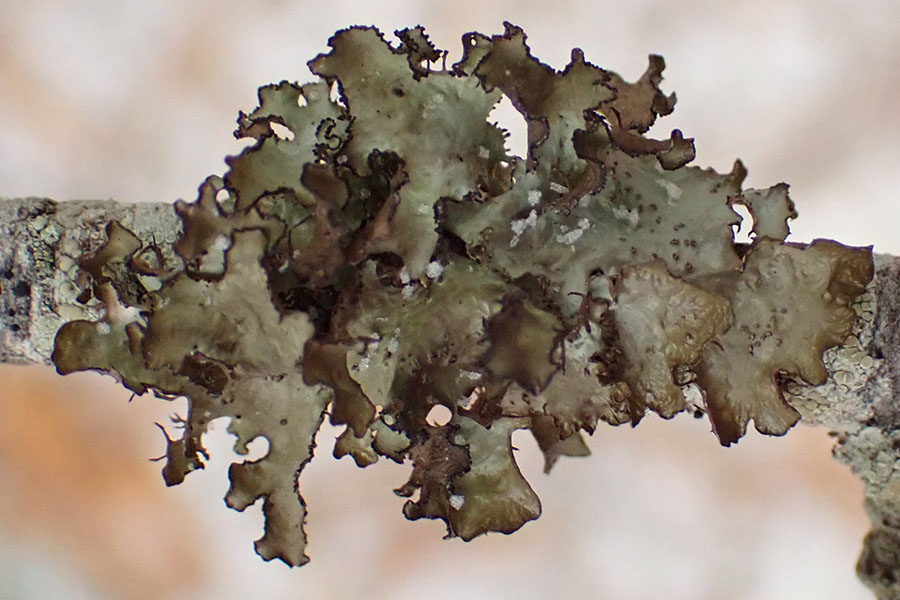
Six weeks ago, I had managed to find examples of all but two of the lichens on my short list of species well-established as present in this area. One morning, the man in the mirror suggested to me that the reason I hadn't found them was that I was looking for something much bigger than they actually were. With that reproof in mind, I readily found one of them, about the size of my thumbnail. It was a fringed wrinkle lichen, most likely Nephromopsis americana.
The wrinkle was – no pun intended – that there is a look-alike species distinguishable only through chemical testing. I was remiss in not performing this due diligence at the time, so I am replacing my earlier entry by a completely fresh one, with the i's dotted and the t's crossed.
* * *
The Macrolichens of New England reports that Nephromopsis ciliaris, also sometimes known as fringed wrinkle lichen stains C+ red. N. americana is UV+ white to light blue. Both are reliably recorded as present in this area. With a drop of household bleach and my recently acquired ultraviolet flashlight, a nifty gadget, I have verified that this specimen has the chemistry of americana.
Perhaps another day I will be able to add an example of Nephromopsis ciliaris.

This lichen, which I came across on October 26, has caused me much confusion. At first I was very pleased to have found, I thought, a specimen of fringed wrinkle lichen, Nephromopsis americana. After a while I decided that the image was a poor example of that species and replaced it in my journal with another picture. I am realizing now that the reason it didn't look like americana was that it wasn't. It was of another species, the dwarf wrinkle lichen (Nephromposis fenderli, formerly Cetraria fenderli).
Of course, I could find excuses for my slip: it really is dwarf-sized, the species are closely related, and americana is documented as present in the area. And fenderli isn't anywhere around, according to contemporary records.
Yet fenderli it is, when you stop to look at things closely. And the Harvard Herbarium has a specimen noted "Cetraria fenderli Tuck. [the botanist Edward Tuckerman] on Pitch Pines Ipswich sand-dunes, Mass. Nov. 21, 1910." You can't get closer than that, and the pines clearly are in an old-growth stand.

I believe that these clusters are Fuscidea recensa, of the genus commonly called quilt lichens. That identification is off the beaten track for this area. Actually, "off the beaten track" describes very well where I was when I found them, up a rocky hillside, fifty yards from any established trail.
I do not find any clear records of F. recensa in this part of Massachusetts, though it is reported elsewhere in the state. I am relying on Lichens of North America with corroborative images, mapping, and documentation, extracted below, including the statement, "Fuscidia recensa is the most common rock-dwelling species of the genus in North America and is the only one likely to be seen at temperate latitudes in the east."
* * *
"Thallus dark brownish gray to pale gray, verrulose [wart-like] to areolate [segmented], growing in zoned [with concentric lines around the edge] patches one against the other… On siliceous rocks in the open; usually in oceanic or at least humid climates."

In a field of study dense with technicalities, the bitter wart lichen (Lepra amara, formerly Pertusaria amara) has brought a couple of welcome human touches. One is simply that it is distinguished by its bitter taste rather than specialized cellular biology or chemical assays.
A second nice moment came when I reached out to Dr. Stephen Sarnoff, who is a world-class expert and whose web site I have recommended in my list of resources. His web page for L. amara was mislinked, and as his site invites, I sent him an email with kind words and a note on the slip. He promptly replied with kind words and the note that he would correct the error, which he did a couple of days later. His response was far beyond what one might have expected from someone of such stature.
* * *
My sample is as described by the Consortium of Lichen Herbaria: "Spot tests: K- or K+ yellow to red… Pertusaria amara is characterized by small, but coalescing soralia with farinose soredia, a relatively thin, grayish thallus and the presence of the picrolichenic acid chemosyndrome and thus a bitter taste."
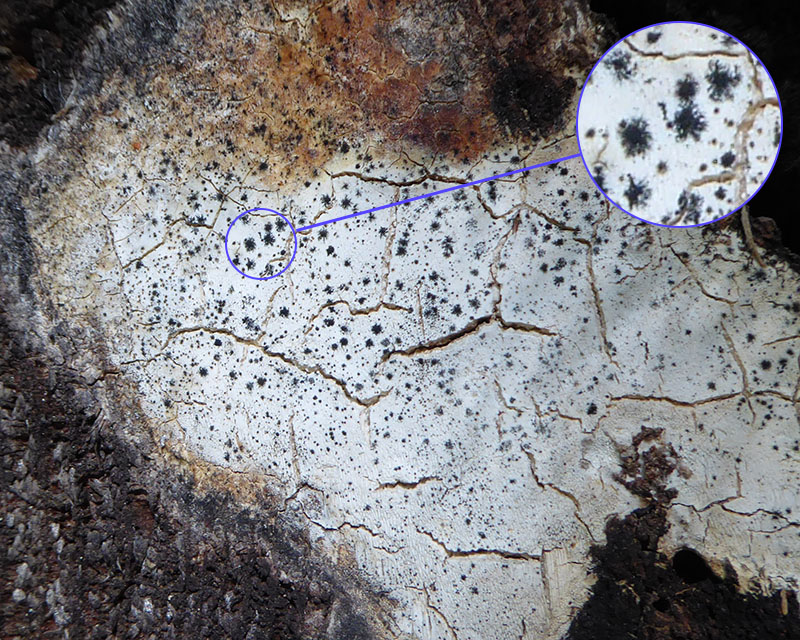
Going over the hundreds of raw images I have collected over the last year, I find many that still pose good questions, with few and partial answers.
I do find an image from May 27 that it appears to fit to name Phaeographis inusta, formerly Graphis inusta. This species was originally taken as a cousin of the common script lichen, Graphis scripta. More recently, the two are considered not closely related. The new genus name obviously gives a nod to the earlier one. The specific epithet inusta is Latin for burnt, as fits with the top of the image here. P. inusta is distinguished by the star-like clustering of its "writing," unlike the random scratch-like appearance of G. scripta. It appears in a number of reliable records for this area.
Reservations: the geo-coordinates shown are soft, given my equipment at the time and fading of specific memory. P. inusta is reported to grow on smooth tree bark, while my specimen was on the end of a log cut with a chain saw. Arthonia radiata is a similar-looking species that grows on a wider range of substrates but is less frequently reported in this area. Perhaps another day I will be able to update this information.

It started to drizzle just as I walked out the door this morning. If that has happened five minutes earlier, I wouldn't have made it out. But it didn't, and I did. The colors were very vibrant, a good situation for searching and observing nature.
I came across this specimen of Parmotrema peforatum, commonly called perforated ruffle lichen, which I had walked past five times before, even though it was on my short list of species reported in that area. It was in clear view, only a few feet from the entry boardwalk. A richly colonized tree branch had very considerately fallen from its former sunny heights to human eye level.
The species is notable for its large discs, orangish when wet, light brown when dry, which you can see here from their first budding to fully grown bodies. They have some perforations, as advertized, if you stop to look closely. Less visible but present are the eyelash-like cilia along the lobes of the main body.
I am learning that if lichenologists are rigorous and demanding in their biological specialty, they are vague and confused in their geography. The previously reported growth was shown as being from Agassiz Rocks (now renamed), which is a separate area across the street from the Manchester Essex Conservation Area. But that's good news; now I understand better where to follow the trail of previous searches.
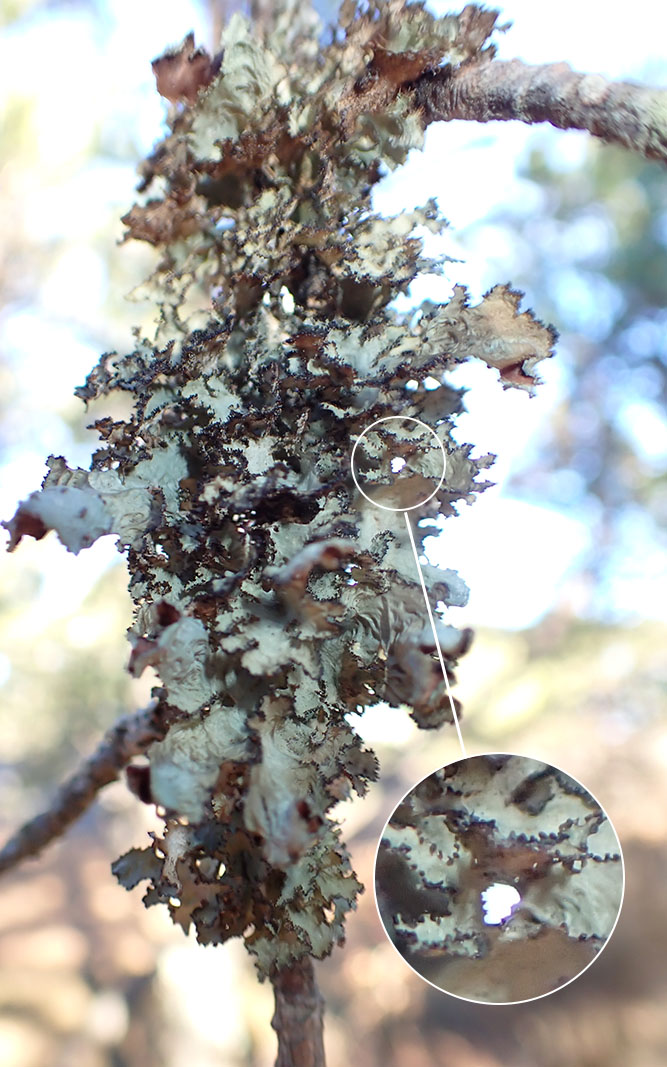
I hesitated for quite a while before making this tentative call. "Paul," I asked myself, "do you really believe you have found a lichen not known to be in this area, a couple hundred yards away from well-established look-alikes?" After poring over literature, looking through the microscope, and returning to collect comparison samples from the look-alikes, I will answer, "Yes, I think so."
I believe that this specimen is a varied rag lichen (Plastismatia glauca). My immediate reaction when I saw it was that it was different from anything I'd found before. After study, I still think so. I have listed below some of the technical considerations in this identification, for and against; but the art of lichen recognition is like facial recognition. You know that a person is (or isn't) so-and-so, but you can't prove that by logic or offer a precise set of measurements.
Note the extremely ruffled, sometimes pointed character of the edges and the dense small masses (soredia) along them.
P. glauca is recognized to be common along the Atlantic coast and in inland Massachusetts, but has not been reliably reported in the North Shore.
* * *
The Macrolichens of New England comments, "This species… can be distinguished from any NE Parmotrema [ruffle lichens or scatter-rag lichens] by its lack of cilia [eyelash-like structures]." I have been careful to verify that this distinction is applicable here.

Lichens of North America describes the lower surface as brown and shiny at the edge, an unusual characteristic observable in the microscopic image of this specimen.
For what it's worth, which is less than scientific rigor, Google returned P. glauca as its first pick to go with the top image.

I will offer a tentative identification for this lichen – tentative, because of the small size of my specimen and because of a lack of records of species presence in this area. I believe that if this reading isn't spot-on, it's at least very close.
I believe this specimen is most likely a (southern) powdered ruffle lichen (Parmotrema hypotropum, or P. hypoleucinum, both going by the same common name). Their chemistry is only slightly different, requiring a very well-equipped laboratory to evaluate. Both are reliably reported in coastal and inland Massachusetts, neither in Essex County.
Another day I will look nearby for a larger grouping of this taxon, which would enable a better photograph and closer study. My experience is that one lichen is seldom far from others of its kind.
The Manchester-Essex Conservation Area seems to be an extremely good one for lichenology. It has much old-growth area that earlier lichenologists have not mined.

I have hesitated about this lichen for several good reasons: I have had countless failures in identifying growths that look just like a blotch of white paint, lab study would be pretty much de rigeur for its class, I can find no strong record of local specimens, and there are no good chemical tests.
Still, it seems reasonable to tentatively identify this example as Plitt's wart lichen (Pertusaria plittiana). It has a warty surface, which is a defining characteristic of the genus Pertusaria. Lichens of North America observes, "This is the only fertile, rock-dwelling Pertusaria in the east." That is quite specific. On examination, my specimen seems to fit well with the description by the Consortium of Lichen Herbaria (extracted below).
It was a few feet away from the sulfur firedot lichen that caught my attention, or I probably would have passed it by altogether.
* * *
From the COLH description: "Thallus crustose, epilithic, ash gray to dark gray, thin to moderately thick; margin +/- entire, rarely zoned, often radiately cracked and paler than thallus. Surface verrucose, shiny or matt, predominantly rimose or rimose-areolate; areoles (0.2-)1.4(-3.0) mm diam… Fertile warts thallus-colored, frequent, dispersed or locally crowded and fused (2-3(-4), initially conical becoming flat-topped, sometimes granular or eroded, 0.4-)1.2(-2.5) mm diam. Ostioles 1 or 2-8+ per fertile wart, concolorous or dark beneath, frequently surrounded by a whitish border, level or sunken, scattered or grouped in a central depression."

I happened across this specimen of sulfur firedot lichen (Gyalolechia flavovirescens) on a very casual walk, about half a mile from my home. It is not a common species hereabouts, but there is a reliable report of its presence in Topsfield, the next town over.
I will remark that Google Lens got this one right immediately as its top suggestion. Of course I didn't rely on that report alone, but being able to start in the right place made identification much easier. There is little doubt about what it is.

The bushy beard lichen (Usnea strigosa) has remarkable organs that remind me of flowers, or perhaps some kind of exotic astronomical body. It has been previously reported at Crane Beach.
The Consortium of Lichen Herbaria notes, "Usnea strigosa has many different chemotypes and needs a modern and thorough revision of its taxonomy." Given the unclarity of its chemistry, I have omitted even basic standard tests.
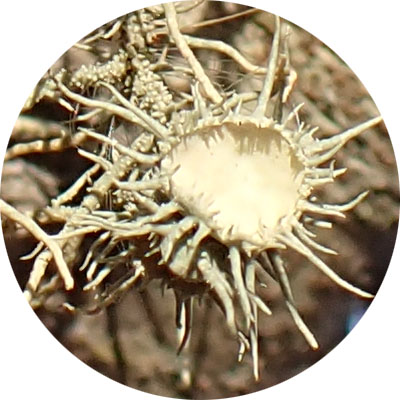
The Macrolichens of New England remarks, in very dry, unpoetic language, "This striking species usually is easily recognized because it has obvious apothecia [saucer-shaped fruiting bodies]." The authors are understating their feelings; in fact, a picture of U. strigosa is on the cover of their book.
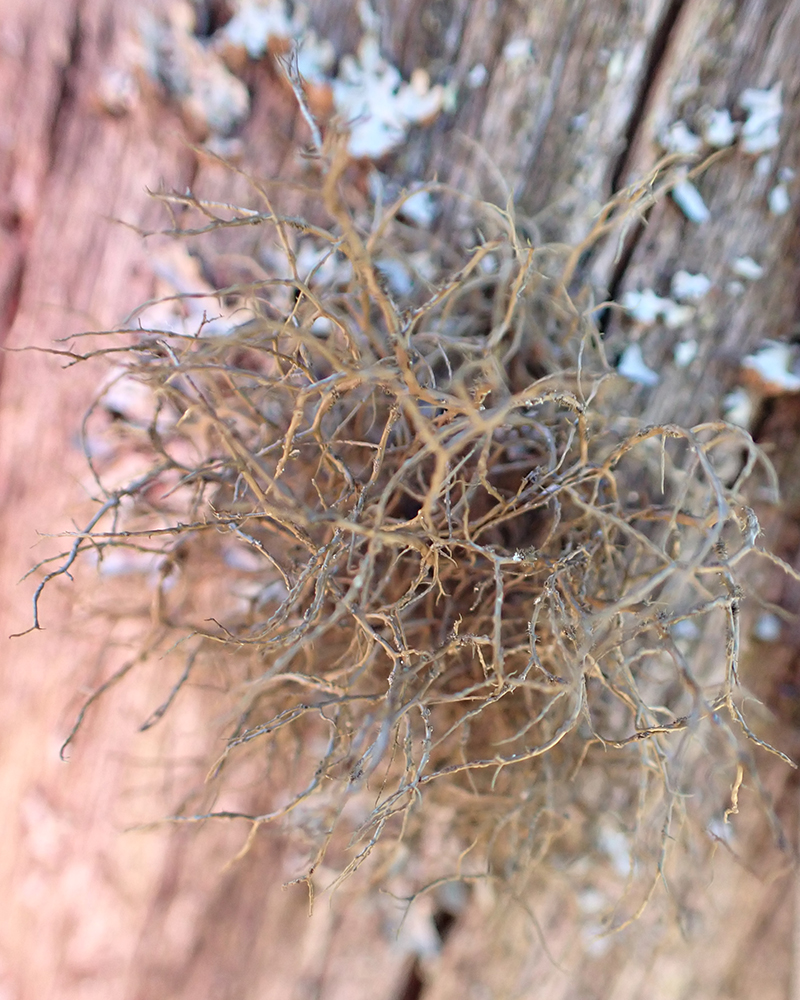
I have been looking for Bryoria furcellata for a while. It is reported to grow "mainly on conifers in sheltered to somewhat exposed sites but [is] also found on rock outcrops or boulders, lignum, and rarely on soil." Its presence at Crane Beach is well-documented.
I have been keeping an especially careful eye out for it (and one other species) over the last week, with a focus on pine trees, following the guidance of the experts. Yesterday, I stopped out of idle curiosity to look at an old fence post, isolated, in full sun, with no thought of B. furcellata. But, lo and behold, there it was, on wood (lignum, in the still-Latin universal language of biology).
I suspect that it is growing abundantly on nearby pines. I will expand my search another day. It is tricky searching for a dark thumb-sized growth on dark tree bark, but now I have a place to start.
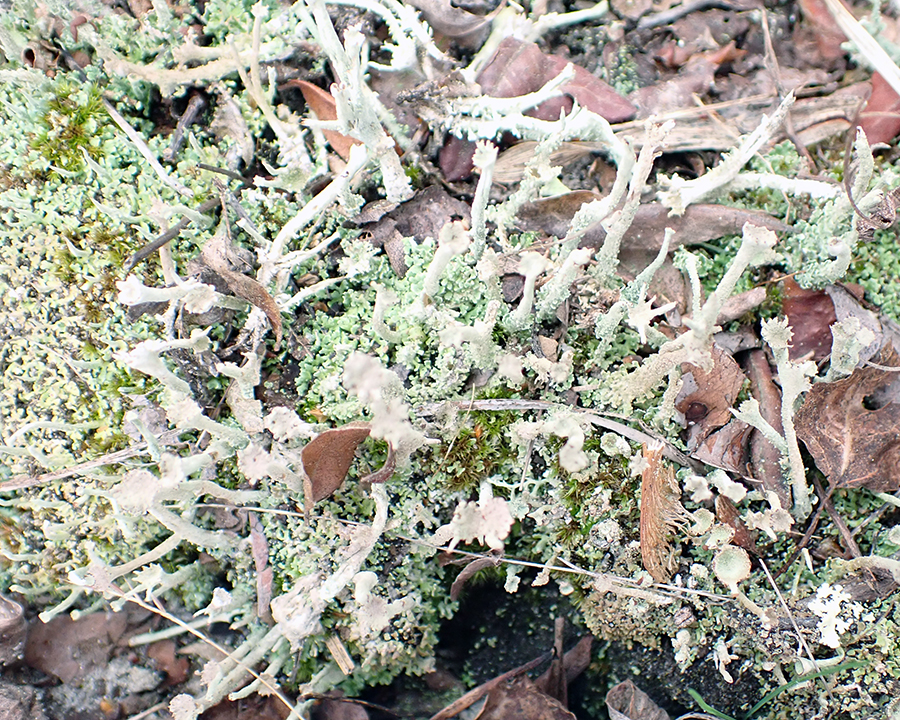
I stopped to take a picture of this growth, thinking it would be a nice, clean example of "common pixie cup" lichen. But when I looked more closely, things were not as smooth and symmetric as I had imagined.
What people call "pixie cup lichen" covers a multitude of sins. The particulars are a story for another day, but for now: on a close look, the cups of this specimen are of all sorts of irregular shapes, and might reasonably be called "deformed." In fact, I think it most likely is the lesser sulphur cup lichen (Cladonia deformis).
* * *
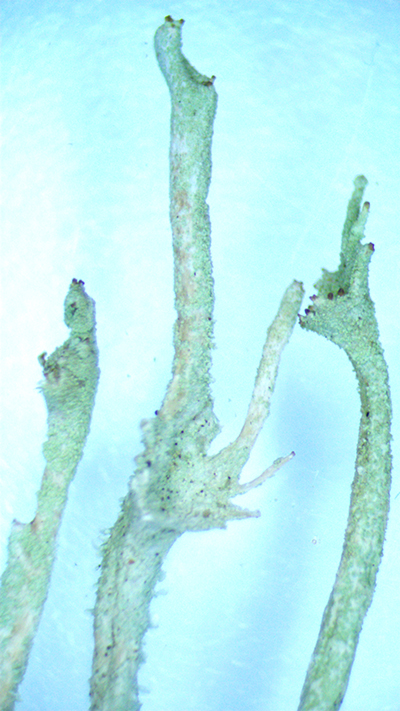
An alternative identification would be Cladonia sulphurina (formerly called Cladonia coccifera var. deformis), as its names would suggest, a close cousin of the lesser sulphur cup lichen. But, as the Council of Lichen Herbaria (COLH) notes, "Cladonia deformis is actually less deformed than C. sulphurina." To my eye, C. sulphurina has a degree of intricacy and laciness that is beyond that of the example I collected. See the enlarged image on the left in comparison with those shown by COLH.
C. deformis is not shown in any Essex County records that I can find, but it is present in a quite comparable specimen from nearby Norfork County in the collection of the Harvard University Herbaria.
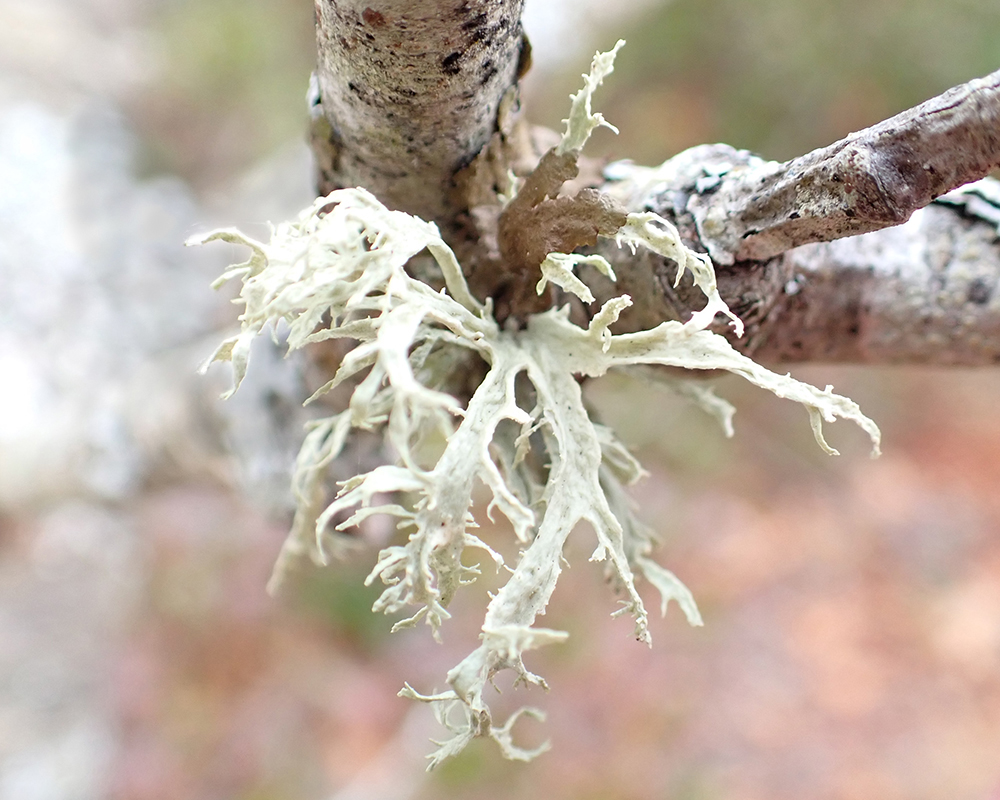
It surely is easier to spot lichens with the leaves mostly off the trees. And somehow, this tufty, thumb-tip sized growth looked from several feet away not quite the same as similar types that I have come to recognize. Its lobes appeared at first flat, and on a closer look actually concave.
I believe the species is northern sinewed Ramalina (Ramalina americana). The description in Lichens of North America is apt: "branches with strong ridges and channels." Indeed, the edges of the lobes in this image are reminiscent of sinews.
This identification is rather off the beaten track for the area. The Harvard University Herbarium does have a specimen collected in Ipswich at an unknown time, and another in neighboring Boxford, collected in 1884 and confirmed as a "very robust" identification in 2005.
The main cluster from which my specimen probably descends is on an ancient cherry tree (Prunus serotina) nearby. That tree has an expected lifespan of 100-200 years, so data from the late 1800s is relevant today.
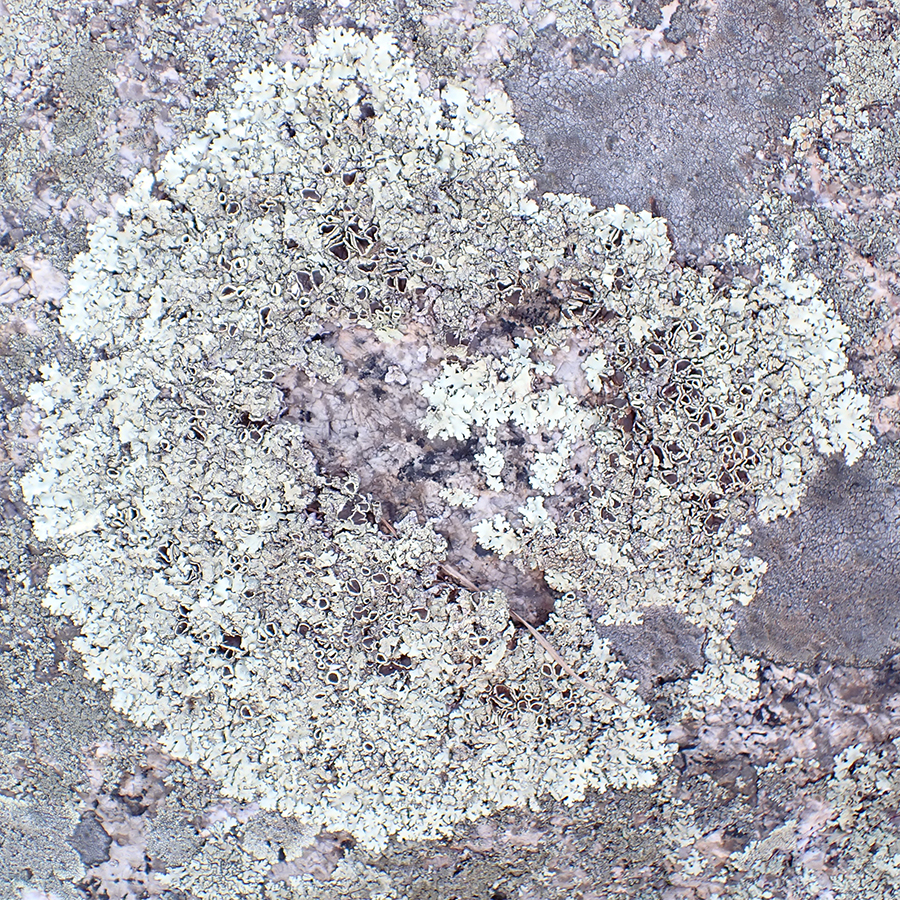
It is easy to go astray amid all of the many greenish gray lichens with forms that begin, at least, as rosettes. My mind has inappropriately lumped Xanthoparmelia cumberlandia with other species. I noticed yesterday that it is extremely common in this area, unremarked by me. Yesterday, I read over its description again.
Today I spotted it almost immediately. As the saying goes, I could have tripped over it. It is quite a large, readily visible lichen. It and others of its kind were all around the area of Rockport where I was, a stone's throw from the sea.
* * *
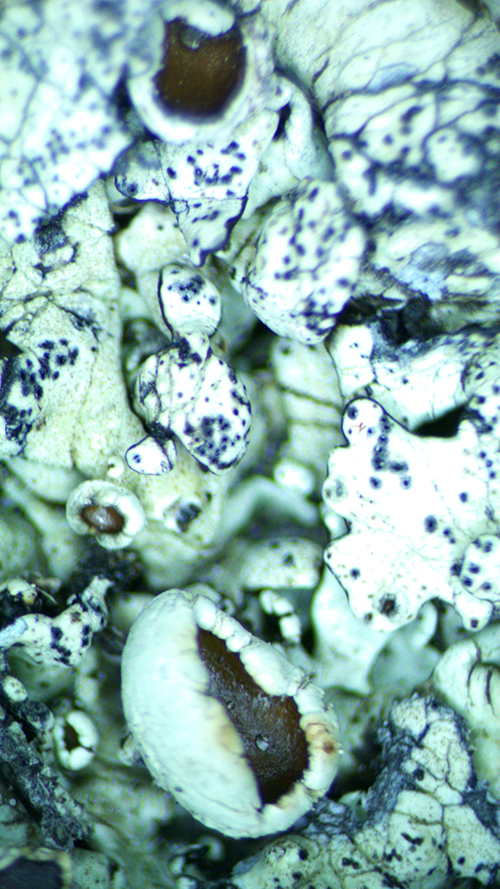
I will note a few technical points about my specimen with reference to published norms for the species. At some 16 cm in diameter, it is above the expected size of 6-12 cm, but not outrageously so. It has lost a patch in its center, torn away from the granite (expectation: adnate [tighly attached] but "the coastal population is more loosely adnate"). Its discs are large, at up to some 5 mm (expected: 2-10 mm). Its medulla (body) is white, staining K+ yellow becoming dark red, as expected. Its upper skin is K+ dull yellow, all consistent with references. It is liberally spotted with the small dark spots of pycnidia, as shown in the enlarged image, also as expected. See also published image for comparison.
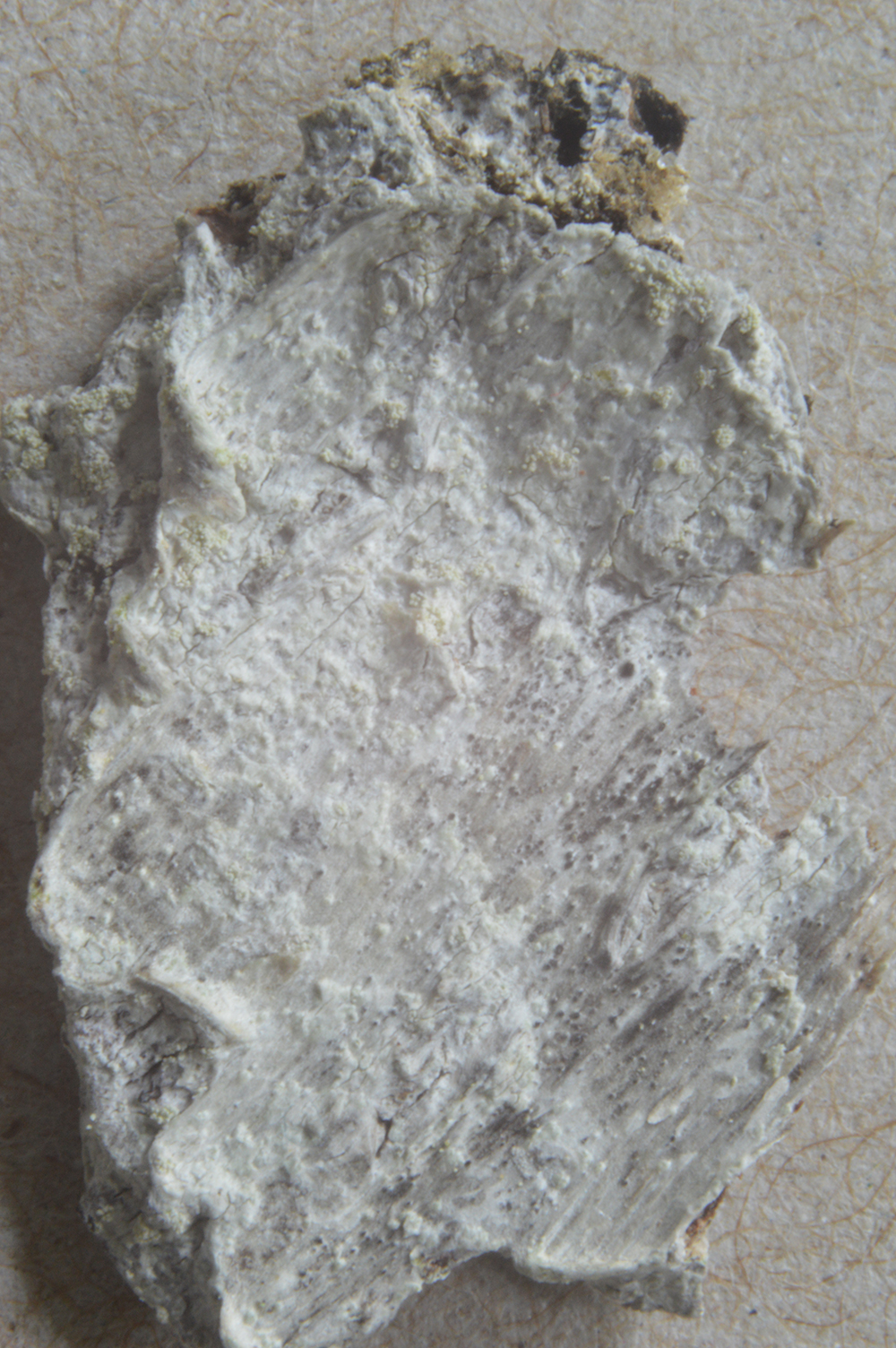
This post corrects a misidentification from several months ago. I'm not sure what I was thinking of, but it obviously wasn't about my Ps and Qs. I am working to be much more careful though not infallible now.
Very small lichens are not easy, alas, and the tiny button lichen (Amandinea punctata) certainly lives up to its name. It has a body that is thin, of a pale gray shade not far from that of weathered wood, and susceptible to collecting and holding dust. It has, as its name notes, small black bodies that look like little dots. This sample was on the same section of wood fence where I have found other lichens. If you look toward the upper left of the image, you will see a whitish area; there are black dots all around.
* * *
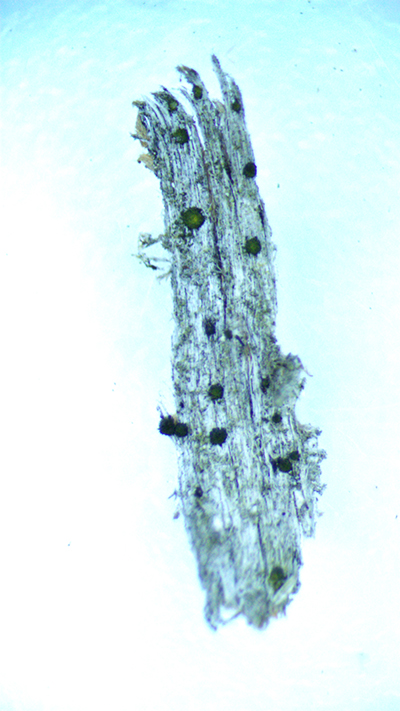
The Council of Lichen Herbaria (COLH) notes, "Thallus [body] thin, ±continuous… surface: dark to pale gray… but frequently heavily impregnated by mineral dust … disc: black…soon becoming convex." The black masses are "(0.2-)0.3-0.4(-0.5) mm in diam." The ones shown here are mostly 0.3-0.4 mm, with a couple at 0.2 mm. The enlarged image is like those by Chris Coshland and Gary Perlmutter on the COLH site. The chemistry of the species is, unfortunately, negative in common tests.
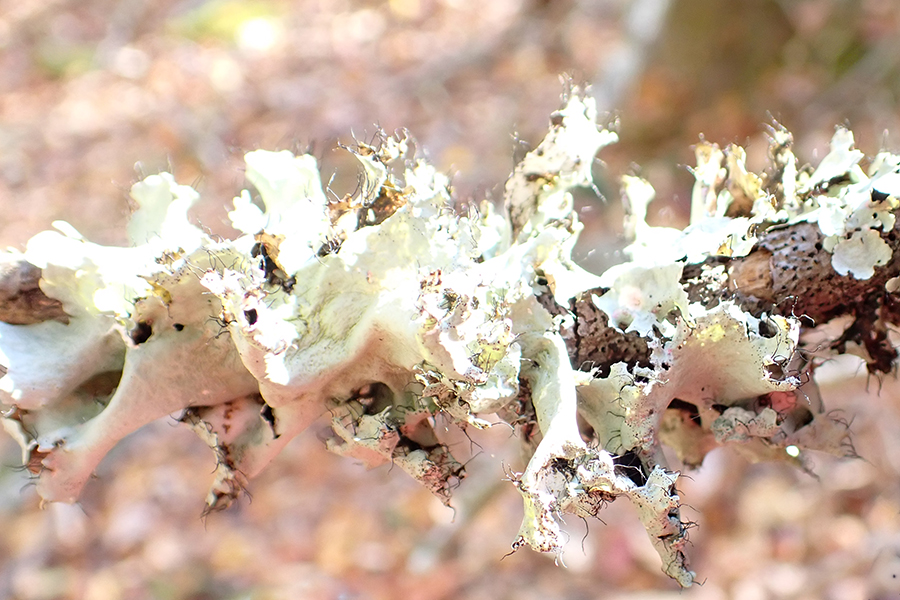
Most of the time, this pastime is swathed in deep layers of routine and sifting and detail. There are rare "Aha!" moments when I immediately spot something new. And a few of those times are special moments when I see something new not only to me, but off the beaten path of lichenologists of this area.
This was one of those moments.
The hair-like projections (cilia) caught and held my attention. I believe that this specimen is most likely a powdered ruffle lichen (Parmotrema arnoldii; note that species of other scientific designations share the same common name), although I would not rule out the possibility of it being a close cousin of that taxon. The Macrolichens of New England reports that it is rare, considered an old-growth indicator. Wikipedia observes, "the lichen prefers relatively well-lit and humid undisturbed woodlands." The area where I found it, within the Manchester Essex Wilderness Conservation Area, clearly qualifies as old-growth, in a relatively sunny area the bordering Cedar Swamp.
* * *

November 16: I happened across this thumbnail-sized specimen a few weeks later. The sand dunes of Crane Beach are a different environment from the Manchester Essex area, but both are old growth. I am very happy to see present a species that was thought to have largely disappeared – always assuming, of course, that my identification is correct.
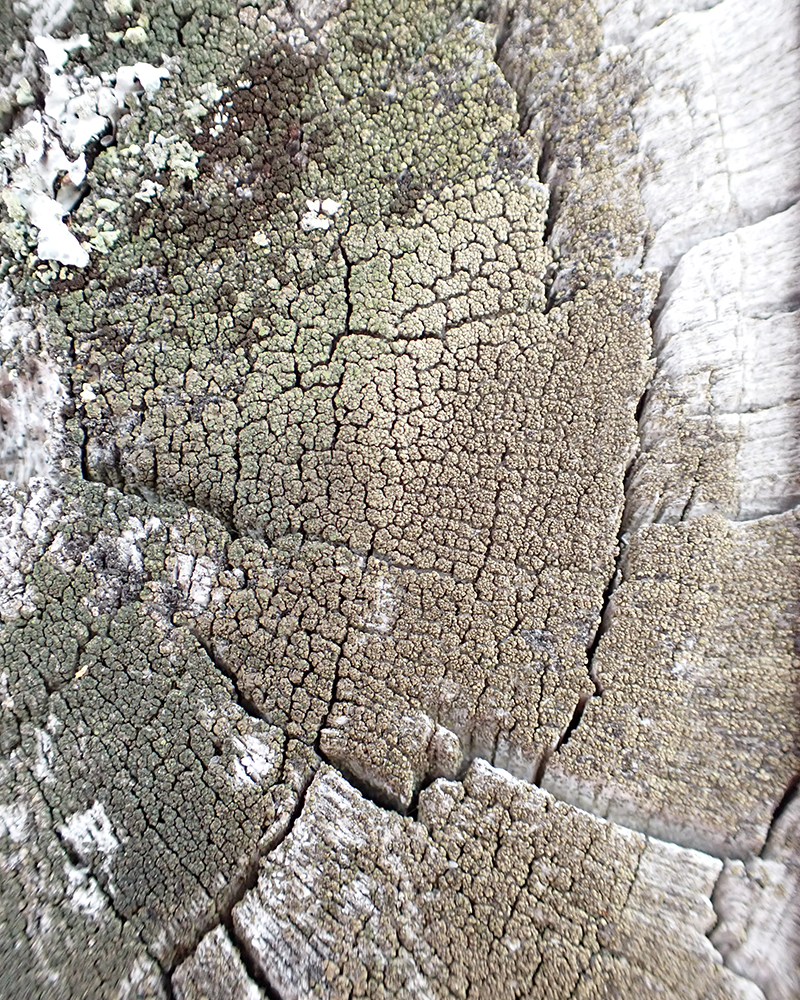
Lecanora conizaeoides is one of the thin, featureless growths that are often reported as present in this area, but the species is not clearly defined in the literature. Perhaps it includes more than one thing.
I have been trying to avoid identifying lichens simply on the basis of their morphology. That said, this specimen looks very much like those shown by the Consortium of Lichen Herbaria as L. conizaeoides, without there being any apparent way to tell for sure whether it is or not. Since it is widely reported, it seems better to include it with the reservation stated than to leave it out.
There are some dark spotty growths toward the upper left of the image. I'm not sure what they are or if they belong with the larger olive green crust.
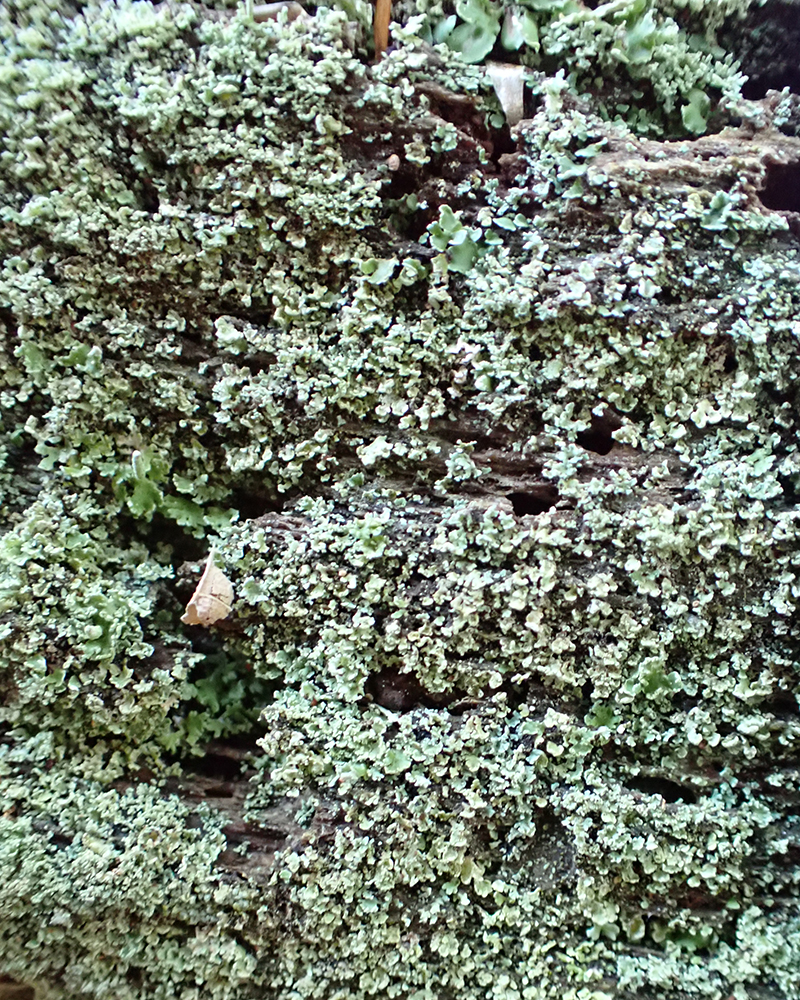
The common clam lichen (Hypocenomyce scalaris) is an unassuming but common presence. As its Latin name suggests, it is a scaly covering ("squamulose" in the language of lichenology) that turns out only on close inspection to be made up of countless small organisms. There are also cupped reproductive discs on stems, too small to be seen by the naken eye in this specimen.
The name "clam lichen" is a bit curious. It may have been that the concave lobes look a bit like empty clam shells, but they are very small.
* * *
(Technically, the identification here is supported by C+ red staining of the exciple.)

The mealy rosette lichen (Physcia millegrana) is common but easy to overlook because of its small size and neutral color. The lower one here is about the size of a dime. The listing by the Consortium of Lichen Herbaria notes, "A very common lichen, Physcia millegrana has been described as the most pollution-tolerant macrolichen in eastern North America."
* * *
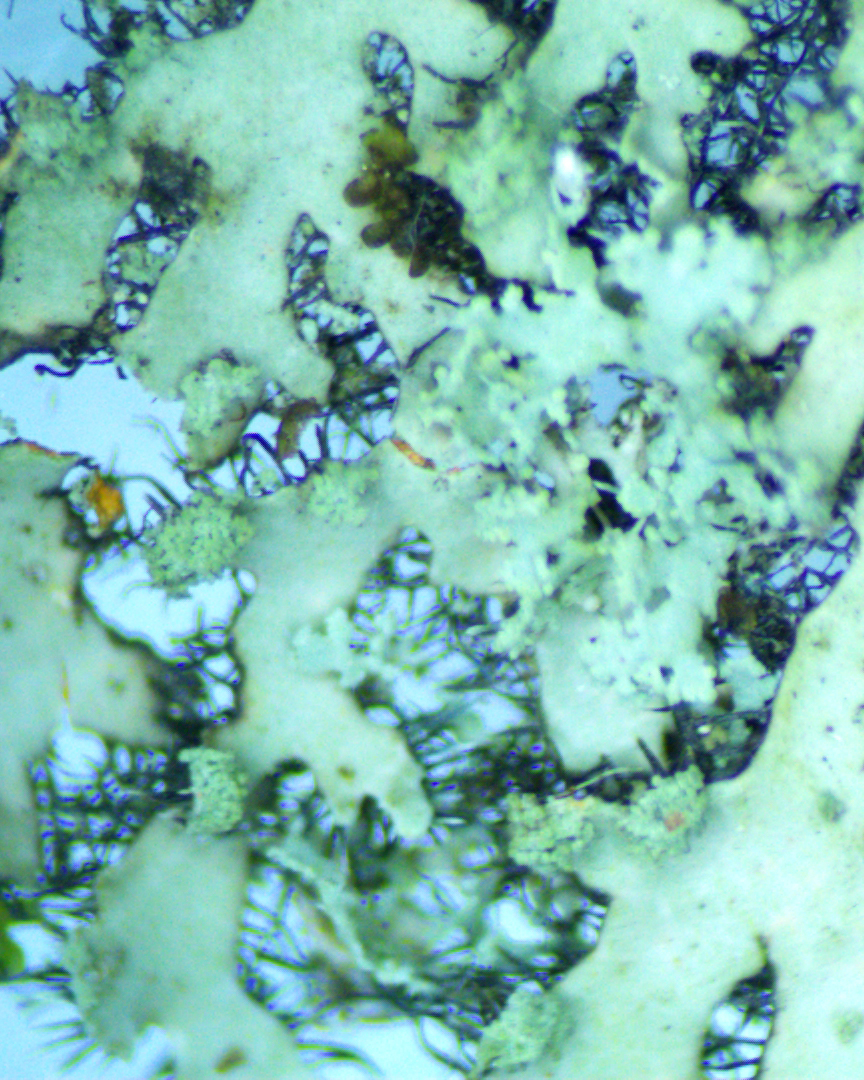
Many common rosette-shaped lichens look much alike. Among these, P. millegrana is characterized by its small size and convex lobes. At a more technical level, it bears clusters of soredia (reproductive bodies) at the tips of it lobes, which are not visible to the naked eye but are readily apparent with a stereo microscope, as shown here. It has abundant rhizines (root-like structures). Its cortex (surface) is K+ yellow.

You can see how the salted starburst lichen (Imshaugia aleurites) got its name. Its lobes radiate out from its center, where the reproductive bodies look like a sprinkling of salt. Here, their presence is so abundant that it is as if someone had simply taken the top off of the shaker and dumped the contents in a heap. Other specimens look more as if they were on a low-sodium diet.
This is one of the rare occasions when I set out to find a certain kind of lichen in a very specific place – and found it there. I had specific documentation that it had been found before at Crane Beach. The Council of Lichen Herbaria reports that it sometimes grows on old wood. I was mindful of one short section of old wood fence at Crane. Of course, I had a general idea of its appearance, and beyond that The Macrolichens of New England noted the distinguishing characteristic of have a light colored underside.
* * *
(Its medulla stains K+ deep yellow, which is corroborative but not probative.)

The weather being iffy and drizzly yesterday morning, I decided to go for a walk near home instead of making my usual foray to Crane Beach. Within about 200 yards, I found a street tree with two or three kinds of lichens I couldn't identify offhand.
One of these turned out to be candleflame lichen (Candelaria concolor). The small growth at eye level that caught my attention first was one of many like it around, some of them coalescing into fair-sized colonies. It's easy to see how this species got its name; it is quite bright.
Things were wet enough that I couldn't get a good image at the time, but this morning it took only minutes to get a better picture.

As part of an overall revision of Lecanora listings, I will highlight two species that are extremely common in this area. Both are highly variable in their appearance, and neither can be identified with any certainty outside of the laboratory; but the images shown here are of very typical and frequent presentations.
The center and very bottom of image above show the bumpy rim lichen, Lecanora hybocarba, or a cousin that is nearly indistinguishable from it. Across broad expanses, more smooth-barked trees than not are striped and dotted by it. It has a light colored body, and discs with red to brown cores with clear margins matching the body color. The discs are about the size of a pinhead or somewhat larger, close to flat. Most often, the body is light gray, nearly white, but it can have yellow or greenish hues. It starts as a roundish growth, but as young trees grow, it often stretches into horizontal bands over the bark of their trunks. It prefers to start on smooth bark, which often is that of a young tree whose exterior may roughen over time. It likes sunshine but will tolerate some shade.
Above and below in the image are two growths of what I will call mealy rim lichen (Lecanora strobolina), noting that the experts are not unanimous about what that includes. The surface of L. strobolina is "strongly yellowish green or greenish to grayish yellow," as the Council of Lichen Herbaria notes. The margins of the discs may not be visible, and the discs themselves may be convex, possibly of a deeper shade, orange or tan. Like L. hypocarba, L. strobalina prefers open environments.
There are other interesting lichenous growths in the picture, I suspect Lecidea variants. Any followup would need to be done in the lab.
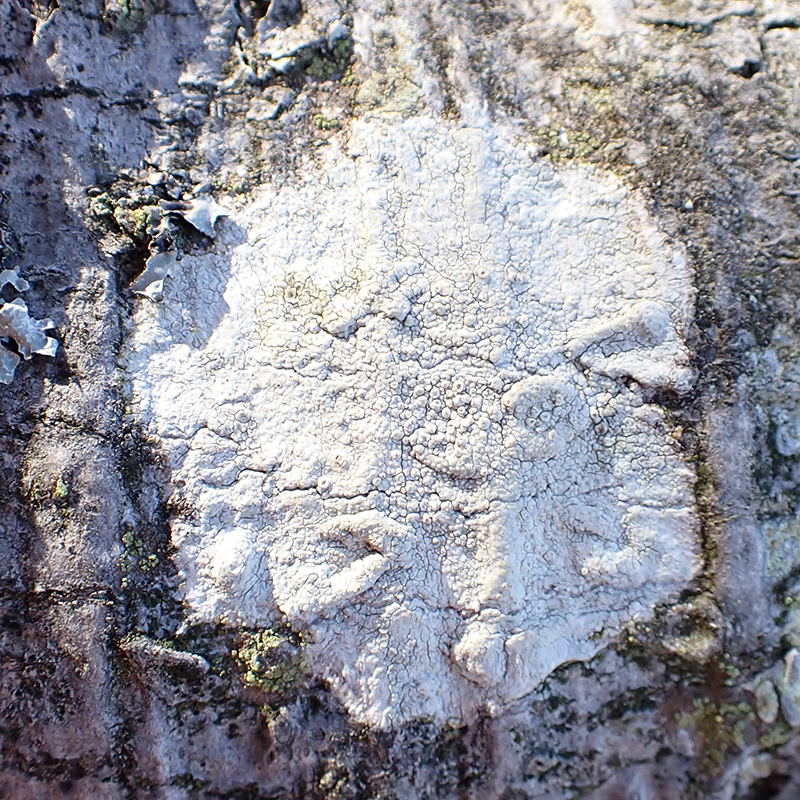
I am little by little becoming more comfortable dealing with lichens that initally just look like a blotch of white paint. I can usually fit them into families fairly readily. Distinguishing between closely related members of the same family can be difficult, even for the experts.
Pertusaria is a genus of warty-looking flat lichens. One of its species is P. macounii, named after John Macoun, Canada's first Dominion Botanist and a noted lichenologist. After consideration, I believe that it is reasonable to identify the specimen shown here as Pertusaria macounii.
There are just six species of Pertusaria reliably reported in this area. One of these grows primarily on conifers, and others are eliminated with basic chemical tests. This brings us to P. macounii, with a technical description of the Council of Lichen Herbaria closely matching that of this specimen.
A interesting side point: the Macoun Nature Study Group reports, "In the past 20 years we have found about 215 species in our one-square-mile Study Area, close to half the number known in the 2800-square-mile Ottawa region. We are still finding additional species when we go looking for them." This exactly matches what I have been learning, which is that finding lichens is more a matter of awareness and understanding than of extended travel. Indeed, I have passed this maple tree thousands of times before, and even stopped to look at its lichens a few of those times.
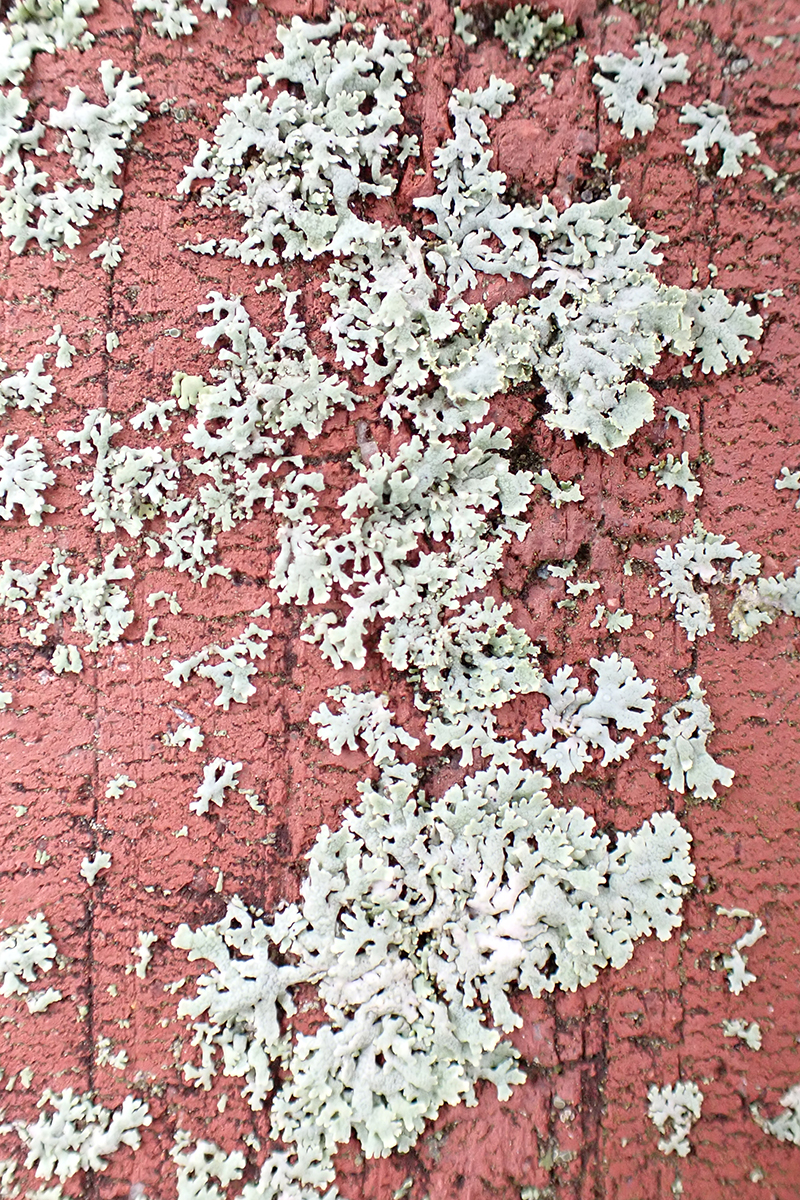
On my brick sidewalk, three feet from where I am sitting now, a set of lichens has been proliferating apace. The first candidate identification was Physcia subtilis, a species defined in 1940. That taxon was split in two in 2017 with the addition of a new species, Physcia thomsoniana. The relevant paper hypothesized that most of the specimens that had been classed under the previous designation actually more properly fit into the new one.
The two taxa are remarkably similar in appearance above the microscopic level. I found a neat fit between my growth and the published descriptions of both. One distinction is available at the macroscopic level: the bodies of P. subtilis are tightly attached to their substrate, "NOT removable from substrate as a useful specimen!" as the paper puts it, while those of P. Thomsoniana are much looser. Mine clearly belongs with the latter.
The one reservation I have is that neither species is reported to grow on brick, and both are reported not to grow on substrates such as limestone. Both limestone and brick are alkaline; but it may be that the calcium of limestone is the alienating factor, rather than its pH. It is also growing at the end of the walk on a granite post, which is clearly not alkaline. At some point, I would like to check whether the specimen I have previously identified as P. subtilis is strictly that under the new definitions.

I have been working on a systematic approach to the difficult and confusing Lecanora genus, narrowing the scope down to species reliably documented in this area. Then I am subdividing by preferred substrate: most often bark, sometimes stone. One species, notably, makes its usual home on pine cones. And, remarkably, one specimen of this set in the Harvard Herbaria was collected in 2000 in "Ipswich, The Crane Estate, Castle Neck. On cone scales of Pinus rigida (pitch pine) in dunes around Wigwam Hill, inland from Crane Beach." And even more remarkably, I was able to find another in my usual morning routine there, without going a step out of my way.
A key paper remarks,
Lecanora minutella is easily overlooked because it has a sparse, disappearing thallus and bears tiny (±0.25 mm) apothecia; in addition, it grows primarily on the exposed edges of pine cones, a substrate that is not often examined by lichenologists. This species is characterized by its dark brown to red-brown apothecia…
You will be able to see the red-brown structures if you enlarge the image here. The name Lecanora minutella is apt – its size is clearly minute.
Amid all of the uncertainty and disappointment and misdirected efforts, it is nice to have one unambiguous direct hit that comes with ease!
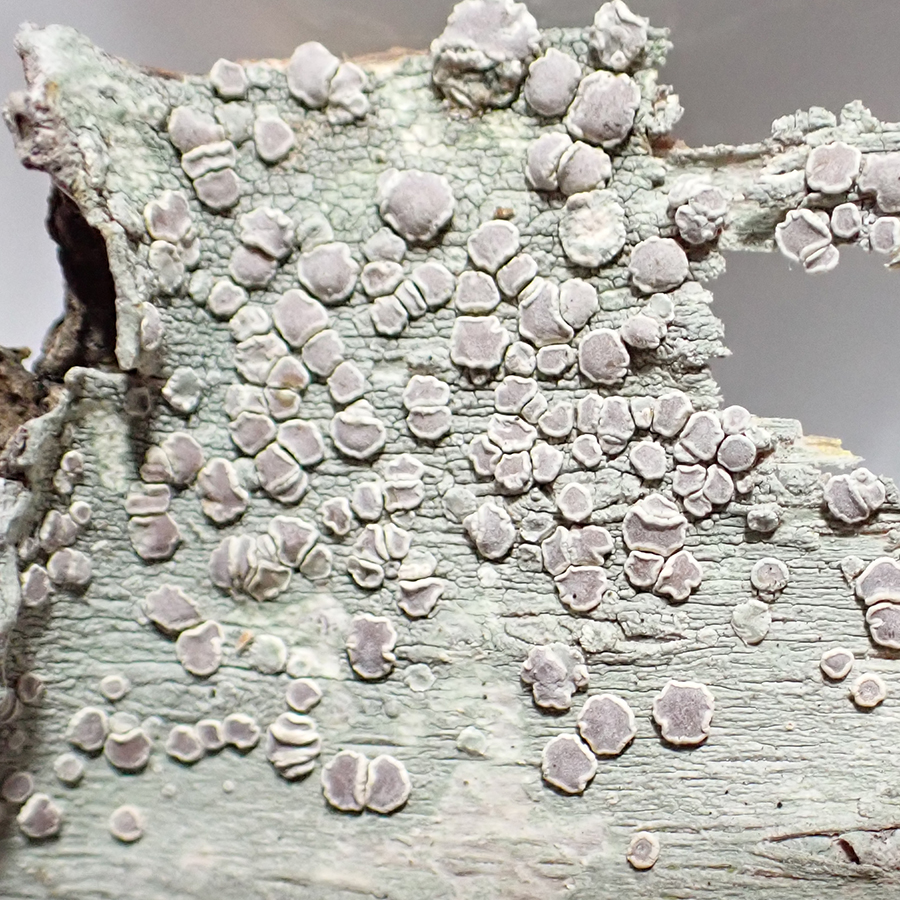
Distinguishing between the various members of the genus Lecanora is notoriously difficult. There are over 200 species, some 20 in this area. They are thin and flat with reproductive discs visible on their surface. They are a matter for experts with labs.
That said, this specimen seems to fit with others that experts with labs have identified as Lecanora caesiorubella, including one nearby. It caught my attention because of the unusually large size of its discs. References report that that those of this species grow up to 3 mm. The ones here reach 2 mm, several times of those common in other Lecanora varieties. Overall, the coloration is a good fit.
On the one hand, this identification is not firm. On the other, it appears viable and more likely than any of the others documented to occur in this area.
Birch is not commonly a host for lichens, including specifically the genus Lecanora. I have searched for some tie from birch to this species or another, but have not found consistent or apparently reliable data.
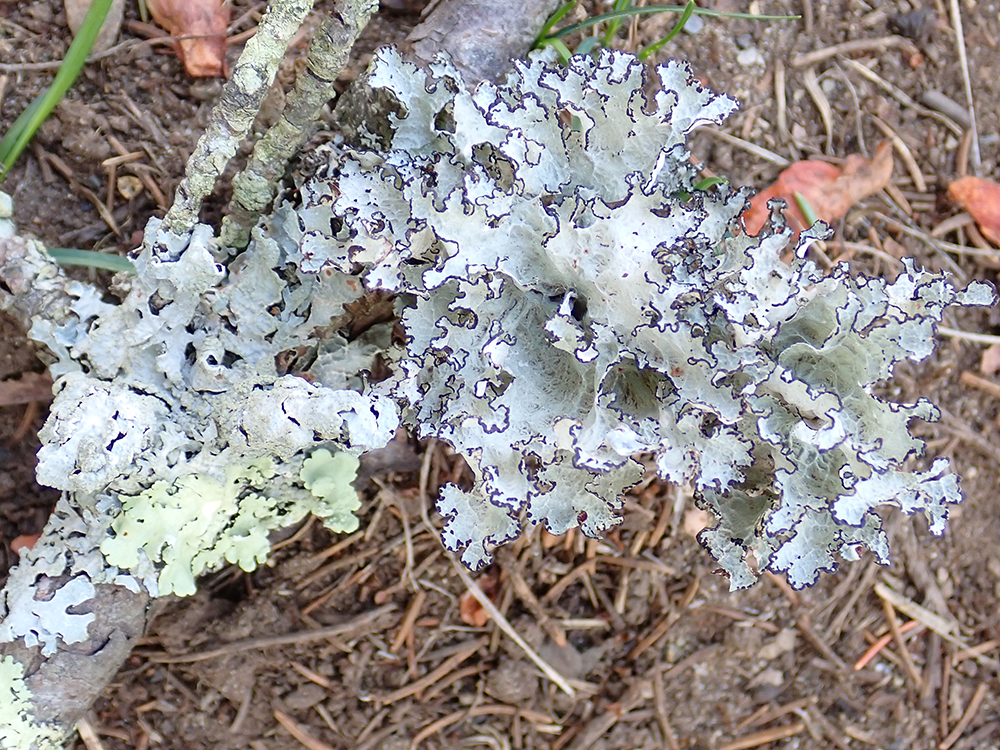
I find continuing gratification in being able to identify a new kind of lichen in a place I have passed by hundreds of times. Increasingly, this involves tinier and tinier growths with less and less certainty and clarity. It is a minor thrill to find a new one of an appreciable size, clear identity, and a striking visual character.
I did this morning. It is called the crumpled rag lichen (Platismatia tuckermanii). It is intricate and frilly, with a delicate violet border. Its surface has the appearance of hand-hammmered metalwork. Wikipedia reports, "The species epithet honours lichenologist Edward Tuckerman, who collected the type specimen in Cambridge, Massachusetts, in 1838." There is documentation of the presence of the species at Crane Beach in 2001.
As I reflect on how it was that I came to notice this lichen today, I believe that such commonplace answers as "luck" and "learning" have an element of truth – but that there is more. A couple of days ago, I spent quite while studying various lichens at Ravenswood Park nearby, but ended up with the conclusion that they were all variants of things I'd seen before. But I gained, at least for the short term, I think, a heightened sensitivy to textures – one of the earliest skills the human eye develops. So, when I passed the crumpled rag lichen this morning, my eye remarked that it looked different from all the other gray lichens around it. – At least, that is my present hypothesis.
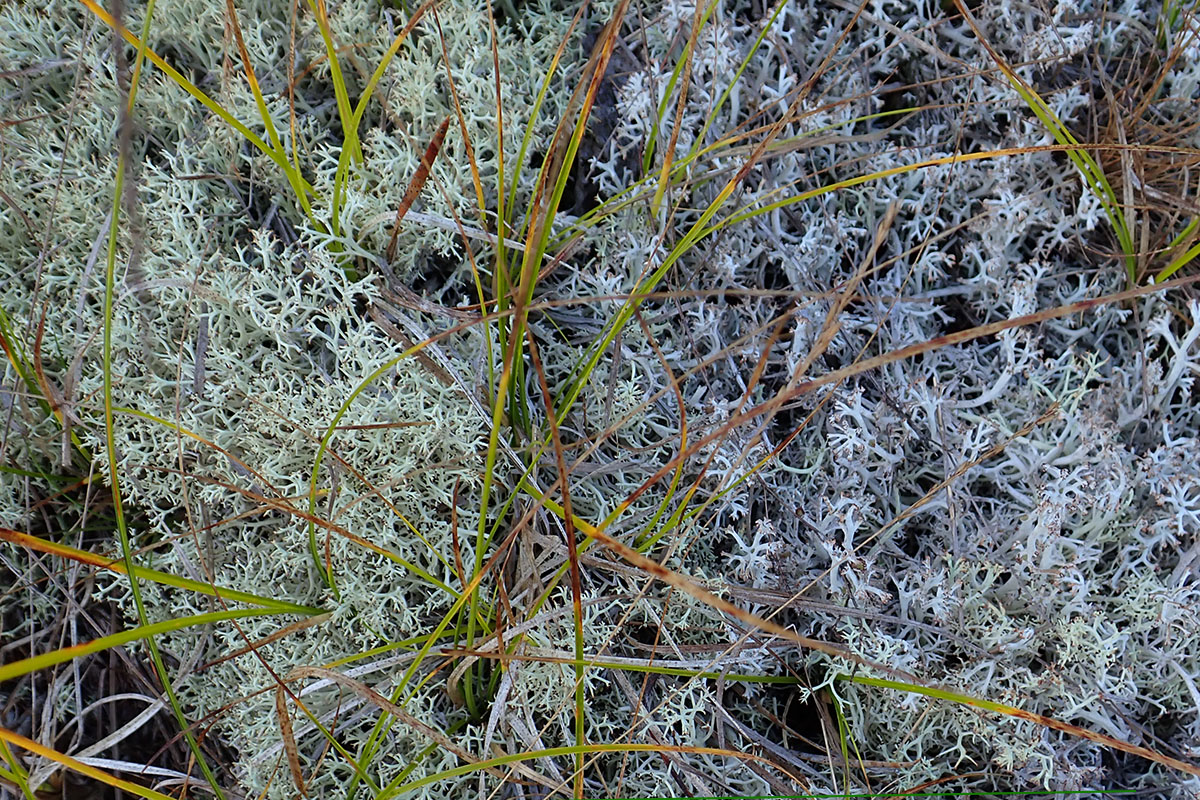
My list of "reindeer lichens" at Crane Beach has been accreting in a haphazard and iffy way. Things need review and revision. As one step in that process, I will show two of the principal varieties as they are growing, side by side. This follows a systematic review of authoritative references and re-examination of live specimens.
Here, the two lichen varieties are growing on sandy soil where there is a good amount of sunlight, intermingled with grass. In the sunniest locations, they often appear with beach heather; in shadier locations, with moss. They do not thrive in deep shade.
The gray variety (on the right) was named after the Linnaean genus Rangifera, which includes reindeer and caribou. Its gray color and relative thick stems distinguish C. rangifera from the pale green variety, C. arbuscula (on the left), with its finer and more intricate branches. It is also possible but seems less likely that the form on the left is Dixie reindeer lichen (C. subtenuis).
Can you eat reindeer lichen? Reindeer surely eat it. Sometimes people do, after treatment by soaking it in lye or boiling to remove its bitterness. Its nutritional value is open to question: a 1959 master's thesis reports (p. 140) that it is high in indigestible fiber, with small amounts of fat, protein, and ash. The ash minerals may include heavy metals and other toxins, notably in post-Chernobyl growth in Scandanavian areas. Wikipedia reports, "Northern peoples in North America and Siberia traditionally eat the partially digested lichen after they remove it from the rumen of caribou that have been killed." Presumably that preprocessing turns the cellulose into a form digestable by humans. – I haven't tried it myself.

Lichens of North America says little of the members of the genus Lecidea since "most simply look like black dots, and because much work remains to be done on their taxonomy." The Council of Lichen Herbaria (COLH) has rerouted searches for Lecidea varians to a new taxon, Xanthosyne varians. The authoritative paper cited there begins,
Lecidea varians is among the most common and abundant bark-dwelling crustose lichens in temperate eastern North America. As presently delimited, it is highly variable, including chemical and morphological diversity well beyond that currently accepted for most lichen species.
I believe it makes more sense to include the group here than to leave it out entirely. It is common and well-documented in this area, with the allowance for much uncertainty. Notably, one of the COLH images is very like the one I am showing here. So are the images by Stephen Sharnoff, rerouted to Xanthosyne sharnoffiorum. From the sanctioned specific epithet, one might reasonably suppose that he has some credibility on the matter!
The components are very small. Even with a dissecting microscope, I wish I could see more detail.
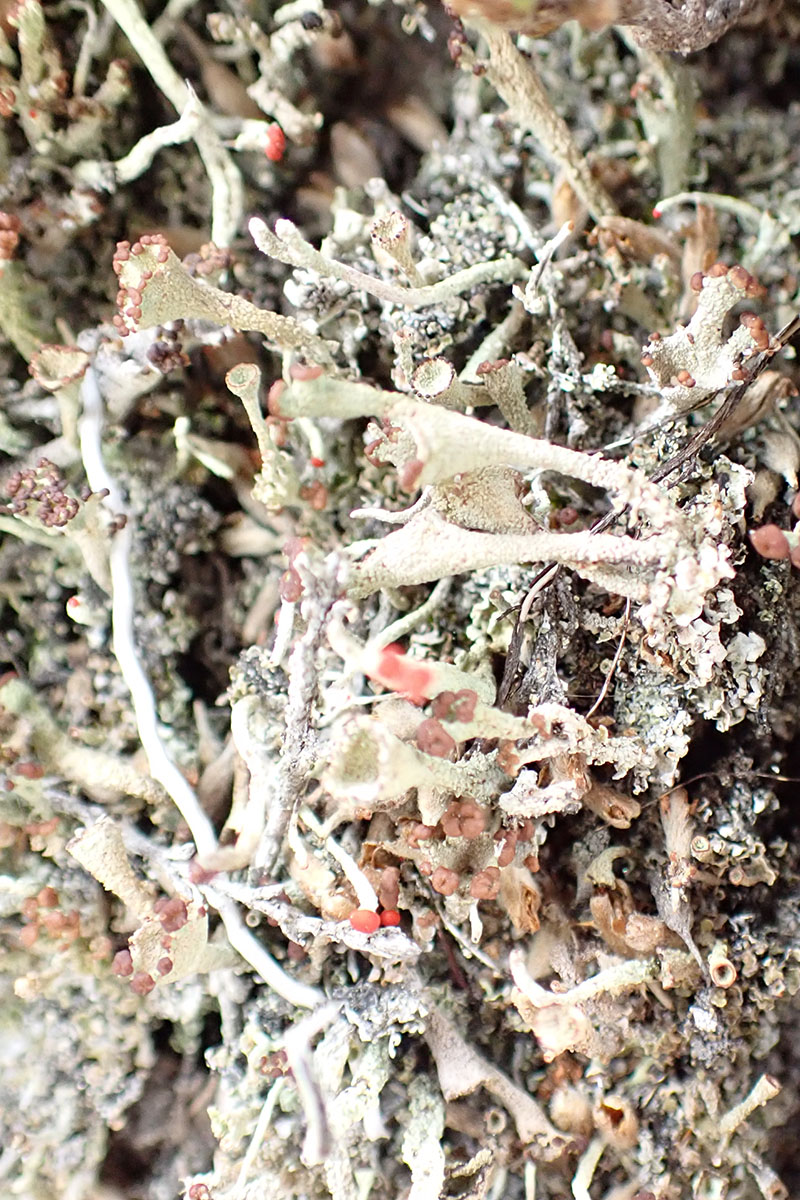
Early during my regular morning run yesterday, I cast a suspicious and disapproving eye on a wee lichen that I noticed in a sandy, open area along the trail. You're not supposed to be here, I thought; you're supposed to be off in the shade among the mosses and decaying wood. This needs investigation.
Sho 'nuff. Eventually I found my way to a manual reporting (page 148),"Cladonia pleurota… occurs on sandy soils in open forested habitats or along roadsides." My lichen had read its directions and the error was mine. I have added an member to my list: red-fruited pixie cup lichen (Cladonia pleurota).
There were a number of steps before I got there. The specimen is very small. The key point of there being clusters of red bodies around the edge of the cups is not visible to the naked eye. (You can see them if you enlarge the image.) And there are a few other local species that look very much like this one.
The authorities are not in total agreement on every detail – they seldom are! – but there is enough of a consensus to proceed.
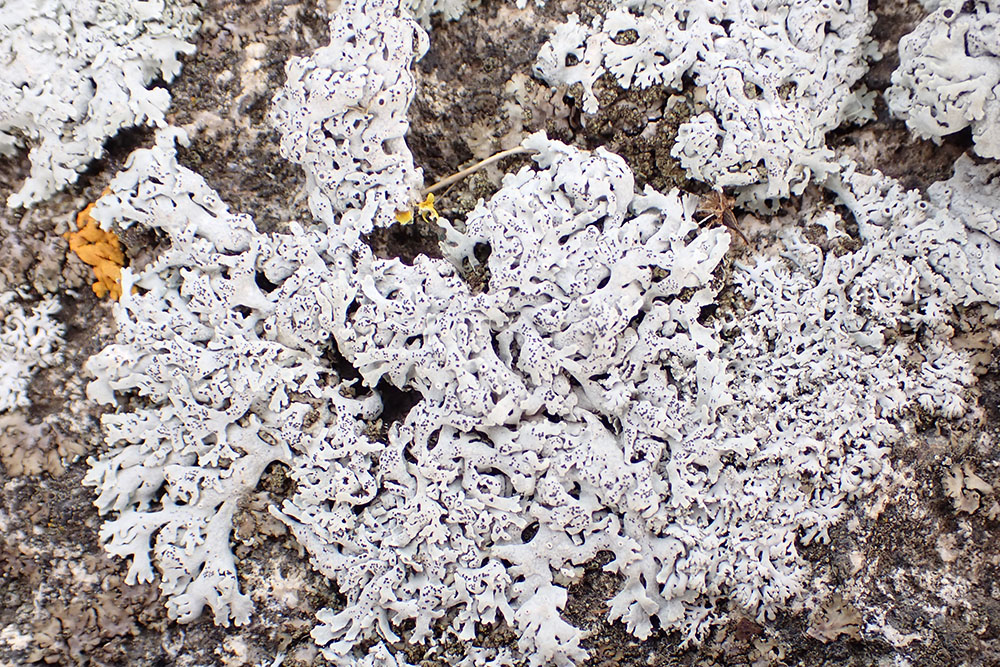
There are many star-shaped lichens that grow on stone. Like snowflakes, they get packed in and lose some of their shape when things get crowded. One of the more generally accepted species definitions is of slender rock rosette lichen (Physcia subtilis).
The various standard references agree on most but not all points. And to be sure, one genotype may have very different phenotypes. I have paid particular attention to an authoritative paper by Theodore L. Esslinger and to the book Macrolichens of New England. In particular, image E on from Figure 3 of the paper is a very good fit with my specimen. As always, the book is very useful and practical in setting out a finite number of realistic possibilities and noting key distinctions among them.
There are some other seemingly less likely but related identifications possible. The two references cover these nicely.

The sea is the last great frontier, for lichens as well as for other earthly matters. Lichenologists rarely even try to go beyond the littoral zone, the area between high and low tides. Even with that limitation, things are uncertain, contested, and steeped in deep technical details.
Yet clearly rocky beaches in this area are pervaded by dark and tar-like blotches recognized to be lichens. To provide at least a place for these, I will look to the most commonly cited taxa and do the best I can from their descriptions.
Wahlenbergiella (Verrucaria) mucosa is frequently reported. The British Marine Biological Association notes that it is "a thin, encrusting lichen forming bright bottle-green to dark olive green patches on mid shore to lower shore rocks. The thallus is smooth, oily or slightly irregularly cracked in appearance with a white edge around the margin. The thallus may be up to 30cm across. Small, black fruiting bodies are embedded in the thallus and become slightly raised when dry." (I am not including a separate image, but these bodies do become raised when dry.) Very frequently pictures show it next to barnacles.
I expect that I will revisit this post once I have a chance for further observation and learning.
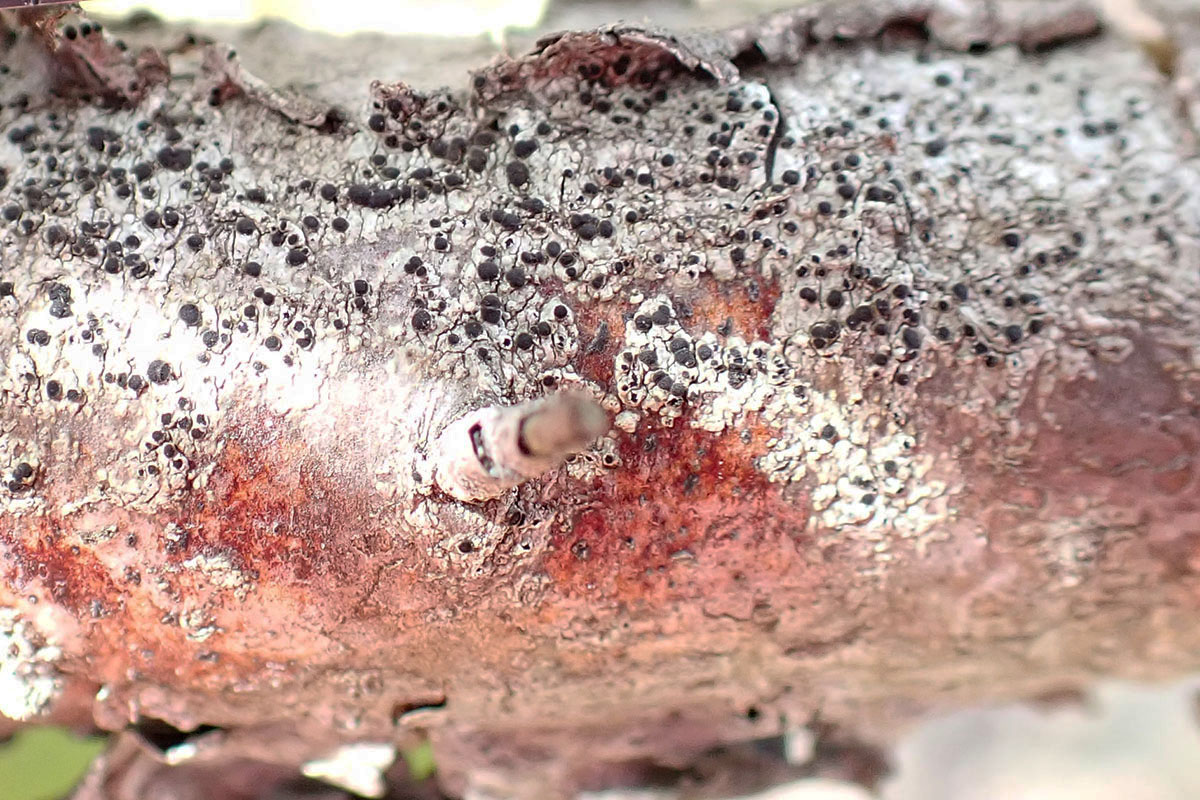
Gerry Island is, at low tide, accessible by foot across a narrow spit of land. When I looked at it on maps, it seemed a likely spot for lichens: a sturdy rock base, some trees and vegetation, and plenty of sunlight – but enough separation that it might harbor species uncommon on the mainland. I was not disappointed. I found a number of new varieties to puzzle over.
The taxonomy of the button lichens is evolving, as is my ability to work with what is already well-established. Those uncertainties acknowledged, I will tentatively identify this specimen as Amandinea milliaria. A key paper in this area describes the characteristics of A. milliaria:
Thallus [body] thin, light gray to light olive or a shade of light yellow-green, continuous or rimose [cracked], plane or more usually slightly rugose [wrinkled], matt… Apothecia [fruiting bodies] frequent and often contiguous, 0.30-0.50(0.70) mm diam, typically erumpent [breaking through] and broadly attached, then overgrowing thallus. Disc black, plane but may become convex… This species has been collected on the bark of … Juniperus virginiana [a juniper of the Northeast]…
All that seems to fit. Given the flux and my student's state of knowledge, I do want to review all of the button lichens I have noted here.
And I was fascinated enough by all I was seeing yesterday that I didn't pay enough attention to the rising tide, and ended up wading my way back to the beach at Marblehead. It was worth it.

Lichenology is full of rigor and detail. Still, sometimes at a glance I just say, "Huh! – that looks weird." So it was this morning with this thorn Cladonia (Cladonia uncialis). Amid all the squiggly acres of reindeer lichens of various sorts, it seemed not to fit with anything I'd identified before.
And it didn't.
All the details do check out with the literature: morphology, range, substrate. There is a confirmed observation of C. uncialis at Choate Island, also part of the Crane Estate, less than a mile away. And the edges of the samples are, appropriately, bright bluish white under an ultraviolet flashlight, a new and inexpensive piece of gear.
Anyway, I am happy that my gut reaction and the hard data seem to be in agreement.
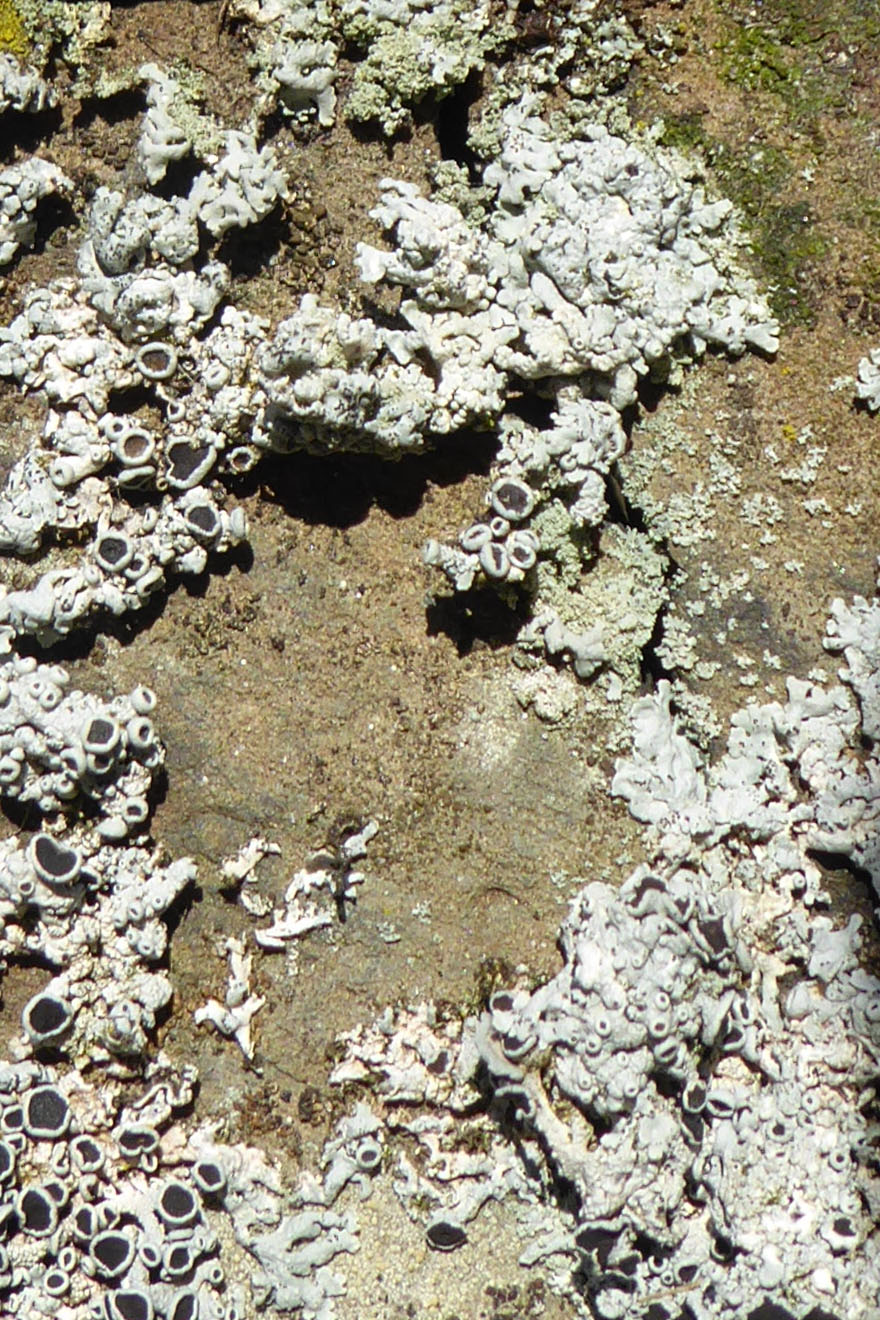
Star rosette lichen (Physcia stellaris), is common throughout this area of the country. Often, where it has room to spread out, it is star-shaped. The specimen shown here grew on a small branch of a scrub oak, an aged tree, so did not have much space open to it.
This post replaces an earlier one about which I had some doubts. I feel comfortable with this later identification, which relies heavily on the work of experts who have mapped the areas where this and similar species occur. That knowledge brings the possibilities down to a manageable number.

Lecanora lichens are generally thin white crusts. Usually, their reproductive bodies are visibly concave. However, in the fused rim lichen (L. symmicta) they are quite convex.
This post replaces an earlier one mistakenly identifying a different species as L. symmicta. It has taken me a while to accept in my gut that many lichens are very small. This specimen is another of the growths that I have passed by countless times without stopping to become aware of it. But I am happy to be coming to the awareness that I have now; I don't think I could have done that without missed opportunities and beginner's mistakes.
A few hours after the post above, I ran across a couple of reports of a look-alike, Xanthosyne varians, in this area. That is possible, though somewhat less likely, as far as I can tell. The literature on X. varians is very recent.
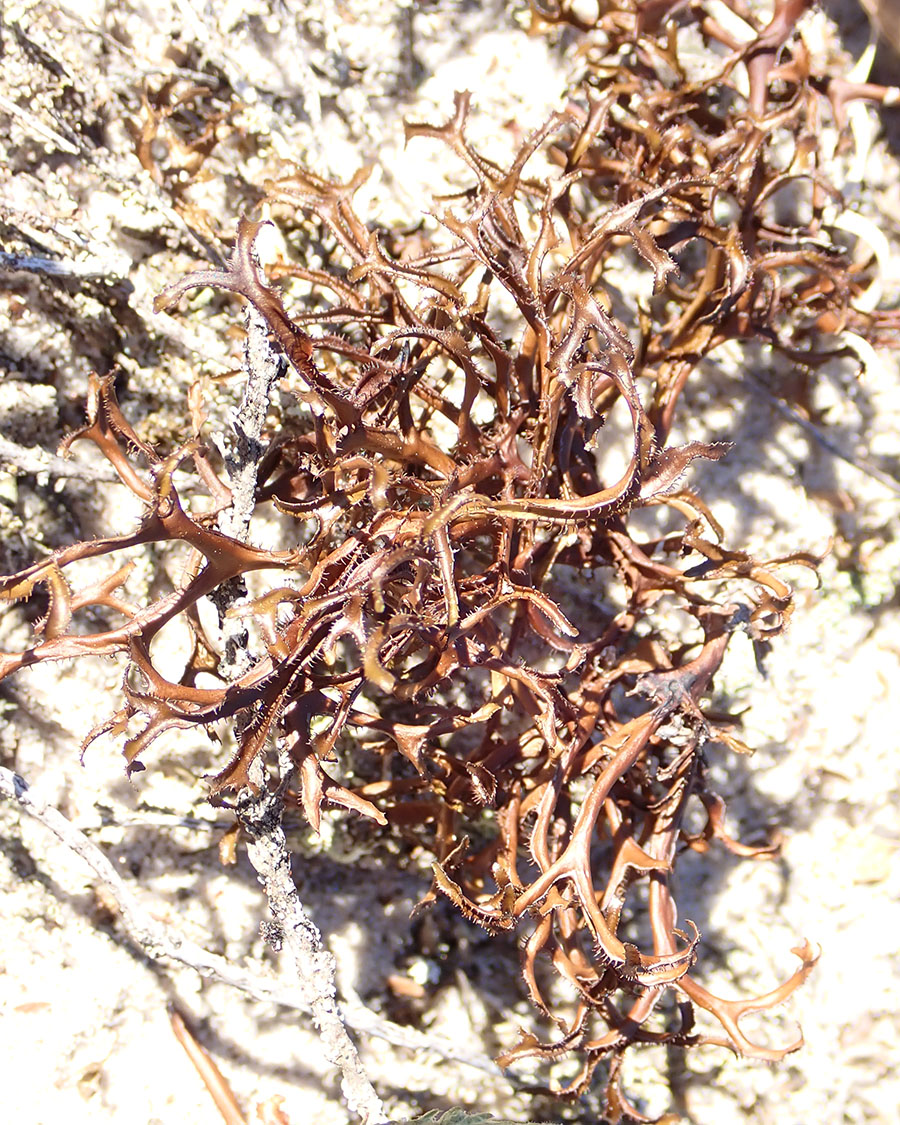
Sand-loving Iceland moss (Cetraria arenaria) is one of the small, inconspicuous lichens I have passed by unaware literally thousands of times.
The name is apt. The lichen often grows close to "reindeer lichen." Both thrive in sunny, sandy areas in colder climates.
I am indebted, once again, to The Macrolichens of New England for this find. The book turns enormous amounts of raw data into cohesive and graspable pieces.
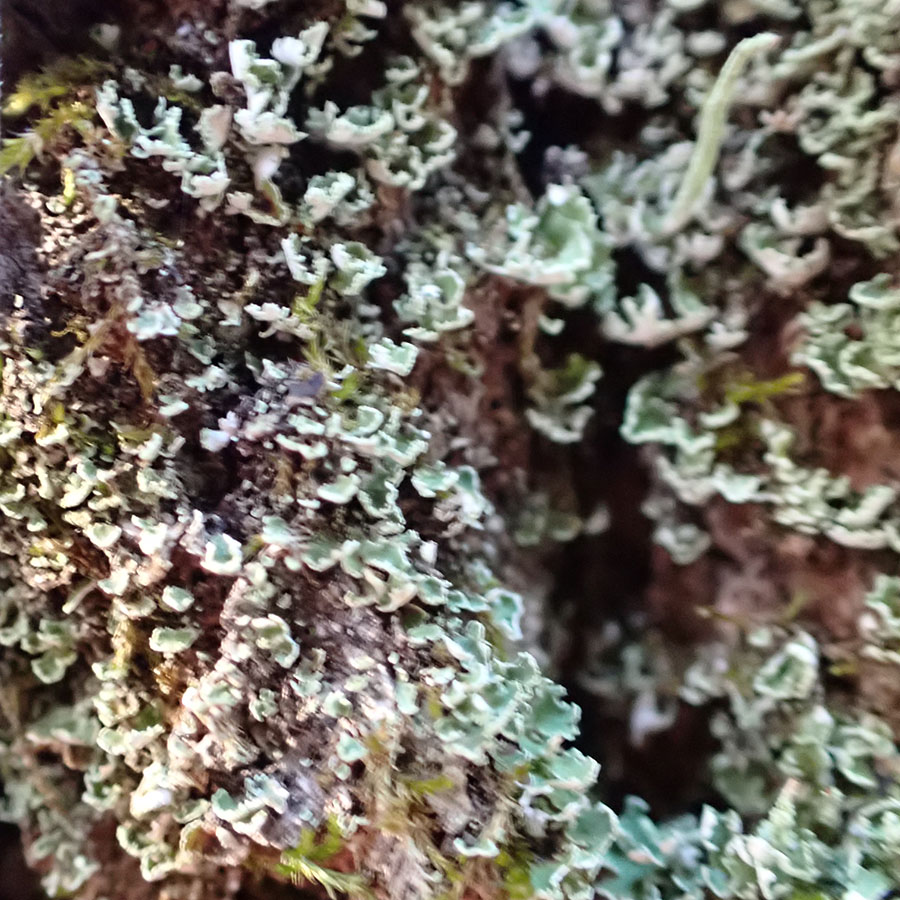
I am coming to find The Macrolichens of New England invaluable. It is aimed at people like me, whose interest is beyond casual but who do not have access to laboratory facilities. It brought me to this identification of stubby-stalked Cladonia (Cladonia caespiticia). The focus on New England makes the book much more approachable than the authoritative references of continental or world-wide scope. I pursued these once I found a starting point from Macrolichens.
Most of the members of the genus Cladonia have stalks, which take them to a size that is readily visible. C. caespiticia does not. It is a very modest, small presence. I noticed these only because I was looking at larger growths surrounding them.
Asbury Grove was established in 1859 as seasonal camp meeting ground for Methodist congregations from Boston and surrounding towns, a character it retains. It is full of picturesque cottages and buildings for community functions. It is a likely area for lichens, since it has cleared and sunny areas that fade into natural forests.
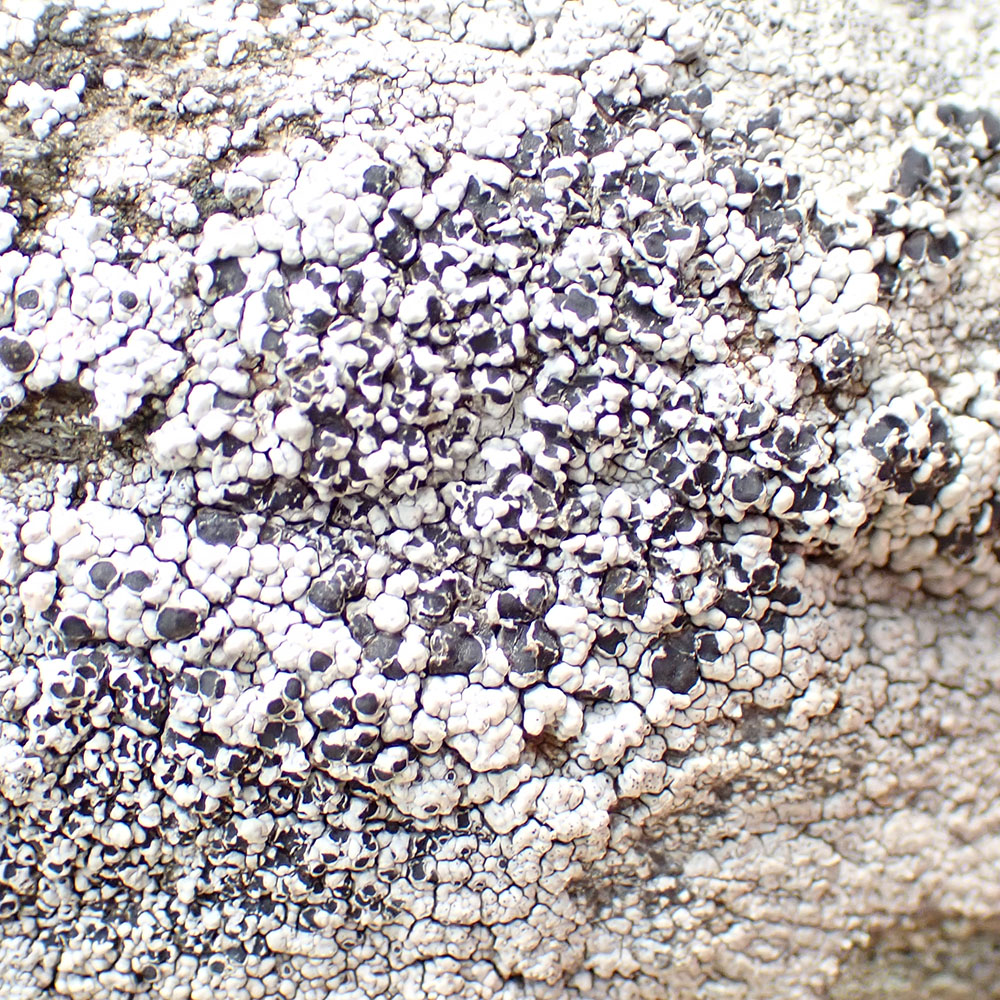
Distinguishing between different varieties of Aspicilia is generally a matter for the laboratory, especially because the fundamental taxonomy has some unclarity. Still, while noting that A. cinerea is rampant in this area, including growths inches away from this specimen, I will raise the thought that this sample may be A. verrucigera.
I will cite some of remarks from Lichens of North America:
Aspicilia verrucigera has a rather thick thallus that usually builds into curved and lumpy, sometimes worm-like areoles and contains stictic acid; it is one of the most common species of the genus, especially in eastern North America. Aspicilia cinerea generally has a thinner, less bumpy thallus. Like A. cinerea, A. verrucigera grows on granitic rocks in full sun, and the two species often grow as neighbors.
* * *
The discussion notes that A. cinerea stains red with potassium. The Council of Lichen Herbaria (COLH) agrees, adding the additional information that A. verrucigera stains yellow, as did my specimen
There are few records of A. verrucigera in this part of the state. I have found one in nearby Norfolk County in the Harvard Herbarium, another here in Essex county in the COLH data set.
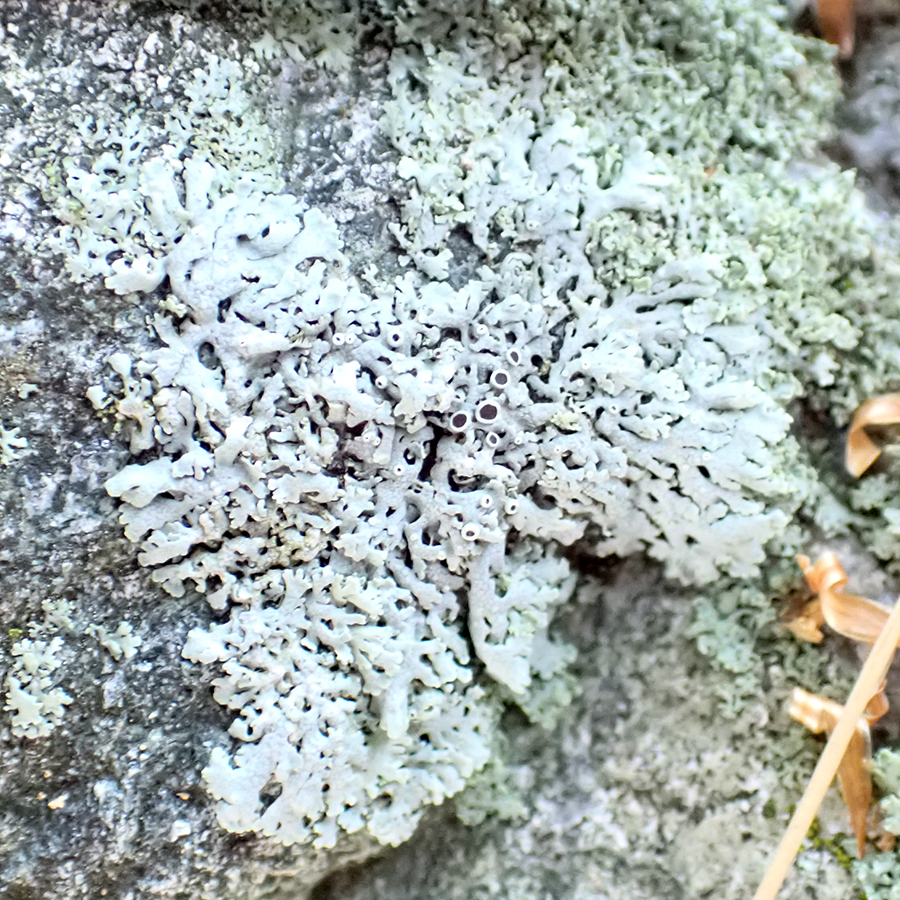
The name black-eyed rock rosette lichen (Physcia phaea) is descriptive. There are many different species within it, often looking almost like tiny doilies. Unfortunately, some of these closely resemble each other, so it is difficult to distinguish between them. To compound the ambiguity, expert descriptions contain some conflicts. In honesty, I change my mind quite a bit with this group.
I will follow the counsel of Macrolichens of New England: "Most Physicia species on rocks without soralia [powdery reproductive bodies] are this species." This specimen stained yellow with KOH. It underside is light-colored, as the Consortium of Lichen Herbaria shows. All in all, I feel reasonably comfortable about this call.

My identification of this sample as cow pie lichen (Diploschistes muscorum) is corroborated by various pieces of information, weakened by the absence of one significant feature.
It is from the Old Burial Hill in Marblehead, where experts Dr. Martha Allen Sherwood and Dr. Elizabeth Kneiper had previously identified and submitted to the Harvard University Herbaria other specimens of the species. The clumpy white morphology of mine fits the literature, as does its growth on moss. Its chemistry in spot tests is "K+ yellow to red, C+ red," as described by the Consortium of Lichen Herbaria. Finally, I see no likely alternative identifications.
The weak point is the absence of reproductive discs, which are shown in nearly all of the images of it I can find. However, an iNaturalist image rated as "Research Grade" is without the discs, and overall a good match for the picture shown here.
I must disclose that when I visited the Old Burial Hill, I was aware of the collection there of the Harvard Herbaria specimens. So, in a way it's like potting a sitting duck… but sometimes I go looking at reported locations of other samples and can't find them, and occasionally even feel that the reports were simply mistakes. I make many mistakes, but I don't have a monopoly on the commodity!

The pink earth lichen (Dibaeis baeomyces) is the last of my pre-identified priority lichen taxa to appear here. It is quite small, grows on the ground, and isn't necessarily pink. It doesn't jump out at you. No doubt I've passed other specimens countless times without becoming aware of them.
Curiously, yesterday I had tracked down a Harvard Herbarium August 1975 report of D. baemyoces in Mt. Jacob cemetery, Gloucester, where I had searched for lichens during the last week. I didn't notice at the time a 1979 listing of the taxon in Dogtown Common, two miles away, where I happened upon this one today. So, I drove past the cemetery on my way to Dogtown, and am only now finding the second Harvard Herbarium report.
It's partly luck, I guess, and partly that it's easier to find something if you have a mental picture of what you're looking for.

Oakmoss lichen (Evernia prunastri) is widely used in perfumery. It is widespread in Europe and on the West Coast of the United States.
After changing my mind a number of times, I have decided to include this observation here. On the one hand, I have found no reports of it in Essex County. On the other hand, the specimen is a strong morphological match for E. prunastri, and there are reliable reports of it 20 miles away in adjoining Middlesex County, in Wilmington. Further, the habitat is a cultivar, from an unknown location, a young locust with young lichens on it, now in my own yard. The growth of interest may have come along with the tree. Finally, I can find no viable alternative on lists of similar species. Pseudevernia cladonia is a look-alike, but of a different hue, with different reactions to standard C and KOH spot tests, and not reported close to this area as far as I can find.
E. prunastri is notable for its bushy form with strap-shaped lobes, yellow to greenish gray on the top, mostly white underneath. I am setting aside questions of reproductive bodies, since my own limited experience is that very small lichens are in a pre-fertility phase – although I can find no discussion of this topic in the literature.
There are other lichens in the image. The white area with discs is Lecanora, the leaf-like flat growths a shield lichen. I am not sure about the ruffly forms in the upper right.
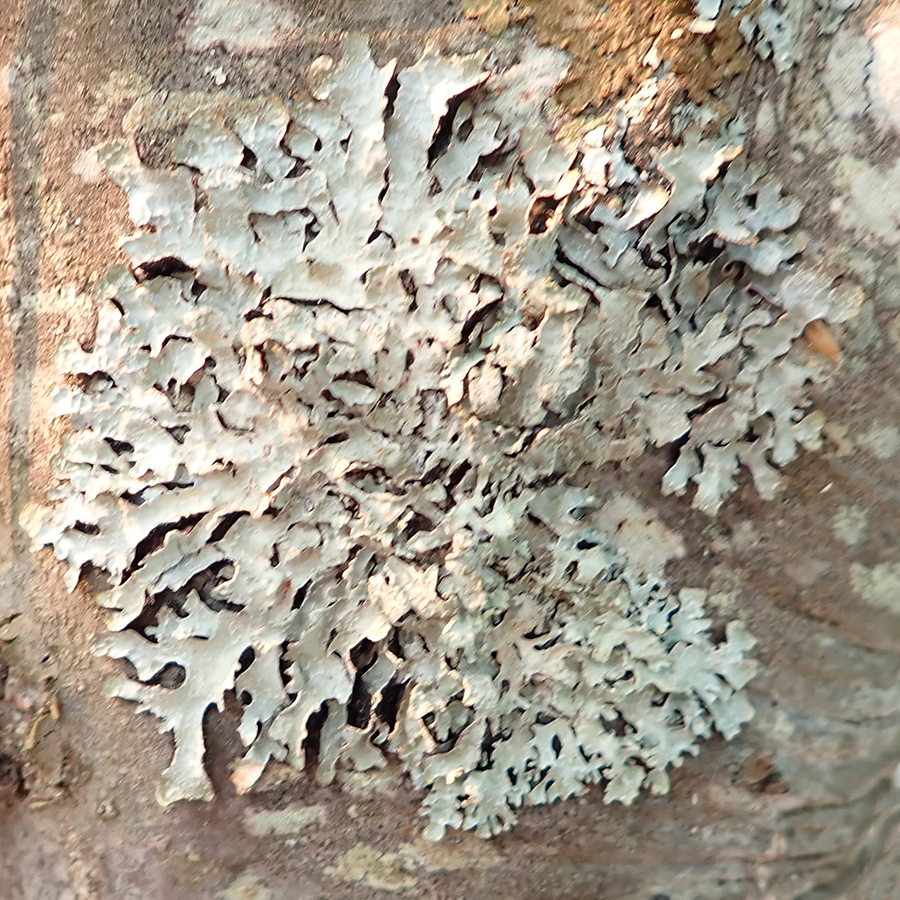
It took me much longer than it should have to identify this specimen of hammered shield lichen (Parmelia sulcata), which I go past on most days. Indeed, I was conscious of this conspicuous gap in my identifications.
I might plead as an excuse that P. sulcata is quite a bit smaller than its more extravagent cousins. I was looking for something bigger. Pictures are very good, but they should be presented with some indication of size. I take my photographs with a centimeter rule at the edge of the frame, and then crop that out.
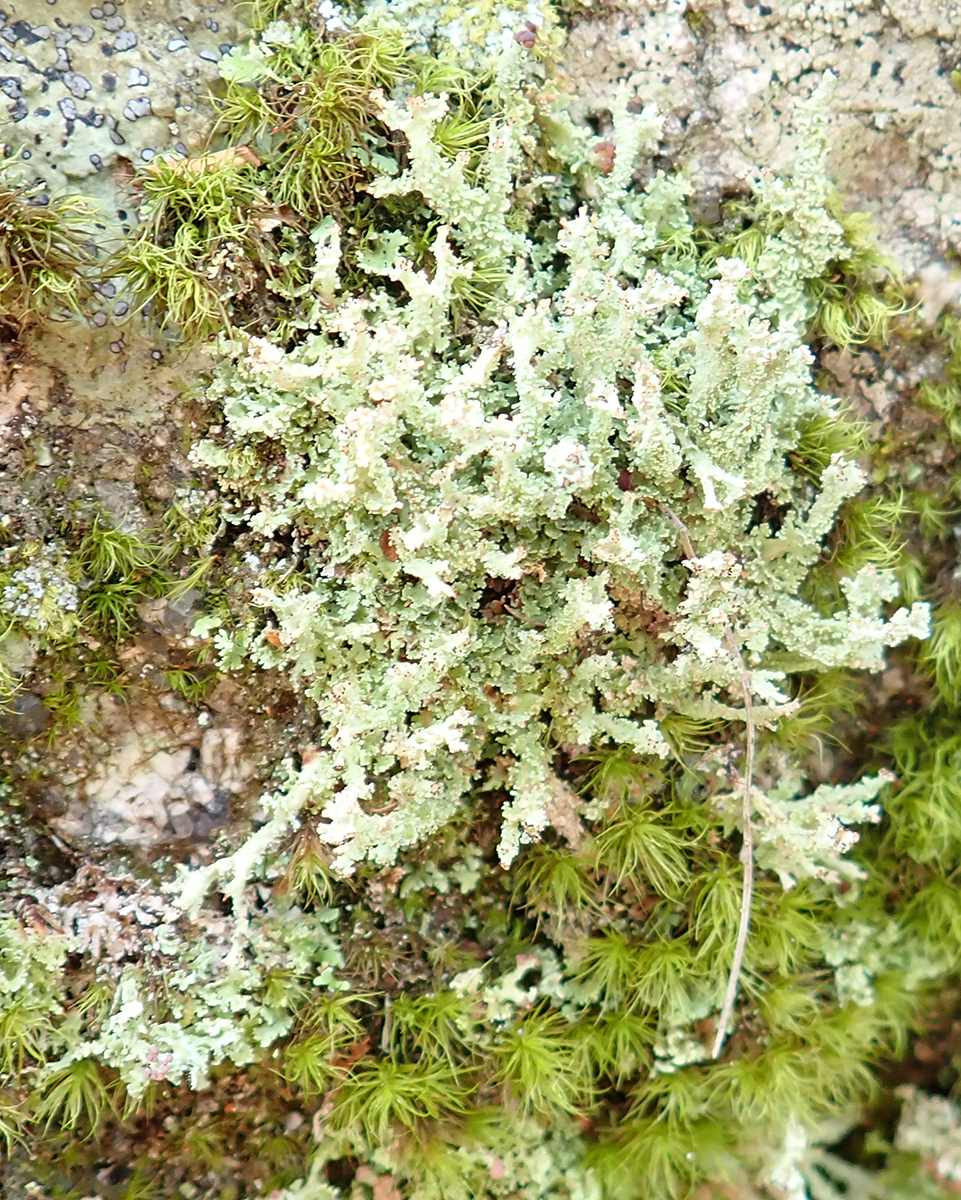
I am gradually growing more confident, appropriately or not, in making identification calls outside of the list of usual suspects in this region. Partly this comes from gradually improving understanding of lichen anatomy, partly from learning how to broaden my sources of information, with their various strengths and weaknesses.
So it is with Cladonia squamosa, with English names including dragon cup and dragon horn. INaturalist has a couple of records in Gloucester and adjoining Rockport. The Harvard Herbaria has other nearby reports, many of them over a century old. The amazing technology of modern photography adds good corroboration.
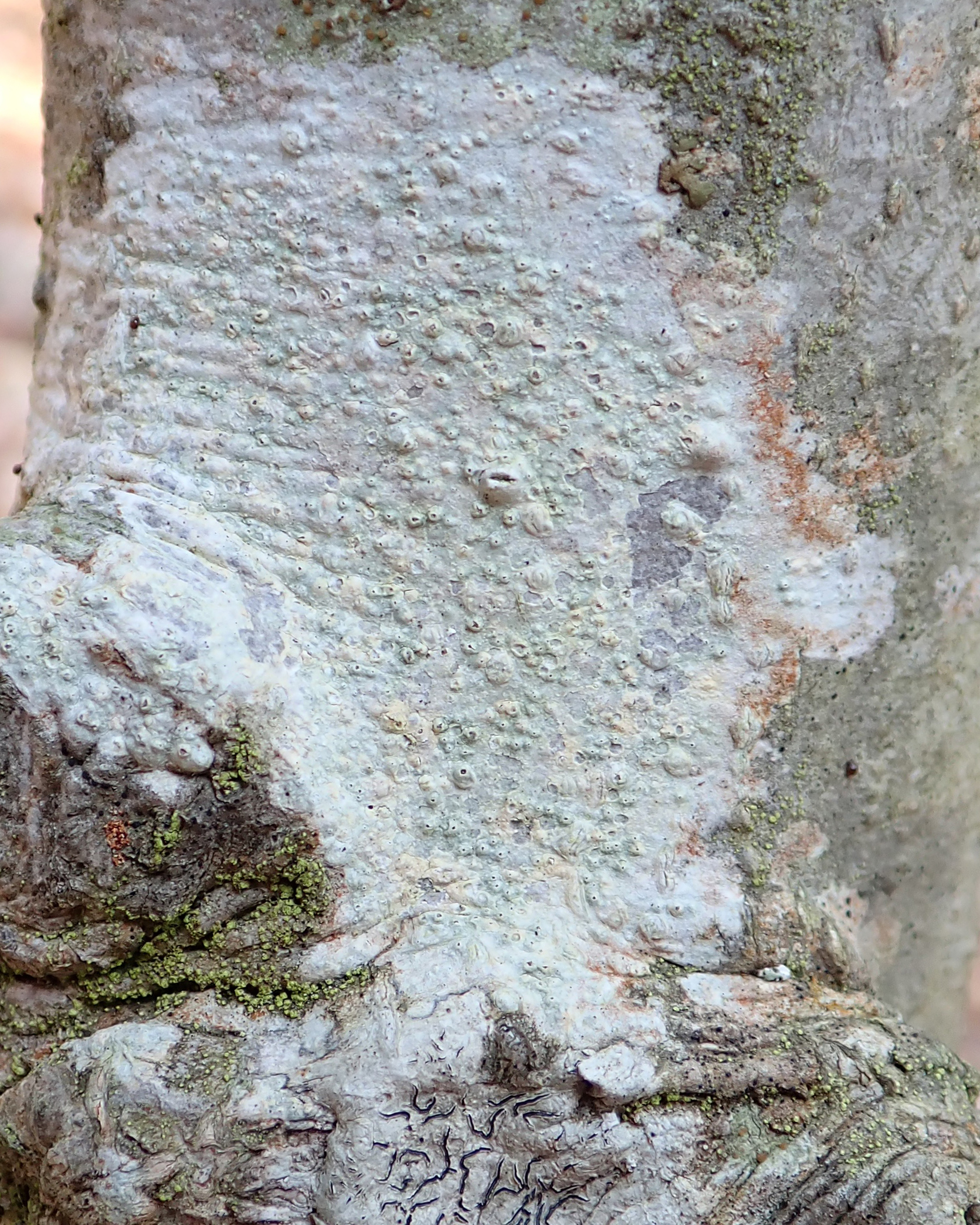
It is easy to see how the volcano wart lichen (Pertusaria xanthodes) got its common name: it has a bumpy surface that is rather like warts with depressed pits.
The Dogtown area of Gloucester appears frequently as a source of specimens in herbaria collections. It is a fertile ground for lichens. There are massive deposits of granite there, home to many stone-dwelling varieties. Much of the area was cleared long ago, letting in the sunshine that lichens need for photosynthesis. Trees have taken over again, but not as a dense primeval forest with Stygian darkness below.
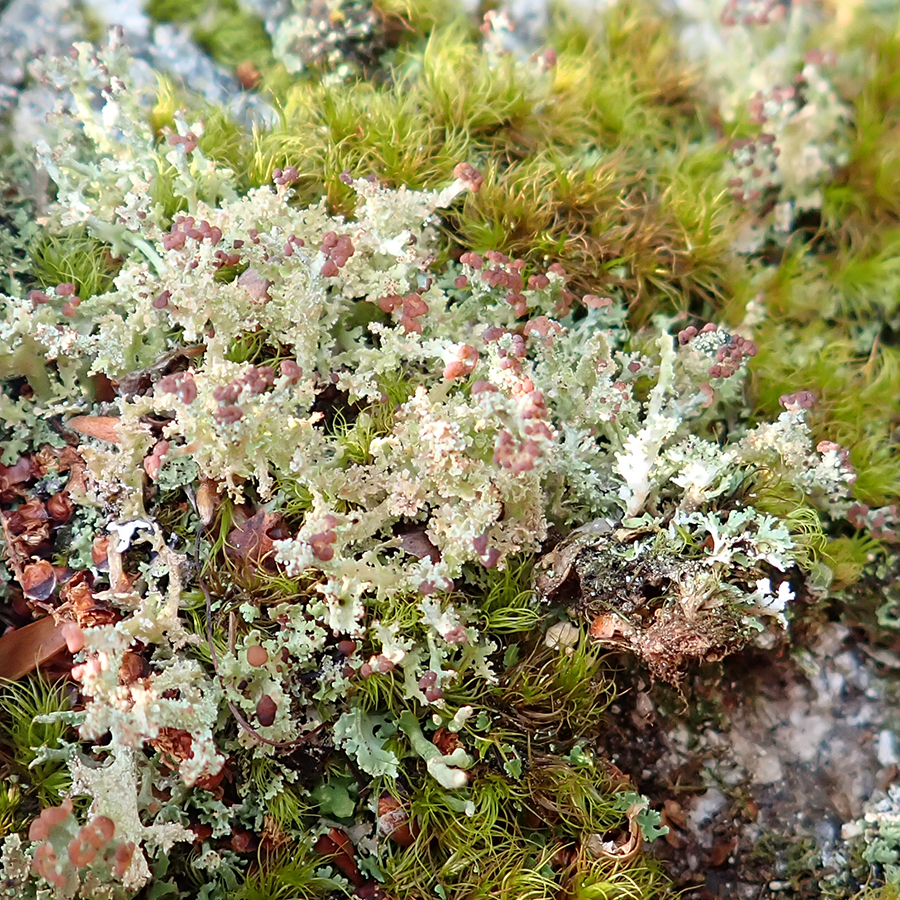
Lichens of North America remarks of Cladonia cristatella, "The British soldiers lichen is perhaps the best known lichen in eastern North America." That would be my impression too. A trusted staff member at Crane Beach, where I go very often, named it first in a list of lichens there. Somehow, though, I have been unable to find a growth, though I have been looking for months. They are not large or conspicuous. I must confess I found this group only because my eye was caught by a larger growth of Cladonia squamosa.
I have found that one of the biggest joys in this pursuit is acquiring the ability to recognize things I've walked past a thousand times without any heed at all. So it was with this specimen. I was very glad when the red-capped stalks finally caught my eye.
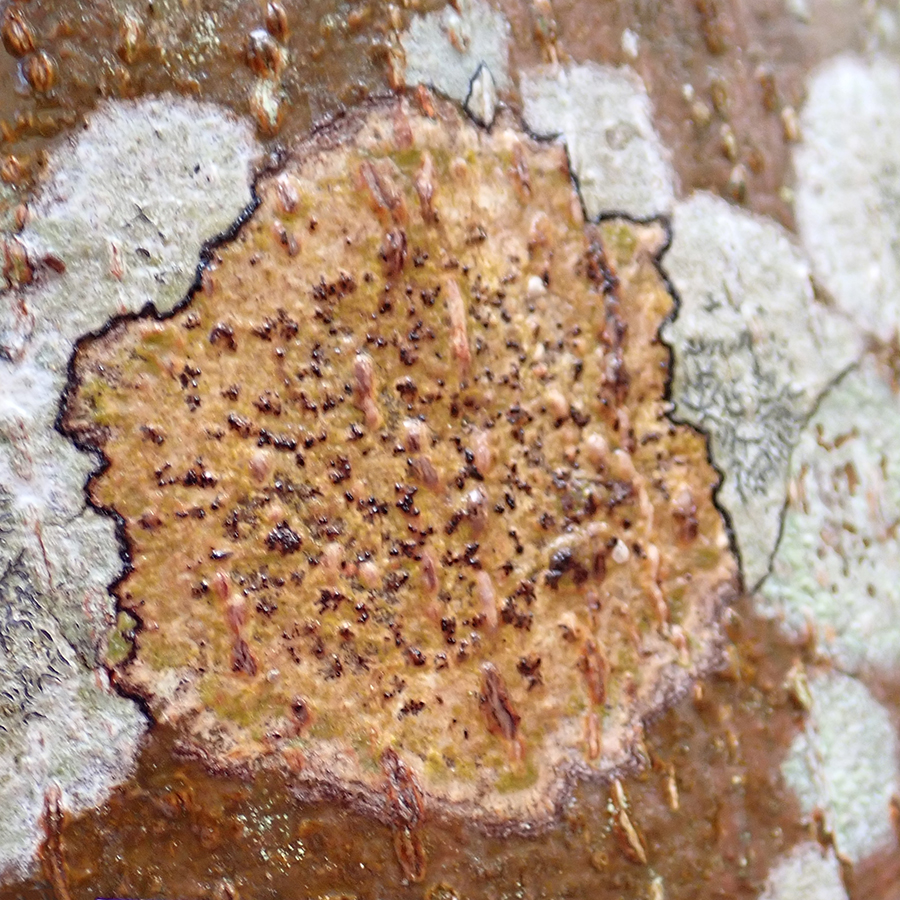
The image showns the Eastern pox lichen (Pyrenula pseudobufonia) shortly after a significant rain, very wet. It is in the area of Dogtown in Gloucester, settled very early but abandoned and now conservation land.
It is curious that this taxon does not appear on any of the three sources I have drawn on for my short list of local lichens. Lichens of North America comments, "This is one of the most common bark-dwellling lichens with perithecia." The Harvard Herbarium includes an 1890 specimen from Magnolia in Gloucester, as well as a 2003 specimen from an unknown point in surrounding Essex County.
Species identifications including P. pseudobufonia are discussed in a 2016 expert paper.
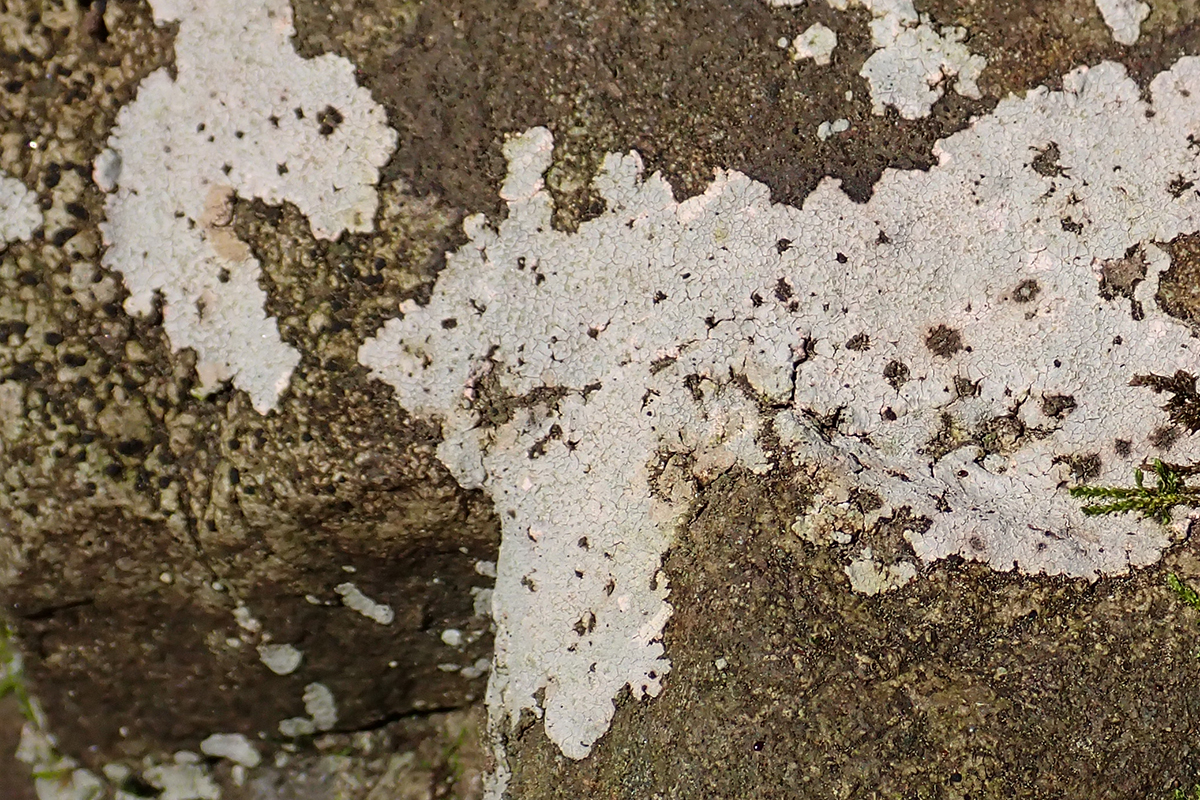
Rock whitewash lichen (Phlyctis petraea) was first provisionally named in 2005 and formally delimited in 2017, though it has been collected and studied for a century by now. The introduction to the key study is worth quoting:
Sterile crusts still present a taxonomic quandary as they frequently lack, and in some cases never possess, many of the common diagnostic characters present in sexually reproducing lichens ( e.g., ascospores and apothecia). Historically, familial and generic placement was limited to finding a rare sexually reproducing individual, or informed by gross morphology, chemistry, photobiont type, distribution, or habitat.
P. petraea is often found "in dark, moist overhangs" of stone, as is the case with the specimen pictured here. The description in the paper, "rimose with conspicuous schizidia (Fig. 4C)," is quite technical but directly on target. I certainly have learned that lichens that look like blotches of white paint on boulders are far from easy, as the article notes, but feel that this identification is a reasonable one. I spent some time going over the details, including Figure 4C, learning in the process.

I will make a tentative identification of this specimen as whitewash lichen (Phlyctis argena), pending results of chemical testing. Its morphology, substrate and frequency are a very good match for authoritative technical descriptions and images, but I want to be careful since there are so many similar-looking white lichens.
Wikipedia notes, "Phlyctis argena has a thin crustose thallus that is white, greyish or green-grey in colour. The identification can be confirmed with the spot test application a drop of potassium hydroxide (K-test) to the thallus, which will turn yellow and then red."
I am learning: first, that it is useful to go beyond my initial short list of the most common lichens in this area; and second, that an inexpensive container of KOH would help me answer specific questions, not just be a piece of lichenology paraphrenalia that I wouldn't actually use.
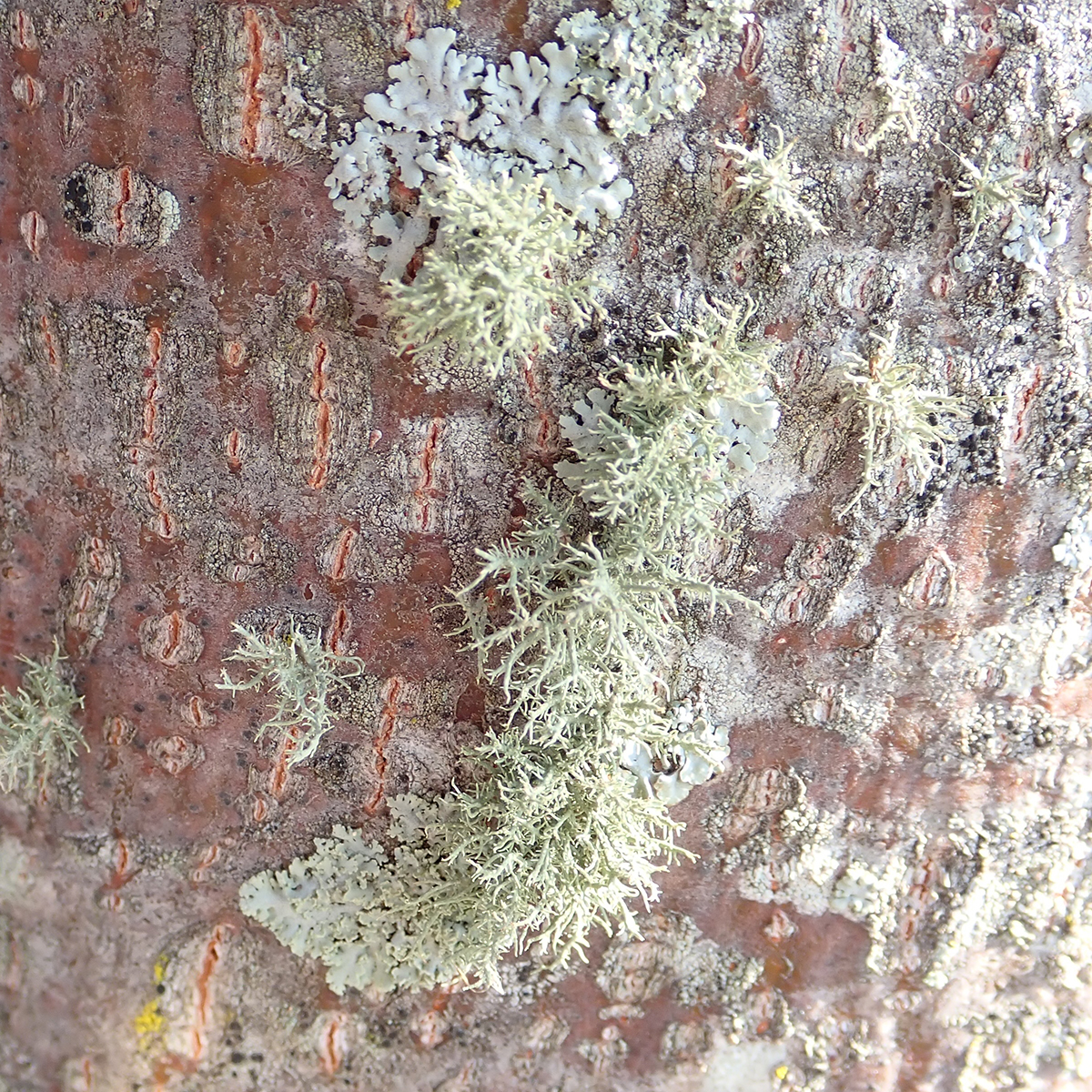
Beard lichens are one of the first varieties many people may pay attention to, including me. If they're not warm and fuzzy, they're at least fuzzy.
The specimens here are growing on the bark of a young linden tree, a cultivar planted at Appleton Farms. Like their host, the these growths are young and small. There are other lichens in the picture as well.
I have found this group of species confusing and have changed my mind a few times about which thing is which, and I may again. My current best belief is that this specimen is Usnea mutabilis, commonly called bloody beard lichen.
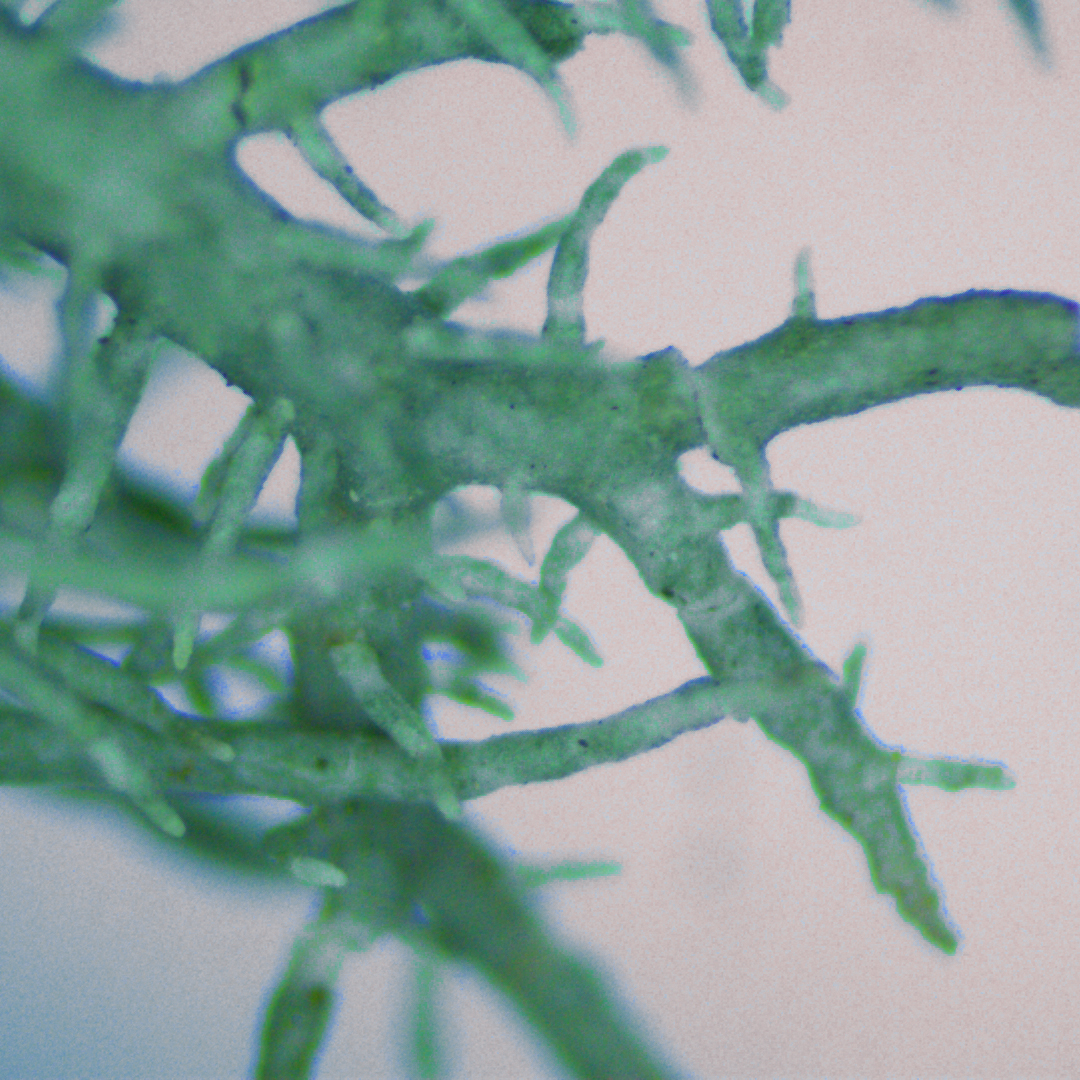
Wikipedia reports that U. mutabilis "is a grayish-yellowish pale green, unequally branching, shrubby… commonly anchored on holdfasts on trees, mostly in eastern North America … The thick axis and medulla are dull red." You can see red tints in the microscopic enlargement of a bit of the growth.
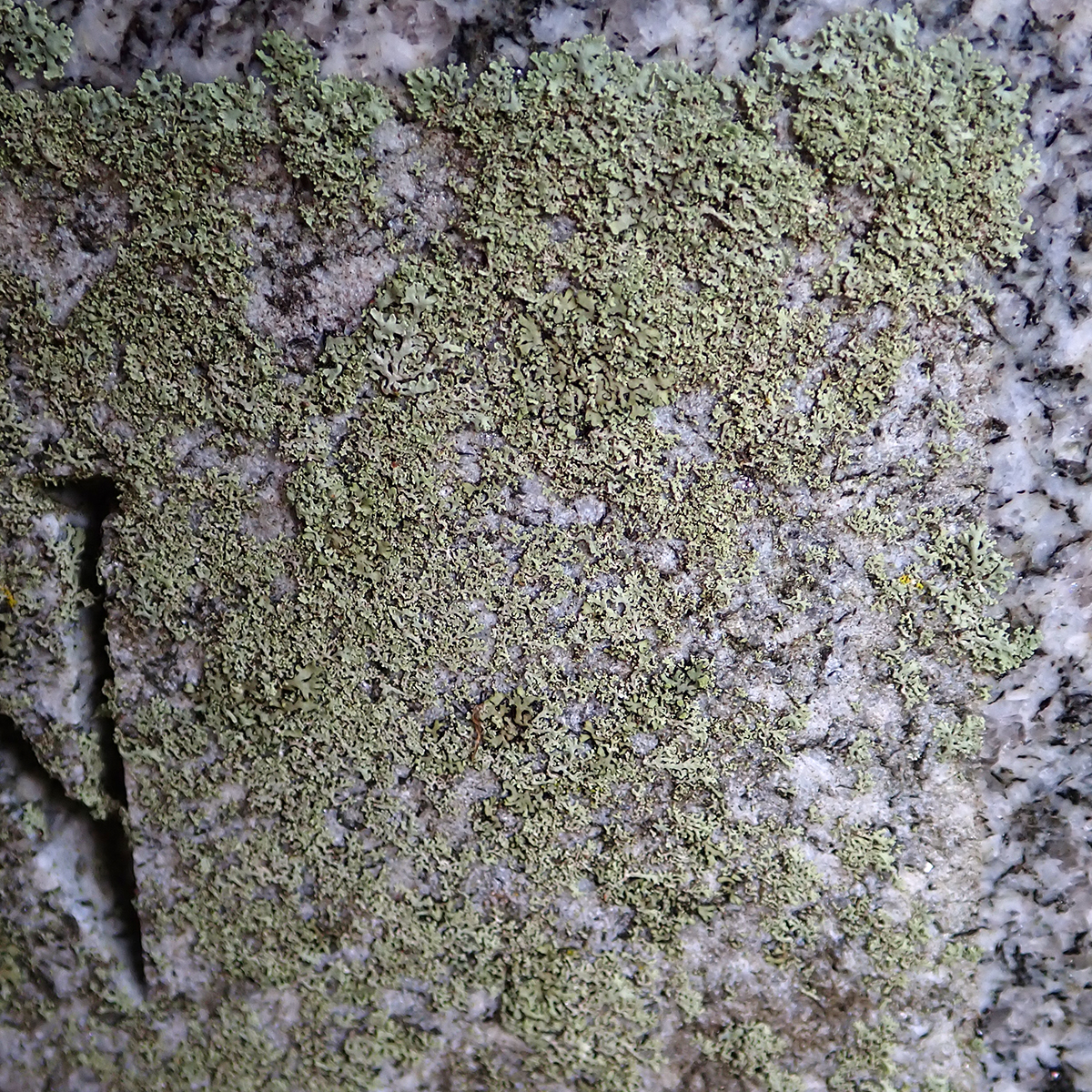
The stalkless cladonia – or stalkless cup – lichen (Cladonia apodocarpa) looks much like several other members of its genus, including the common powderhorn lichen – but without the powderhorns. The second part of its scientific name is formed after the Greek άποδος (footless) + καρπός (wrist). Its bodies are small, looking at a casual glance something like a fuzz or powder. But on closer look, they are of leaflike ("foliose") form, not flat ("crustose").
Perhaps because it is so unassuming, the name of C. apodocarpa does not appear on some local lists that I use. It is, however, quite common. This taxon is unusual among the Cladonia in colonizing hard stone.
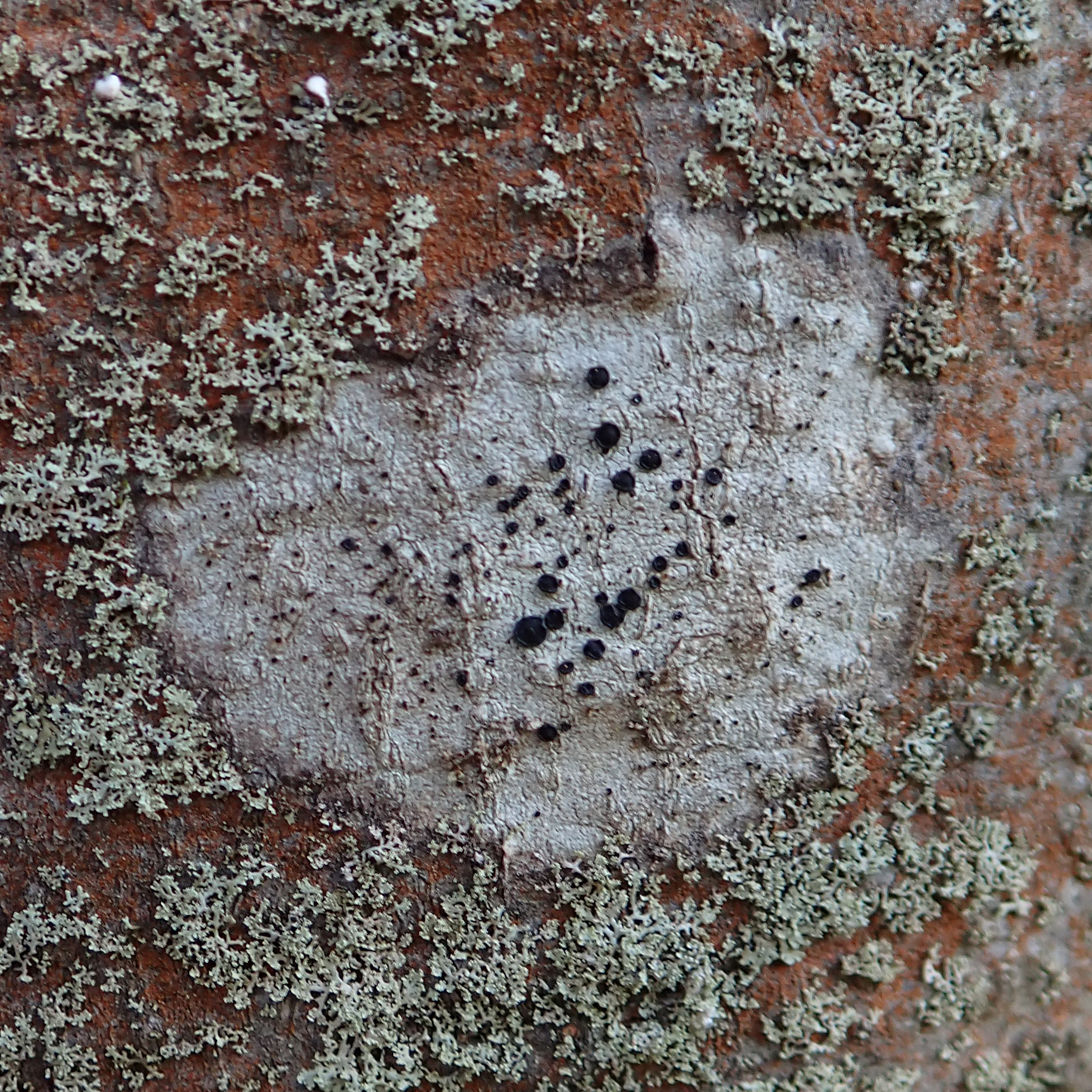
The appearance of this specimen is a good visual match for the common button lichen (Buellia erubescens). As the English name indicates, B. erubescens is common and reliably recorded as present in the Town of Hamilton, less than a mile away.
My recollection was that it was on an ancient beech, but unfortunately, I was careless in my record-keeping and my photographs did not resolve the key question of what this sample was growing on. In a return visit, I was pleased to be able to find the tree again from GPS coordinates and confirm my recollection. Moreover, with a drop of recently acquired potassium hydroxide, I was able to confirm the staining pattern of a dull yellow to red-orange. Replicability and corroborative evidence are key things in science!
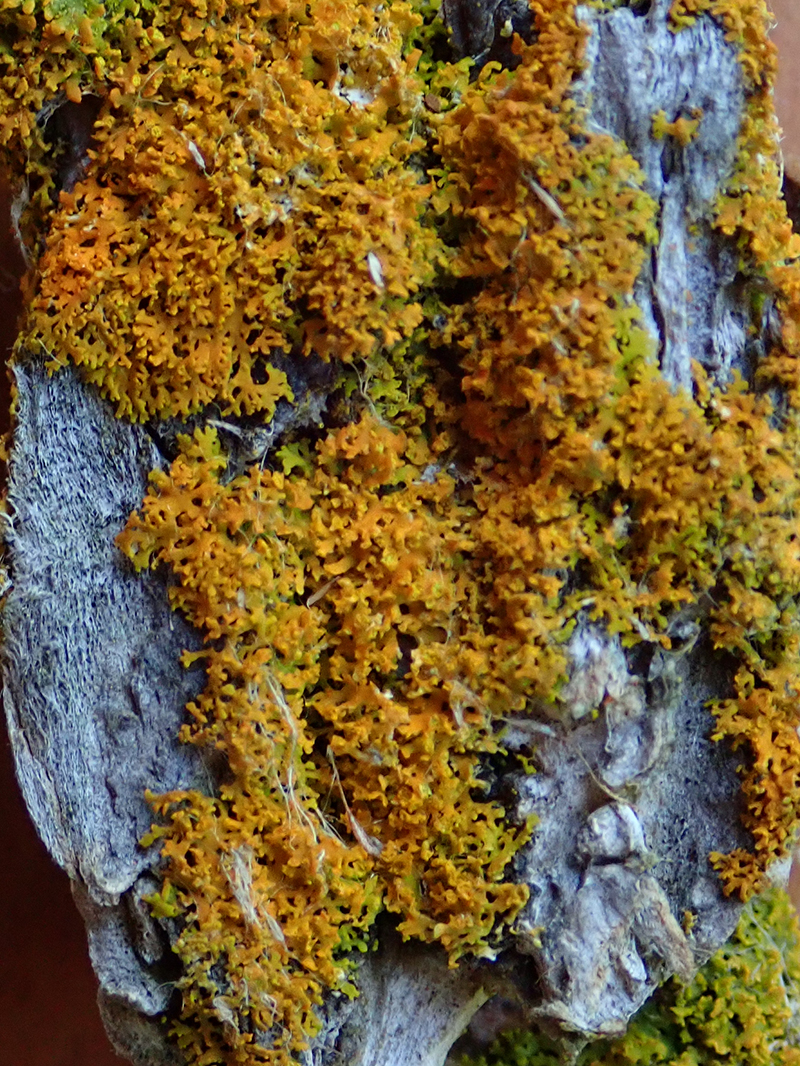
The Consortium of Lichen Herbaria notes, "Xanthoria candelaria [now redirected to Polycauliona candelaria] is a very variable taxon occurring on a wide variety of substrates, and it is in need of taxonomic revision throughout its distribution area." The specimen shown here clearly fits into the range of phenotypes shown by COLH.
In autobiographical mode, I will note that my lichenology skills are slowly but definitely improving. I was readily able to recognize this smallish orange growth on the edge of Appleton Farms as something that I had not looked at before, and in followup to identify its classifiation with modest effort. Unfortunately, the autofocus mode of my recently acquired pocket camera is unable to cope with closeups in bright sunlight, and manual focus is impractical because the viewfinder image is not visible in that situation. Fortunately, I had managed to secure a sample of this colony and brought it home, where I was able to take pictures including the one you see here, using the same camera.
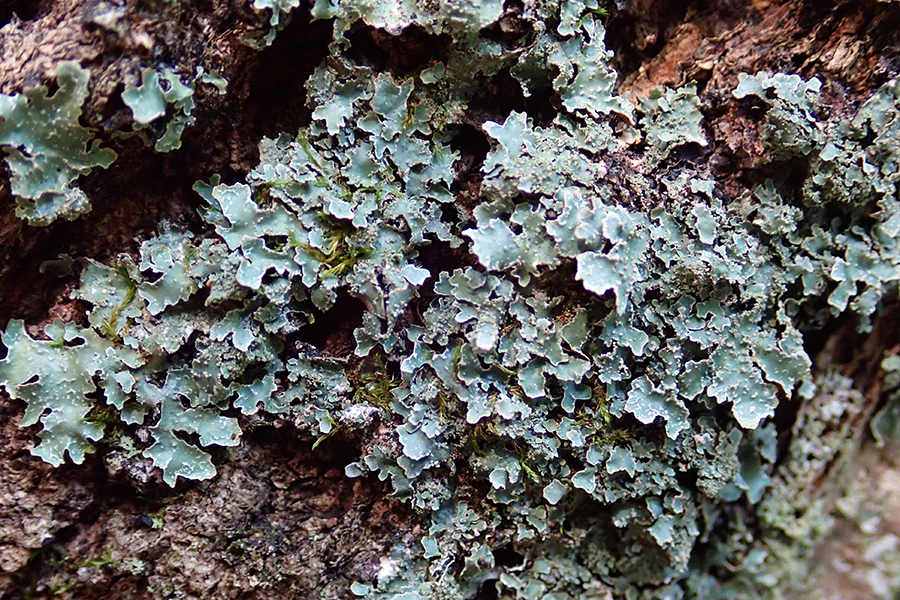
Rough speckled shield lichen (Punctelia rudecta) is a medium-size lichen with leaf-like lobes. It is common on trees and mossy stones in this area. The individual lobes are about the size a finger-tip, but join each other in clusters that may be of some size.
The shapes seem like much smaller versions of common shield lichens. Especially at the beginning of this pursuit, I would often look at a small growth and wonder, is this a baby state of something I already know, or something else entirely? I am slowly getting better at figuring it out. The lichen texts I have found, curiously, are silent on early and end of life phases.
* * *
December 9: It is possible that this specimen belongs to a species fairly recently named, Punctelia caseana. Figuring that out will be matter for another day.

There is much that's unsettled and unclear about the genus Lepraria, commonly called dust lichens, and similar species. Their members are very small and do not reproduce sexually, leaving them unamenable to common approaches of lichenologists. It's not even agreed whether key taxa are present in North America.
After spending a while looking at the situation, I am withdrawing a previous post, at least for the time being, not necessarily because it was wrong, but because it does not reflect a current consensus. That consensus does not exist. This was about the zoned dust lichen, L. neglecta. I have left in place the post for Fink's dust lichen, L. finkii, which seems a key and fit placeholder about its topic until the dust settles, so to speak.
This brings us to Lepraria incana. On the one hand, the Council of Lichen Herbaria, whose lead I generally follow, is silent on the topic. Fools rush in where angels fear to tread! On the other hand, there is an highly common and widespread powdery white lichen that had been known, at least until recently, as L. incana, the last part of the name meaning "hoary" or "gray."
So, I am including L. incana because it at least gives a presence to an extemely common lichen, whatever its future name(s).

Chrysothrix candelaris is one of the genus of gold dust lichens. The appearance matches the name. This image tends more toward the green than the small sample I brought home with me. I could "correct" the picture by shifting it to a more yellow color balance, but I am careful to avoid such practices. (I have made the image a bit brighter, which seems reasonable because the growth was in rather deep shade.)
This specimen is at the Bald Hill Conservation Area in Boxford. I have not found specific records of this taxon in Essex County, but it is widespread throughout the region.
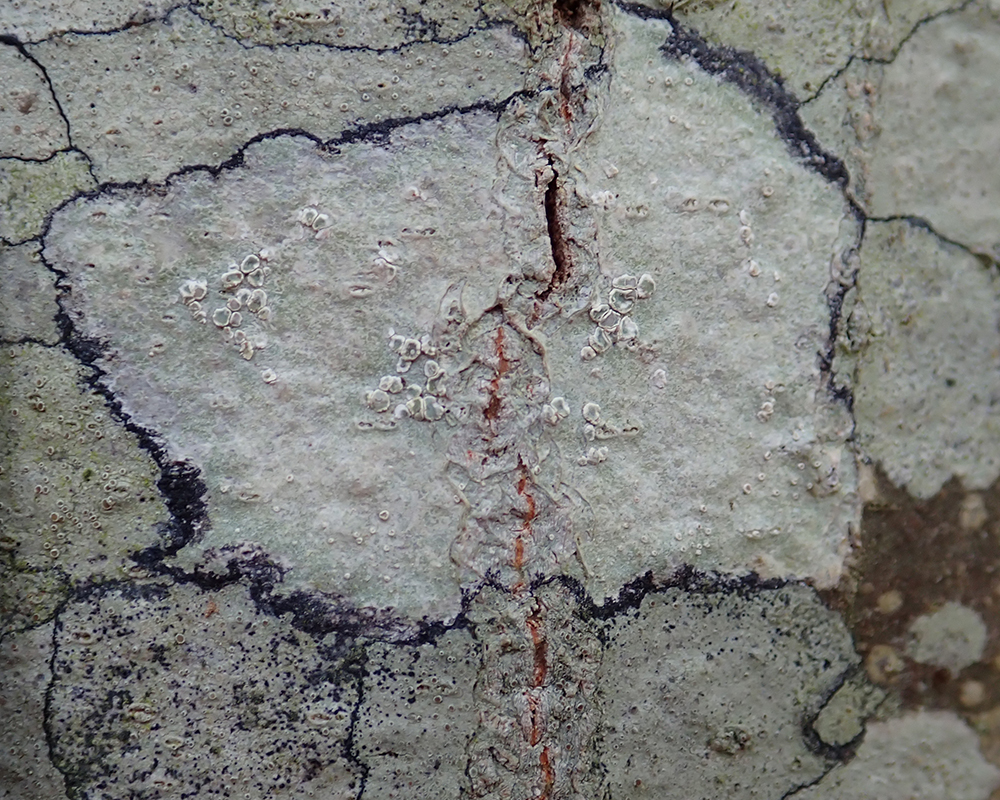
Pertusaria pustulata is not as common as dandelions or crabgrass, but it does have a documented presence in Essex County in a habitat like the one where I found this specimen. Its appearance closely matches authoritative illustrations for this taxon.
I am not 100% sure about this call. I am leaning toward adding a small bottle of postassium hydroxide to my test chemicals, now limited to household bleach. That would cost me $16.95 plus sales tax. It would not definitively resolve this question, or others, but it could provide corroborative evidence for, or nearly conclusive evidence against, this particular identification. – Such things start to make more sense as I learn more and am able to identify specific questions and distinctions.
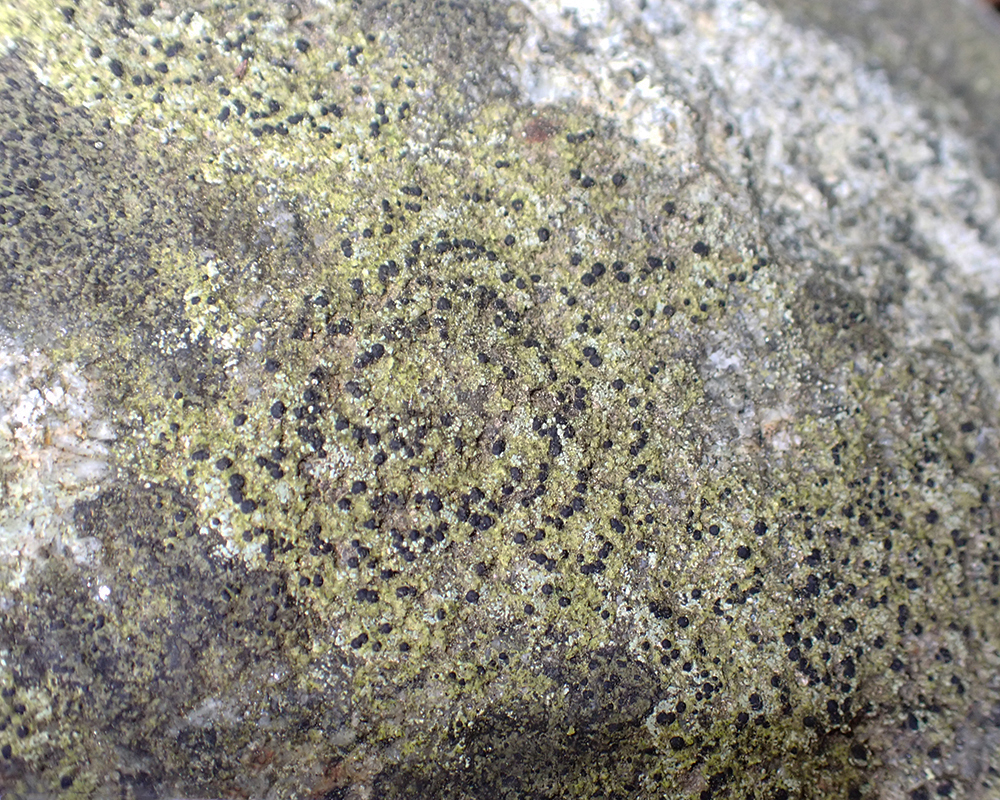
Leimonis erratica, even more than most lichens, is variable in its appearance. Here, there are concentric whorls of black bodies in an eye-catching pattern, with a background in some places greenish tan, in other smoky in hue.
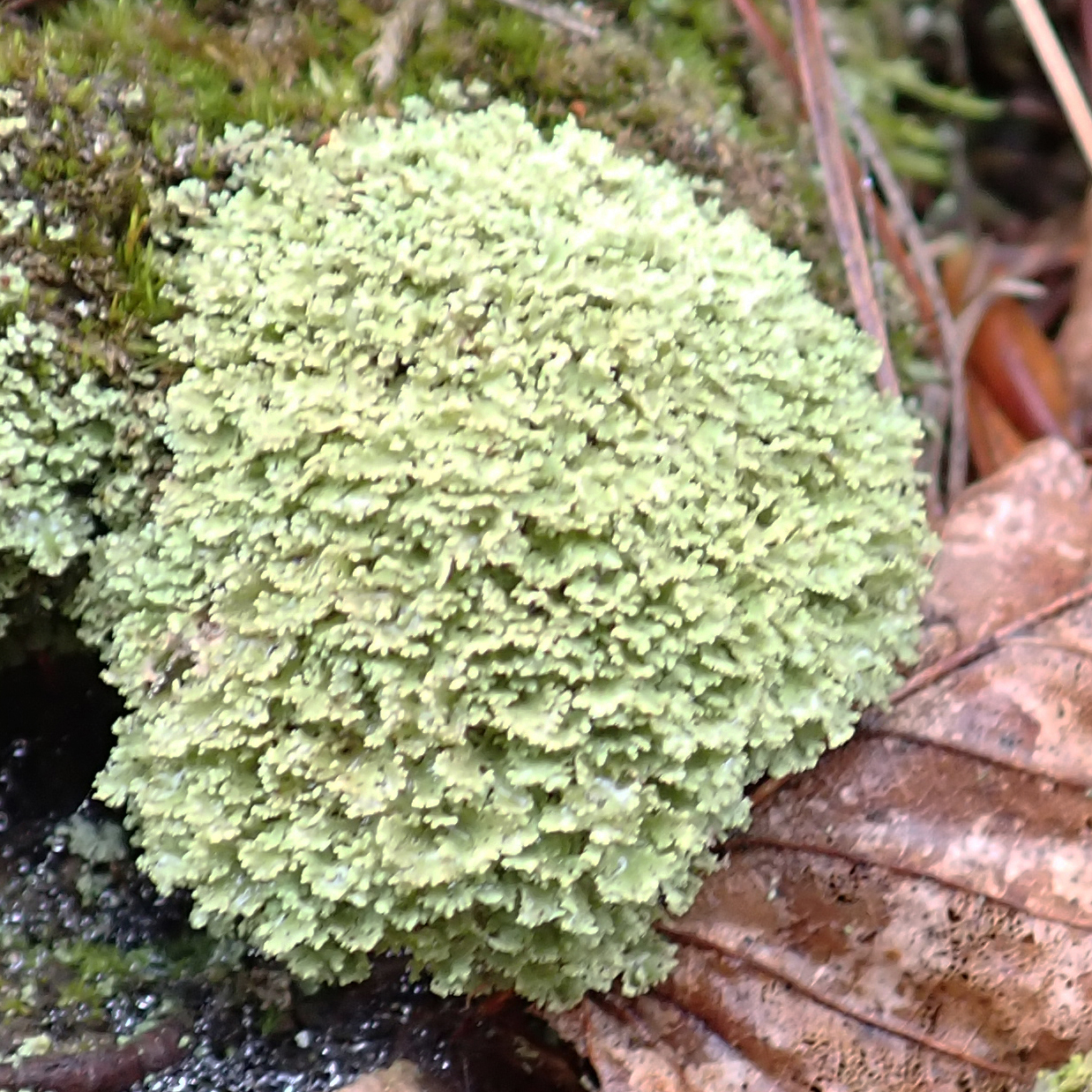
Olive Cladonia (Cladonia strepsilis) has shapes like the lumpy sponges from the sea once commonly used in household cleaning, but smaller.
Since lichens grow very slowly – people often cite the figure of 1 mm per year, though of course there is great variability – usually they make their homes on things that are going to be around for a while, such as large stones and trees. Many members of the Cladonia family are exceptions to this rule, taking as their habitat soil and decaying organic material. They certainly have figured out how to thrive in their niche.

The first thing that caught my eye at the Tompson Street Reservation was the bushy – "fruticose" in the language of lichenologists – growths on the very large granite boulders at the entry. I am used to seeing this growth form on trees and twigs, and on the ground in "reindeer" lichens, but had never before seen it directly and firmly attached ("umbilicate") to stone.
I believe that it is Ramalina intermedia. On the one hand, there is no documentation of the presence of this species closer than Weston, 35 miles away. On the other, there is no other rock-dwelling ("saxicolous") lichen of similar character in local records that I can find, and the morphology of this specimen corresponds closely with that of R. intermedia.
Very exciting!

Plated rock tripe lichen (Umbilicaria muhlenbergii) is notable for it shaggy edges, frequent perforations, and black spots. These features distinguish it from smooth rock tripe and the common toadskin lichen.
These growths were near the entry to Tompson Street Reservation of Gloucester. The small parking area near the kiosk there is surrounded by a riot of stone-dwelling lichens of all sorts, climbing and crawling over each other toward the sunlight.

Wikipedia notes, "Cladonia boryi, also commonly known as fishnet cladonia or fishnet lichen, is a species of lichen. It is distinctive in the genus Cladonia because the stalks (podetia) are very wide, seemingly hollow, and often perforated, hence the colloquial name - the fishnet lichen. It is also known as Bory's cup lichen." Evidently it was named after the botanist who first identified it, Jean-Baptiste Bory de Saint-Vincent.
The substrate of this one, bits of leaf mould and moss amid castoffs in an old granite quarry, is a bit unusual. It closely resembles the reindeer lichens of Crane Beach in Ipswich.

Physcia adscendens is easy to pass by, given its small size and inconspicuous color.
I was doubtful about this specimen for a while because the most authoritative references report that P. adscendens grows on stone rarely, if at all. Subsequently I found that Macrolichens of New England notes that it is common on marble tombstones, close cousins of the limestone marker here.
* * *
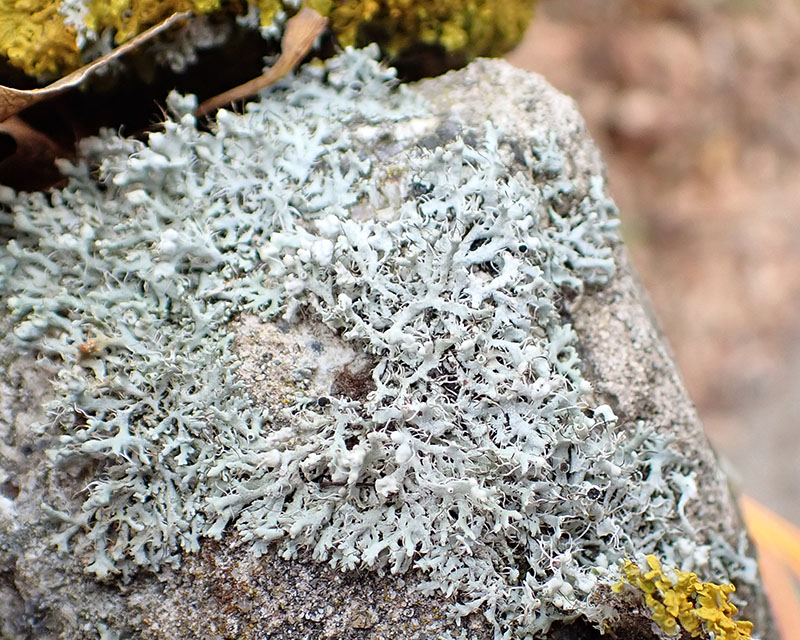
November 26: I found a very clear growth of P. adscendens on granite in a stone wall adjacent to a location where it has been reliably reported to occur.
It was reasonable to steer with heed to the clear dicta of pre-eminent lichenologists, but in this case these were off-target. – And, in the never-ending technology race, a newer camera really is better.
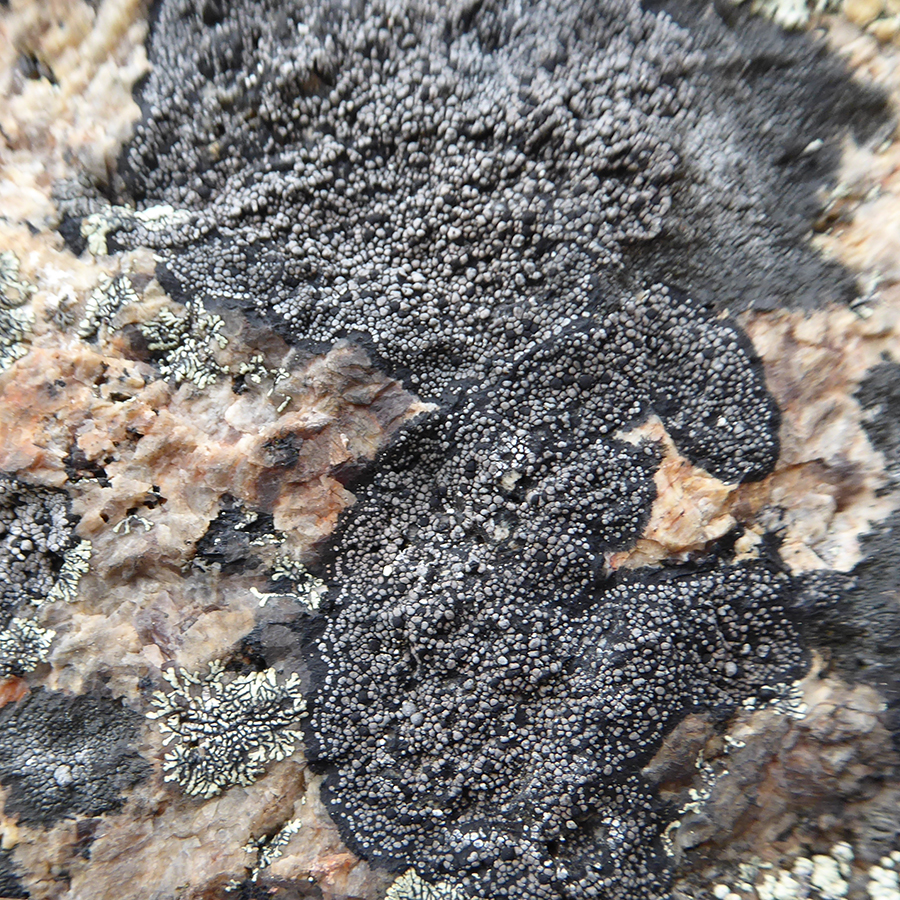
I am generally hesitant with flat, dark, colorless lichens, but I am reasonably happy with the identification of this specimen as Rhizocarpon grande. There is a related species, R. disporum, which looks very similar but lacks a strong record of presence in this area.
Like the references, this observation has a black/gray/white warty body with a black margin. The species is clearly present in its area. The rock it is growing on is evidently siliceous – a fancy word for "silicon-based" – as is apparent from its hard, rough surface, unworn by millenia of weathering.
I am hopeful that I have added a new possibility to my range of routine options for lichens of this general character.

The highest of the eponymous granite blocks of The Monoliths reservation must have at least a dozen different kinds of lichens growing over them.
This small growth of Rhizoplaca subdiscrepans caught my eye first because its pale orange color stood out from the surrounding grays, and then because its subunits form an unusual crowded pattern.

Cladonia furcata is occasionally called "many-forked cup lichen" – furcata is Latin for "forked" – and is sometimes spoken of as a "False Reindeermoss." It does resemble the "true" reindeer lichens and is in fact their cousin.
The specimen here is a more shy and smaller version of the reindeer lichen that spreads exuberantly in the sunshine of untold acres of sand dunes at Crane Beach. C. furcata most often makes its home in a cluster of moss, and so tends toward shady areas. I've noticed that the Cladonia of the sand dunes are often near moss. It is clear that this taxon is present among the other varieties there, but I want to go over things again before I say that there are four kinds of "reindeer" lichen in that location.

A park in Manchester-by-the-Sea, formerly Agassiz Rock, is now known as The Monoliths. The new name is apt for the awe-inspiring size both of the granite boulders there, and of the growths on and around them. If smooth rock tripe lichen (Umbilicaria mammulata) grows a millimeter a year, many of the examples must be close to a century old, like the trees above them.
I have found many questions and views about whether humans can eat smooth rock tripe. When times have been hard, sometimes people have, and a few still do (after boiling it to remove the bitter taste). As far as I can learn, it is not harmful but of doubtful nutritional value, and not particularly tasty.

In a visit to the Hamiliton Cemetery yesterday, an overcast afternoon following twelve hours of rain, I was immediately struck by the reddish cast of lichenous growth on the surface of some of the tombstones. As I wandered about, I gradually realized and confirmed that the color occurred only on the limestone headstones, never on the granite or slate markers. It was the mealy firedot lichen (Flavoplaca citrina, earlier Caloplaca citrina), I established after some confusion in follow-up research.
Remarks on Wikipedia are spot-on:
Flavoplaca citrina, the mealy firedot lichen, is a species of saxicolous (rock-dwelling), crustose [thin] lichen … It is a common species…
Throughout its taxonomic history, the species has accumulated numerous synonyms due to multiple redescriptions and reclassifications, including various designations as varieties or forms of other species.
Flavoplaca citrina is commonly found on calcareous (chalky) or nutrient-rich substrates, such as limestone, concrete, mortar, bone, and asbestos cement. It especially thrives on walls in sunny locations…
(I realize now that a puzzling orange growth on a fire hydrant close to me is F. citrina. Iron oxide tends toward the alkaline, matching the nature of the calcium oxide of limestone.)

Expert consensus seems to be that what is called Verrucaria nigrescens in fact an umbrella term that includes a number of undefined groups of organisms. That said, the specimen here seems to fit somewhere in the picture.
The Consortium of Lichen Herbaria comments, "Many samples filed under that name belong to other species or are not clarified yet." I have seen another growth that looks very much like this one in the tidal zone of the Manchester shore, ten miles away. The website Marine, maritime, oceanic and similar lichens notes, "Verrucaria nigrescens s.l. is highly variable and probably encompasses several taxa."
There is consensus that the range of V. nigrescens is wide. Perhaps because there is little certainty about what the lichen is, there is even less certainty about where its range begins and ends. – For the present, to my eye the range includes Essex County.

Having learned that what I was considering as one, was actually at least two species of reindeer lichen logically raised the question: more than two?
Yes.
Star-tipped reindeer lichen (Cladonia stellaris) is of a much more gray hue than the others I noted earlier. This is not a matter like changing color of hair in aging humans, as I had naively told myself, but a sign that we have distinct varieties of things from their start.
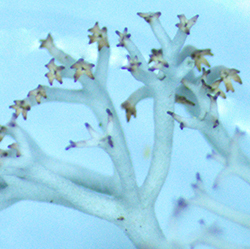
A microscopic close-up reveals that the tips of the specimen are star-shaped, as the common and scientific names both indicate. The one shadow of doubt I am left with is that the points are of a dark color, which I don't find mentioned in the literature.
More than three kinds?

Brown cobblestone lichen (Acarospora fuscata) is one of the better-behaved lichens I have studied. It is brown (mostly, sometimes running quite dark or light), looks rather like small cobblestones, and is a single recognized species rather than a mire of confusion and hotbed of controversy.
And it mingles and gets along well with all kinds of other lichens, as is shown in the image here, from the Burying Ground of the First Settlers in Newbury.
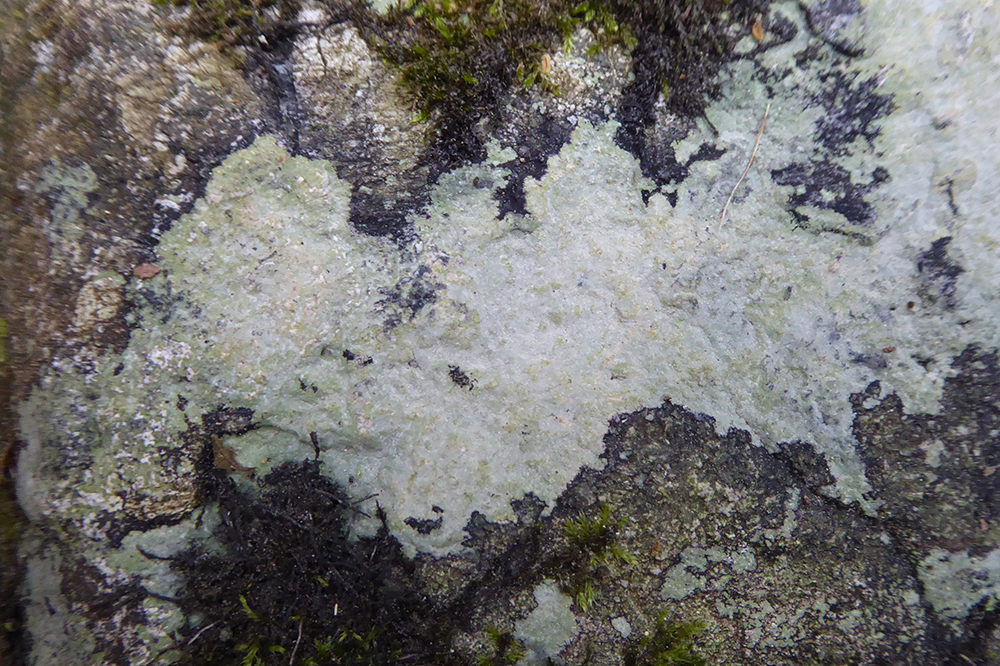
I find identifying white (or black) lichens on rock challenging. If the color of lichens is highly variable, at least having some color offers a clue. Stones of any size are usually not clean or easy to lug home for closer study, and the growths on them most often are fixed tightly to the surface, like paint, without any obvious display of reproductive bodies. Altogether, there's not much to work with.
I believe that this sample is mostly likely Trapelia placodioides.
On the one hand, there is not broad documentation of the presence of the species in this area, and its firm identification requires professional analysis.
On the other hand, T. placodioides clearly does have a world-wide distribution, with two or three credible reports of its presence around my area. Lichens of North America comments, "It is a fairly common, shade-tolerant lichen on forest boulders in the Northeast," which exactly fits the location of this sample. Its appearance matches neatly with a description, reported habitat and images from Leicestershire, farther away.
I very deliberately decided against setting up lab facilities at the outset of this pursuit, but I read that this species presents a red color with the standard calcium test – using ordinary household bleach. I managed to come by a small dropper bottle and put a couple of spoonsful of bleach into it. On a return visit to the site, I found that spot tests of growths like it readily and consistently produced red stains. (One might have guessed that bleach would remove red colorations!)
All in all, it seems like a reasonable fit to me.
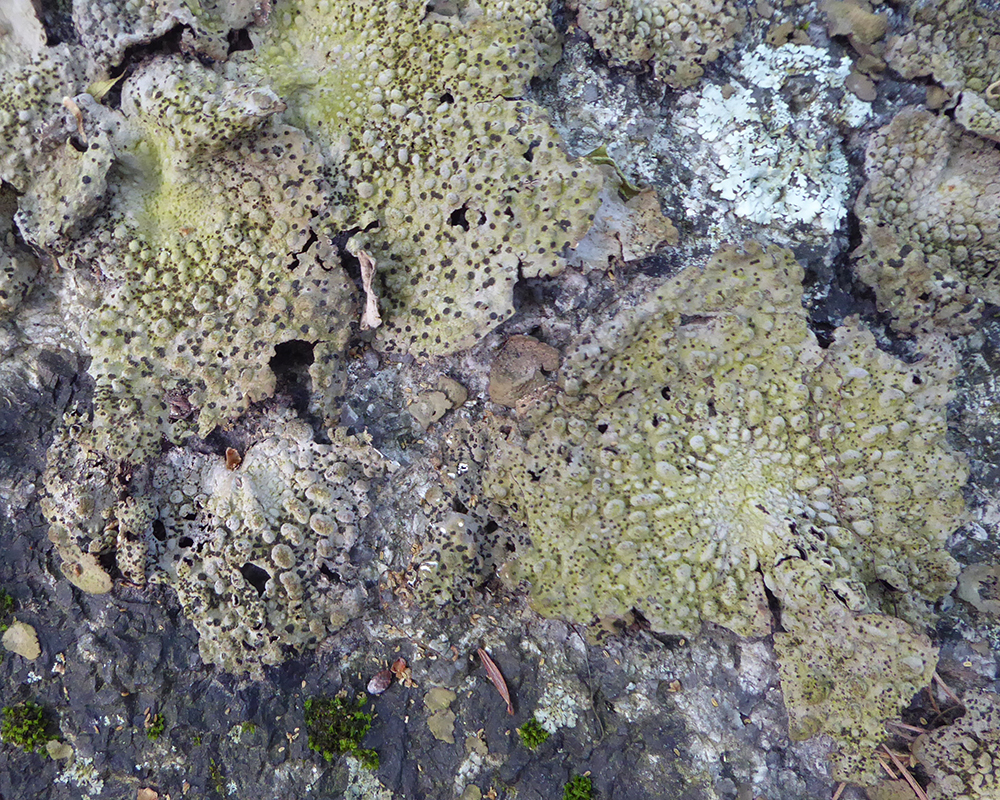
Common toadskin lichen (Umbilicaria papulosa, in older records Lasallia papulosa or Gyrophora papulosa) is dense throughout the Bow Ridge Conservation Area of Lynnfield. This area is hilly, thick with granite. It was formerly the site of the Kallenberg Quarry. The lichen is frequent throughout this site and neighboring Saugus Quarry area.
A smaller growth of another, unidentified species is also present in the picture shown here.

I walked by and glanced at this lichen on my patio many times in the past few months without taking a very close look. Mortar rim lichen (Myriolecis dispersa, earlier Lecanora dispersa) is tiny. The discs (reproductive bodies) shown in the image are a few tenths of a millimeter in diameter.
As Lichens of North America notes, the "thallus [body is] usually growing between the rock crystals and absent from view." On casual observation, this colony seemed only one of a series of dark, dirty smudges. The stone itself is slate, covered with some kind of protective coating associated with commercial use. I don't know what the coating is, but lichens seem to like it, since a variety have settled on it. It is in full sun.

The lichen shown here is evidently of the genus Lepraria. There are a number of closely related species within that genus, with uncertain distinctions. At a venture, I am calling it Fink's dust lichen (sometimes named "fluffy dust," Lepraria finkii). On the one hand, there are not recorded occurrences of the species in this immediate area. On the other hand, there is documentation of close cousins within the area, and the appearance of this specimen is closest to that of L. finkii. It is growing on a fallen pine, a favored habitat for its close family. A few inches away were growths of another species favoring that habitat, lipstick powderhorn lichen (Cladonia macilenta).
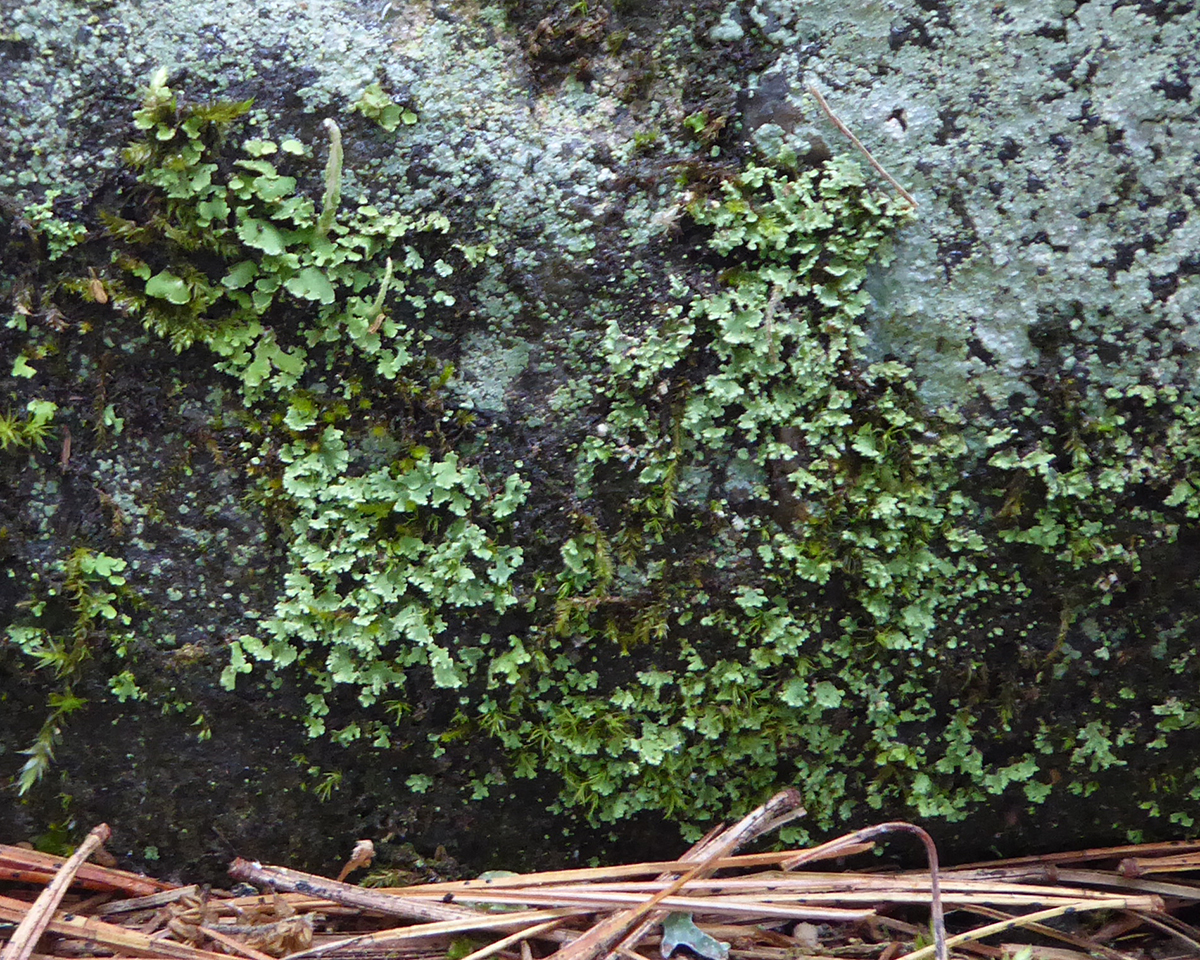
By appearance, this specimen could fit either as common powderhorn lichen (Cladonia coniocraea) or as smooth-footed powderhorn (C. ochrocholora). The distinction between the two species is apparently confused; the Consortium of Lichen Herbaria (COLH) notes, "The nomenclatural status of the names C. coniocraea and C. ochrochlora is open."
I will list it as "common" just because it is that, and my policy is to steer in that direction. One could argue for the alternative because the COLH description does not include stone in its recognized substrata for C. coniocraea, while for C. ochrocholora it reports, "also on moss covered rocks, particularly at damp sites," which is precisely the situation here – but it immediately adds, "see discussion under C. conicraea."
There are bits of another, lighter-colored lichen at the top of the image here.
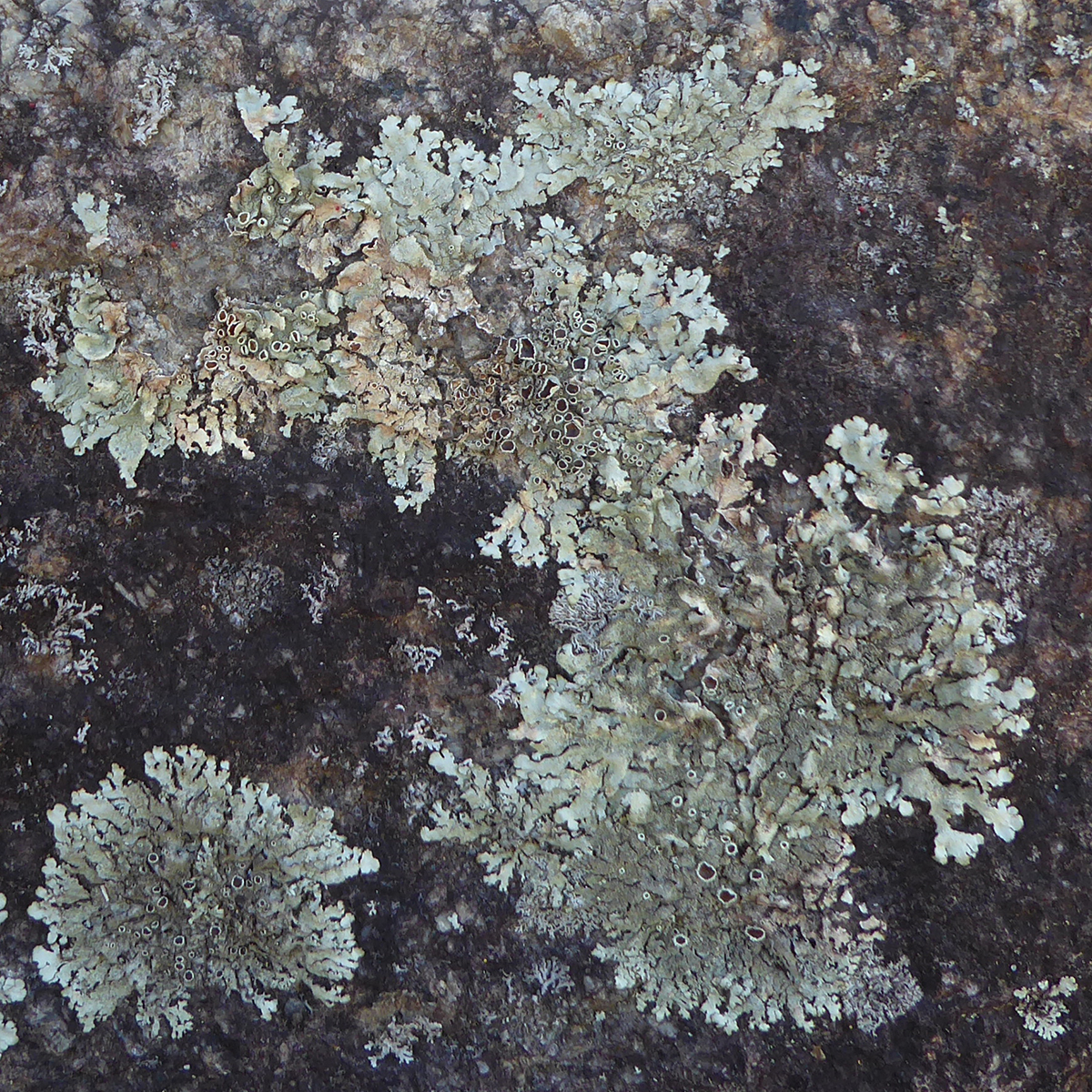
This growth of peppered rock-shield (Xanthoparmelia conspersa) readily established itself on a granite step at my home, placed twenty years ago. It was not at all fazed by the heavy soot left from the coal-burning age. While the species has large variations in appearance, this one matches well with published images.
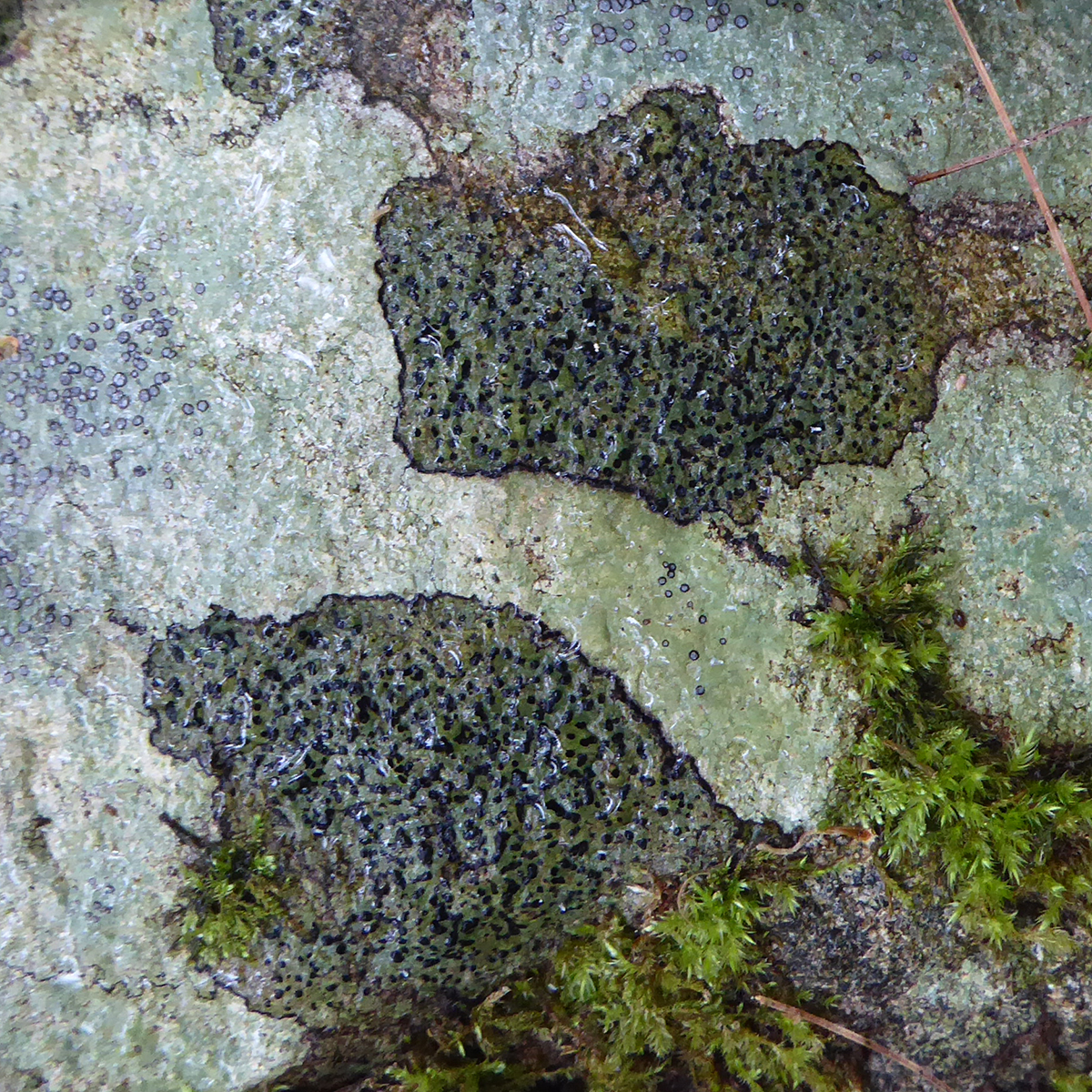
I have observed specimens like the one shown in a number of places. This one is from the Hunsley Hills Conservation Area in Rowley. The growths in the picture are visibly wet from early morning mist. The dark area of the specimen discussed here is growing over another light-colored lichen, possibly of the smokey-eyed boulder variety, with bits of moss around.
After considering a number of possibilities and changing my mind, I believe that the most likely scenario is that it is smooth map lichen (Rhizocarpon hochstetteri). It is also possible that it is dusky map lichen (R. obscuratum). Appearance, notably of the dark rim, supports the former. Previous reports mostly support the latter. There is recognized confusion and debate about these species among experts.
I have since found many similar specimens in a great variety of shades, from light green to nearly black. The family is very shade-tolerant, which is somewhat unusual with lichens, but I have found growths in full sunshine.
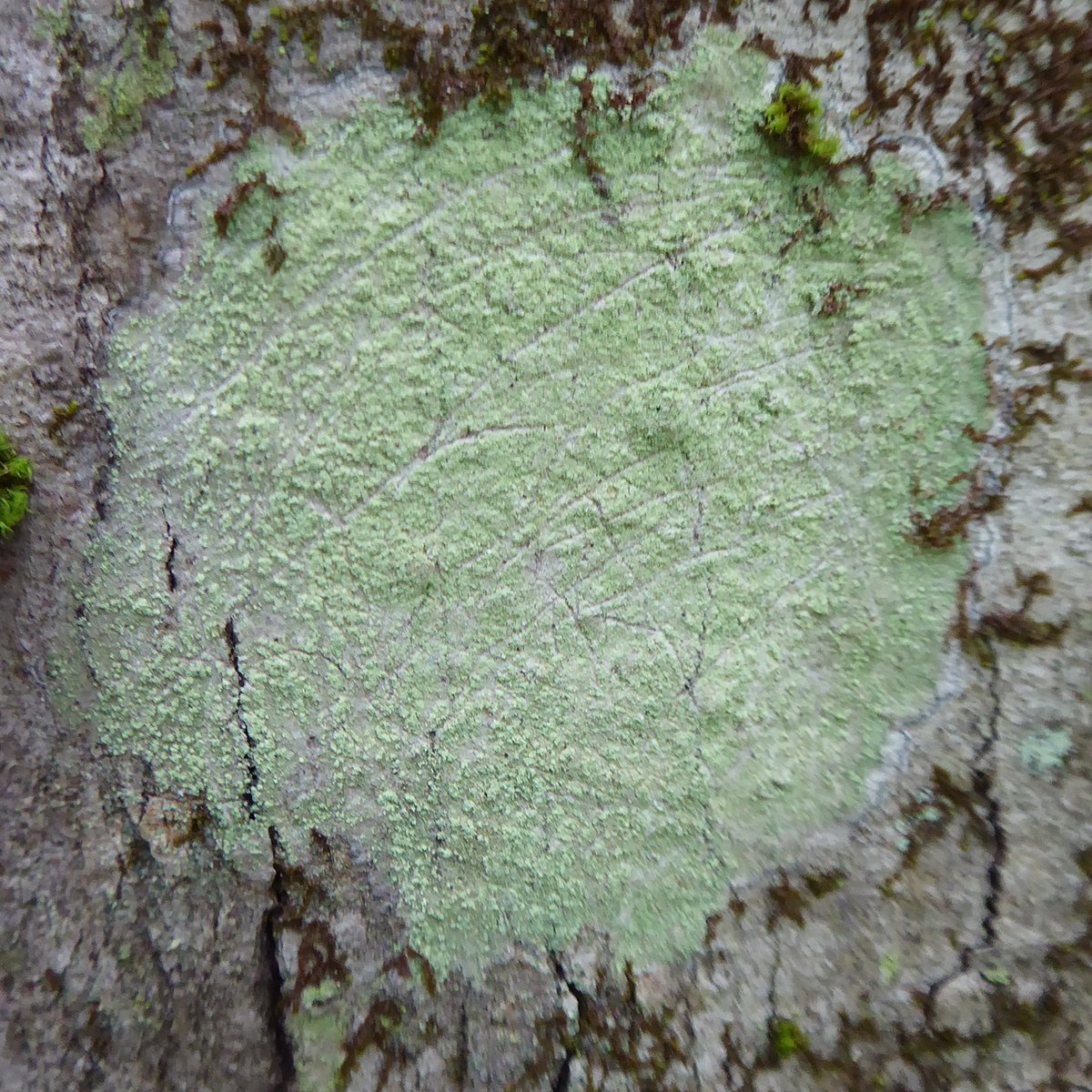
Mapledust lichen (Verseghya thysanophora) has a light green body over a white underbody. As its name suggests and is the case here, it often grows on maple bark, but is found on other trees as well.
"It is a common lichen in eastern North America," an article in The Bryologist reports. It is cited less often than some other species in my usual sources for this area, but has been reliably reported along the Ipswich River and in Boxford, both only a few miles away.

Lichens often change color when they are wet, as the underlying green of the algae shows more through their thin fungal coat. After a recent rainy spell, I noticed some patches of unfamiliar lime green in a very familiar expanse of pale green and gray growths. Looking more closely, I found cups of light brown, with whitish rims. The well-known adjacent species do not have such structures.
There are many views on the classification of bottlebrush shield lichen (Parmelia squarrosa), and any number of look-alike species. P. squarrosa is very common and widespread, with reliable documentation of its presence in this area. The specimen shown here has size, morphology, color and habitat matching those documented for P. squarrosa. The light brown discs in particular fit well. Basic microscopic comparison has been corroborative as well.
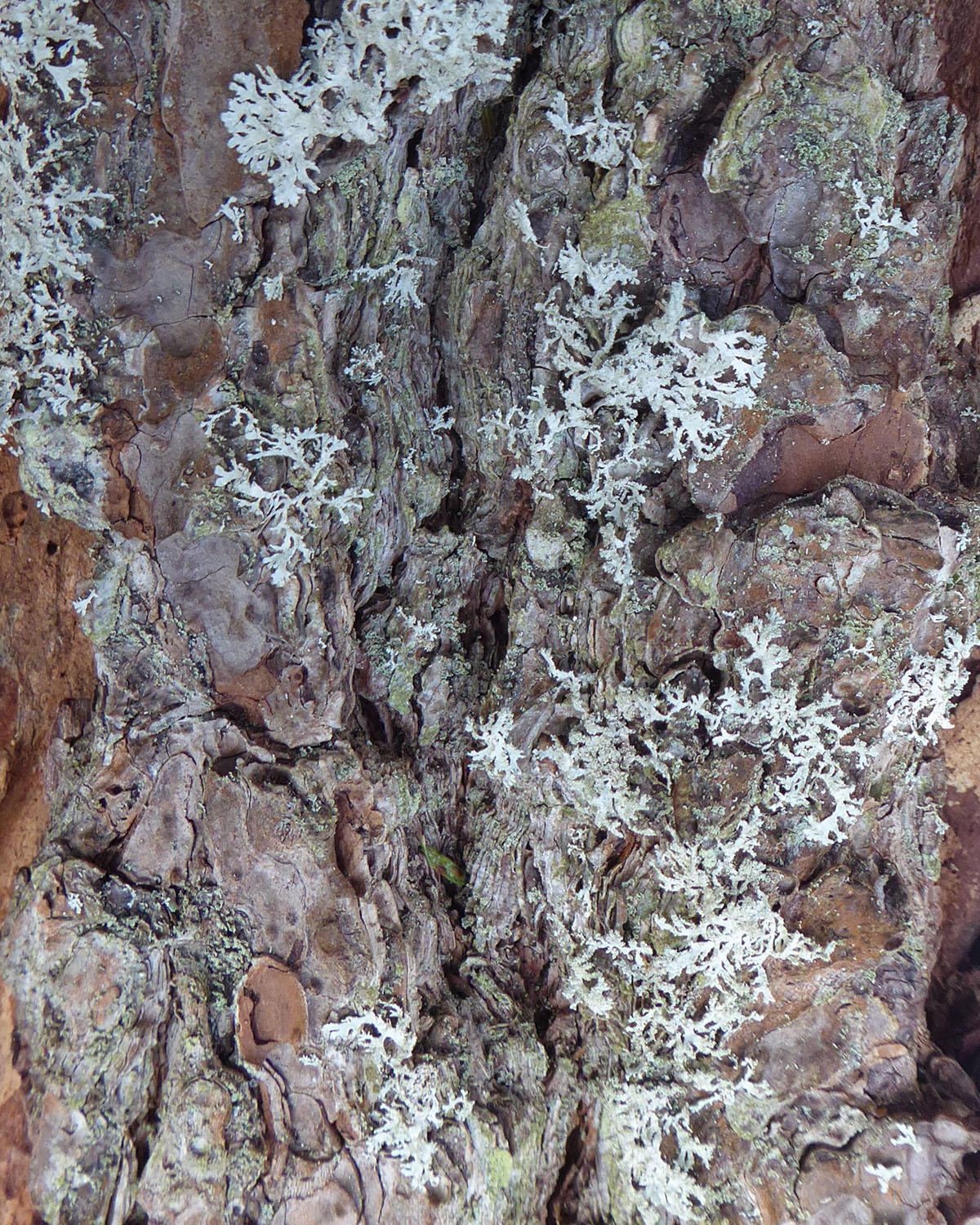
I am relaxing my practice somewhat, naming this species even though it is not documented as present in the immediate area where I found it, according to a couple of the references I normally use as guidance. Partly, this is a matter of many other reports up and down the coast of Massachusetts and inland. Partly, my inclusion reflects my growing comfort with lichen anatomy and its special language. Partly, credit is due to a wonderful pen-and-ink illustration that accompanies the careful description I relied on.
I found this specimen of Parmeliopsis hyperopta on the bark of a pine tree, a favored habitat, in Bradley Palmer State Park.
The pedigree of this species and its territory and kin have been under discussion for over a century. It has a cousin, P. ambigua, whose name is an apt commentary on the situation.
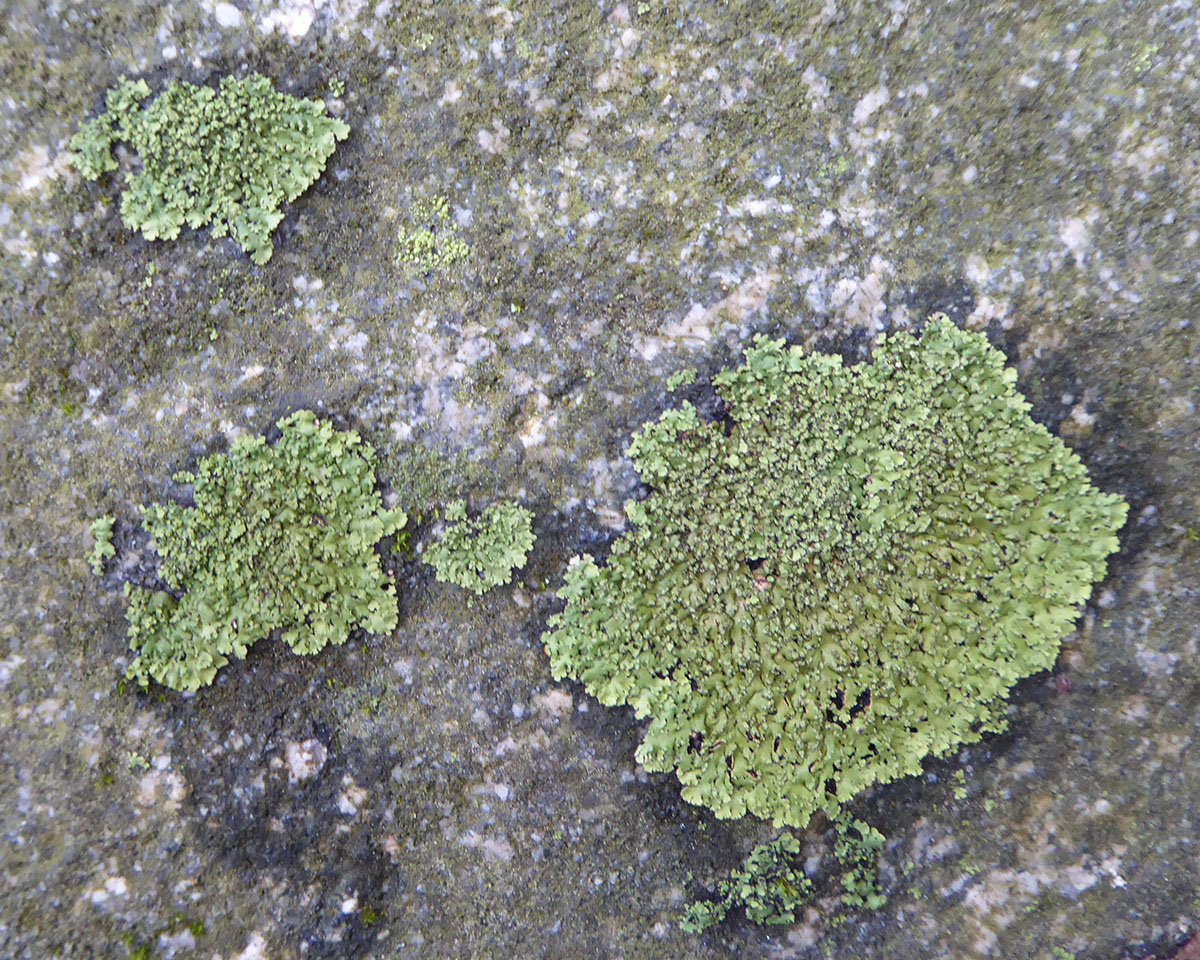
I will tentatively identify this specimen as orange-cored shadow lichen (Phaeophyscia rubropulchra) on the basis of gross morphology and of couple of credible citations of its presence locally. Curiously, this growth and a few of the published images of the proposed species show dark areas surrounding the lichen.
That evidence is less than desirable, to be sure. In particular, it would be due diligence to verify the orange-red interior of its medulla. That is more easily said than done, especially in the case of a growth on stone, which makes it hard to break off a reasonable sample to take away for closer study. Perhaps another day I will return and find a way to prise off a fingernail-sized piece from a low-visibility location.

Roger Tory Peterson's seminal Field Guide to the Birds did not include the pigeon. That obviously wasn't an oversight. I don't know if he had an active dislike of pigeons, or simply felt there was no call to discuss such common and banal creatures. Or perhaps he was a purist; early American settlers brought the first pigeons from Europe.
My omission here of rock greenshield lichen was simply a matter of neglect. I will rectify that now. Rock greenshield lichen (Flavoparmelia baltimorensis) is as common as pigeons are. It generally was and often still is lumped together with common greenshield lichens. Experts now distinguish the two. One grows on rocks, the other on trees.
In shadier, damper locations the color tends to run more toward a yellowish green.
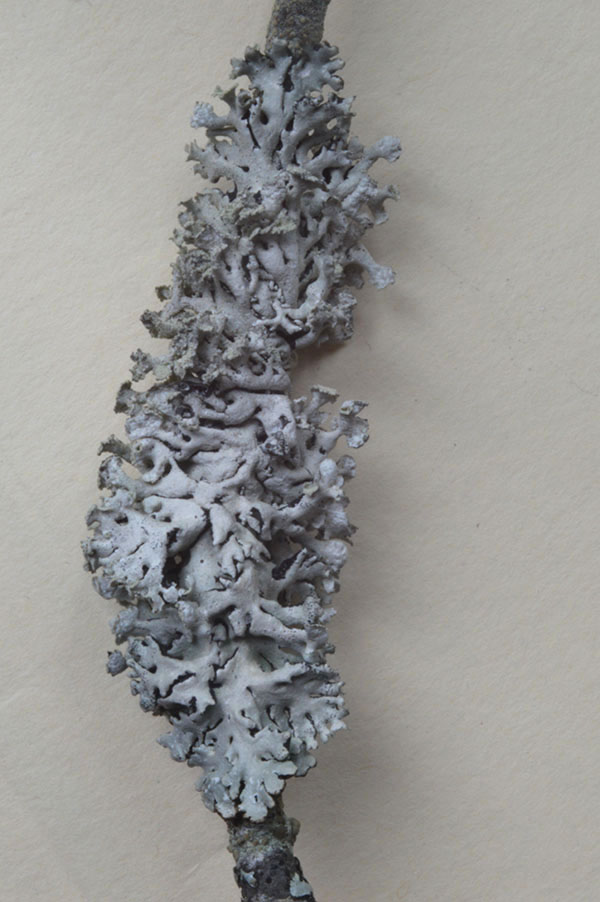
Monk's-hood lichen (Hypogymnia physodes) is common in this area.
Because it is light gray, its presence is unobtrusive amid the vast spread of common greenshield lichen. It took me a long time to recognize the distinction. The overall sizes and shapes of the lobes are quite different, though, once you stop to look at them. The ability to enlarge images proves to be vey helpful in this field of study.
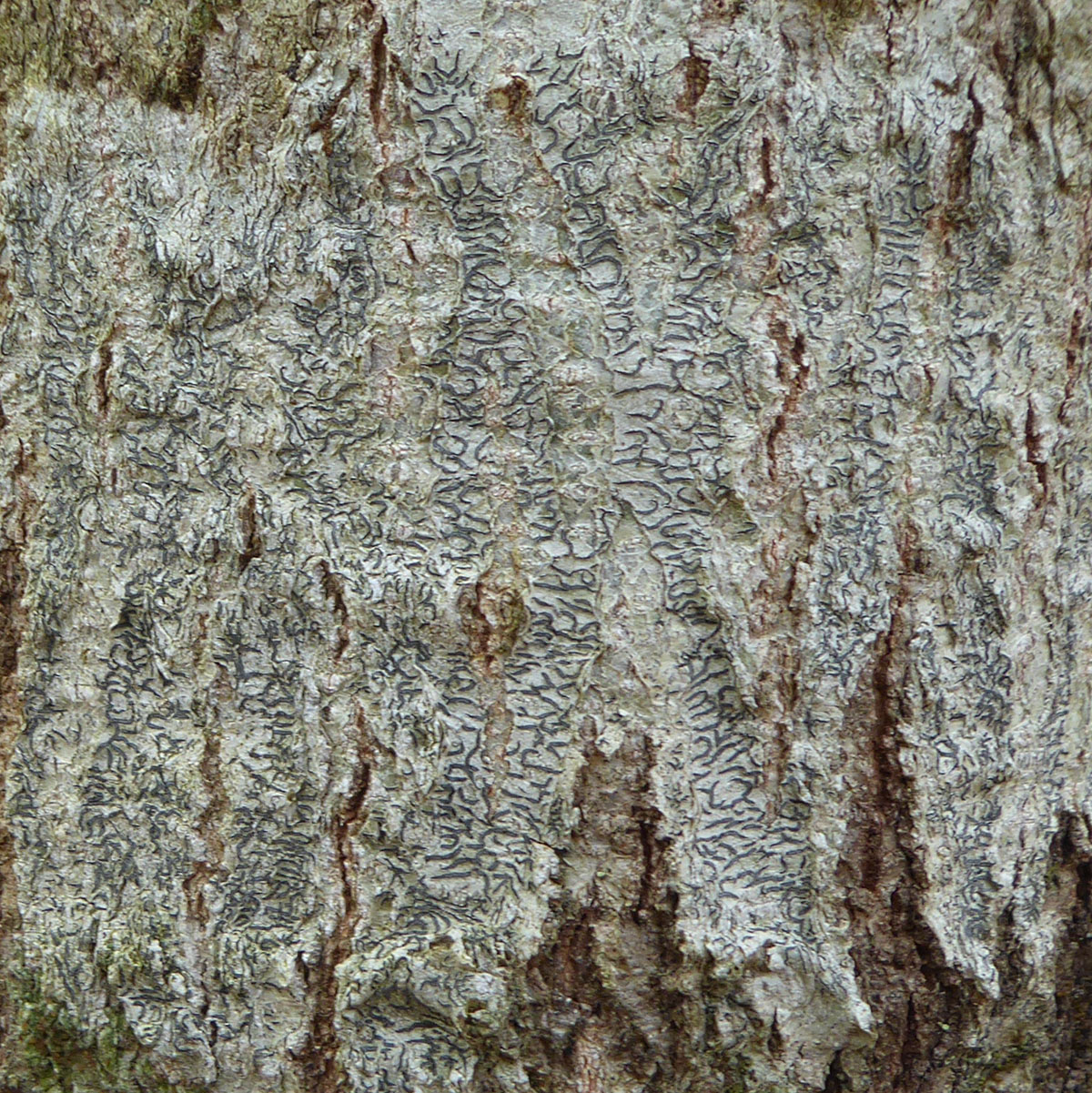
Unlike some other labels here, the name of the Common script lichen (Graphis scripta) is easily understood, since it (1) is widespread, (2) has lines that look like some foreign handwriting, possibly from some exotic ancient culture, and (3) is a lichen. "Common script lichen" may be a conflation of a few species.

"Powder-tipped shadow lichen?" – Whoever thinks up the common names for lichens is as fanciful as the branding department of an interior paint manufacturer or the marketing division of a dietary supplement maker. The scientific name Phaeophyscia adiastola is unapproachable, even for those who, like me, studied Latin and Greek for years.
Whatever you call it, its pale green color fits unobtrusively into the vast scatter of common greenshield lichen around it. I passed by it countless times until yesterday I first noticed the clusters of rimmed dark disks.
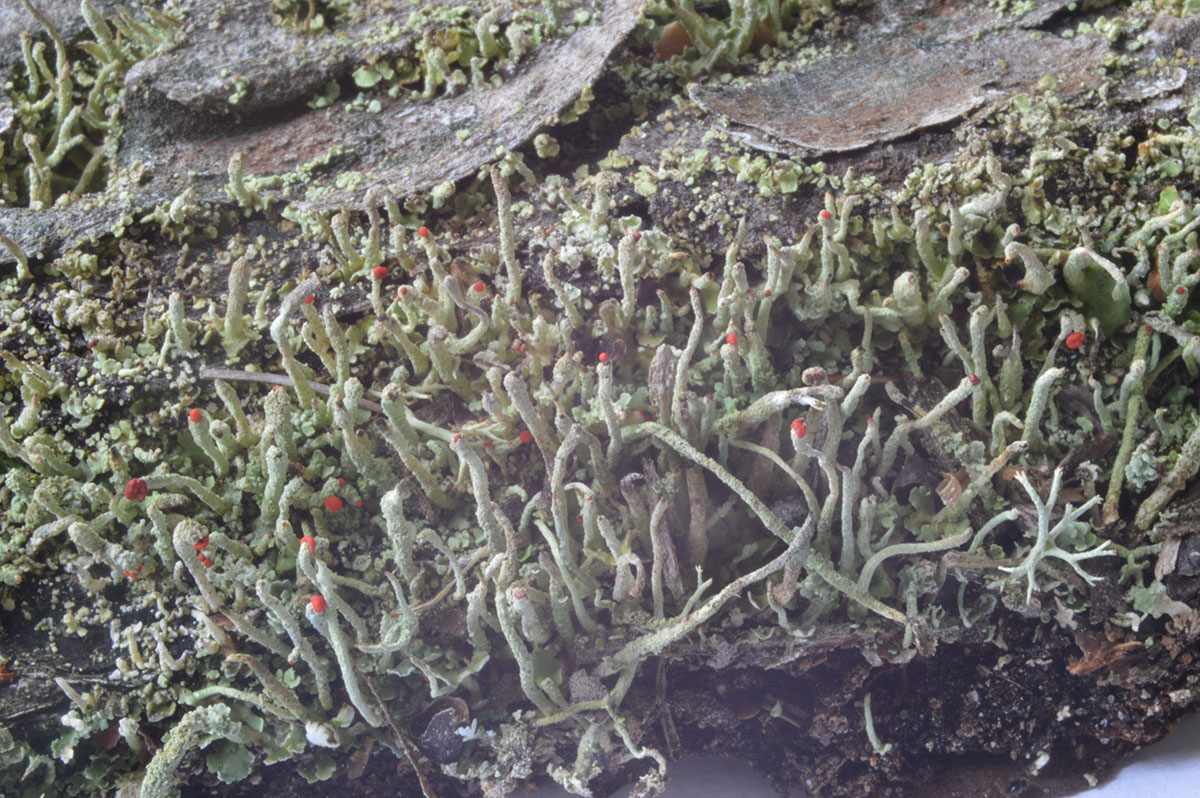
Lipstick powderhorn lichen (Cladonia macilenta) has red caps on its stalks, like its cousin British soldier lichen. These are very small, only a few mm high, so one needs to look very closely to see the tips.
The species has the confusing preference of growing on dead wood, as it is here. That is a very unlichen-like proclivity. Mosses and fungi need organic matter to feed on, but lichens provide for themselves in this regard. It took me quite a while to pick out this group, though I pass it nearly every day.
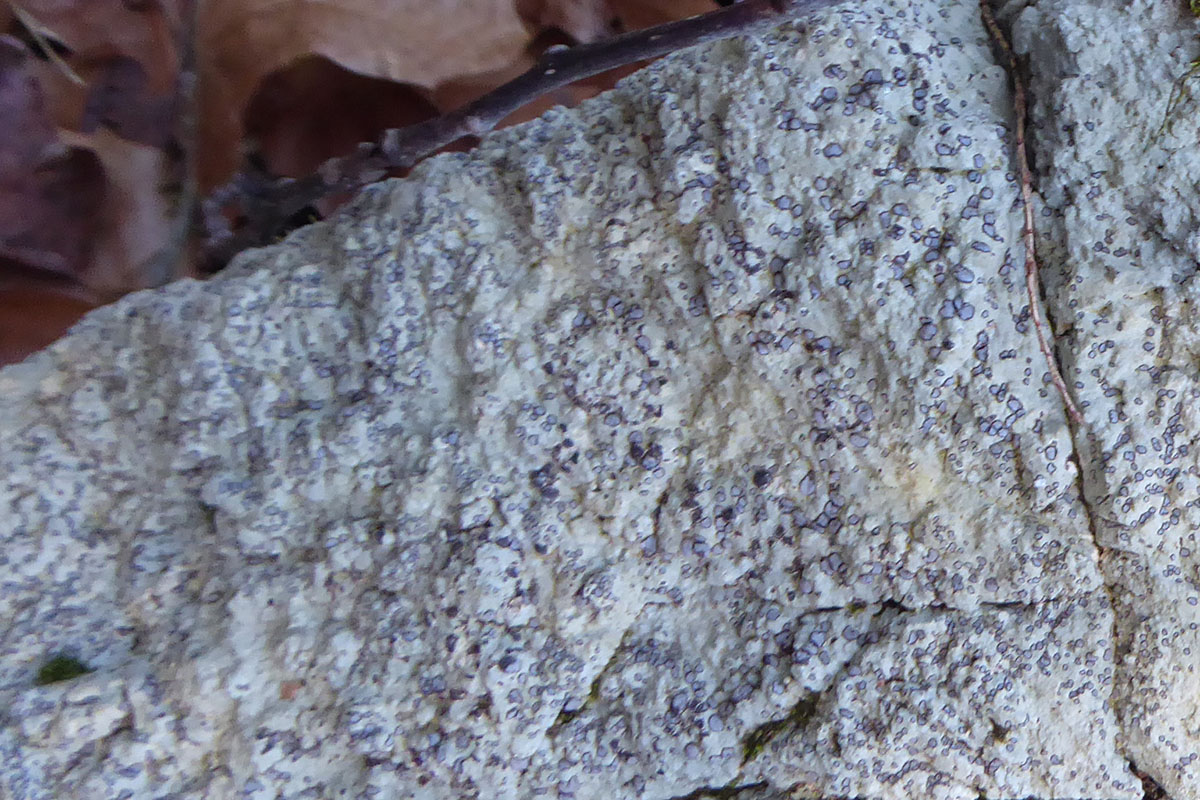
The name "smokey-eye" is curious, because this lichen has striking discs of blue – "eyes" – on a smokey background. Well, some might say the discs were bluish-gray with dark rims. (I recommend enlarging the thumbnail image shown here.)
P. albocaerulescens is a common lichen. I found this example along the Ipswich River, where it has been reported before.
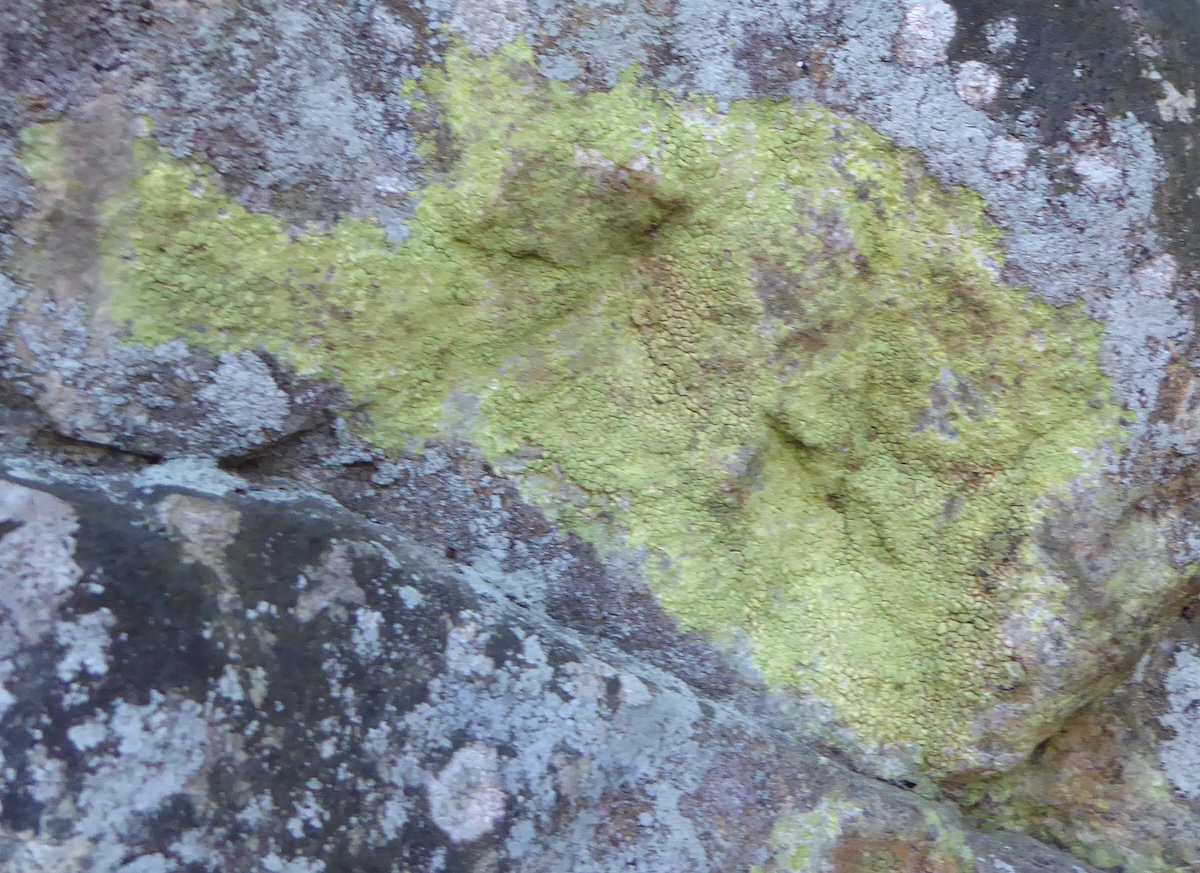
I found this sulfur dust lichen (Chrysothrix chlorina) close to the Ipswich River. It has been reported before along that river, and pictures of it are common enough that I recognized it immediately when I saw it.
In moist and shady locations, its color can be quite green.
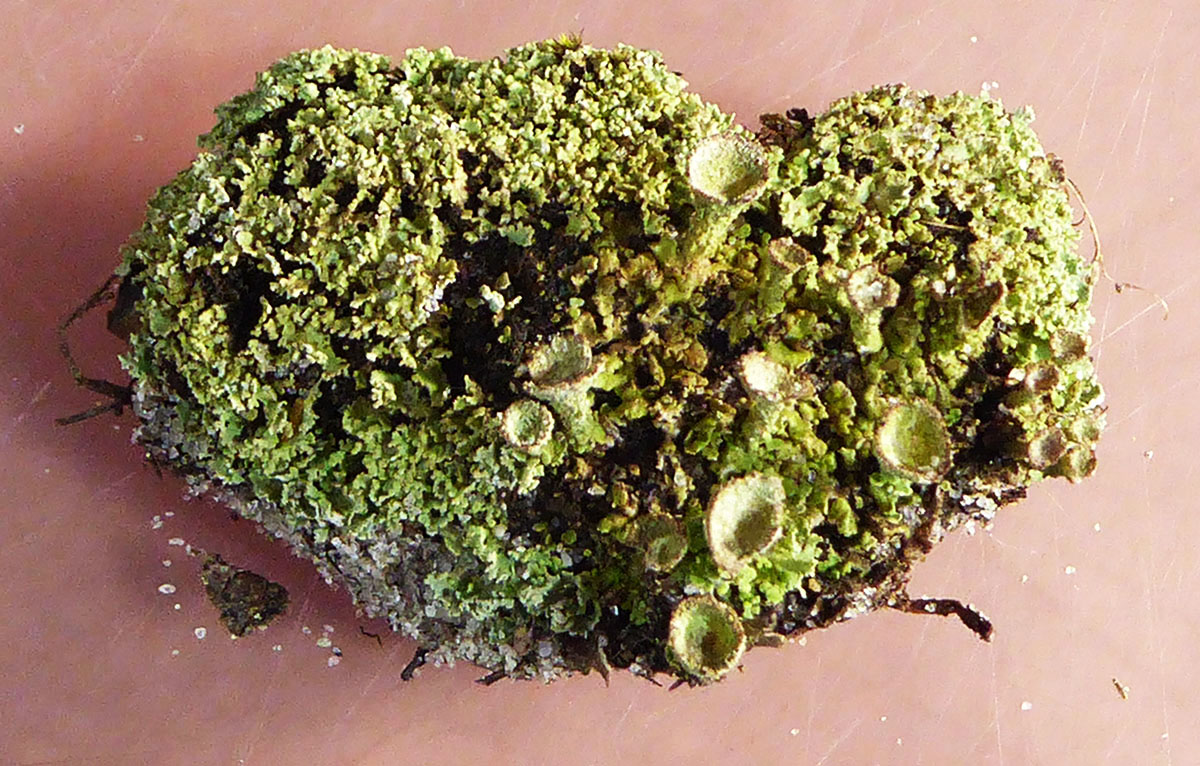
Pixie cup lichen (Cladonia pyxidata) is tiny. The "cups" in the picture could not hold as much as a drop of water apiece.
I must confess that not long ago I collected another sample but discarded it, thinking, This is a moss, not a lichen. I am learning, little by little!
In the specimen shown here, the cupped stalks of the apothecia – reproductive bodies – are about 3 mm high. It came from a shaded, low-lying and silted area of sand dunes. The particles in the lower part of the image are grains of sand. Not far away, other examples are growing up the bottoms of pines.

Moonglow lichen (sometimes "Golden moonglow") (Dimelaena oreina) grows "on steeply inclined surfaces of hard siliceous rocks", the Consort of Lichen Herbaria reports. Another source notes that it occurs "on rocks and tombstones in exposed areas." It is common hereabouts.
In a new and confusing area of study, I have found this example to follow the script exactly and look just like the pictures in the books.
The name moonglow is evidently derived from the radiating appearance, called "areolate" and "radiate-plicate" in the language of lichenology. The form reminds me a bit more of the rays and halos shown in old paintings around the heads of holy persons and angels.

The cinder lichen (Aspicilia cinerea) is aptly named.
In the image here, the large gray shapes are cinder lichen, with smaller moonglow lichens and perhaps bits of coal dust lichen around them.
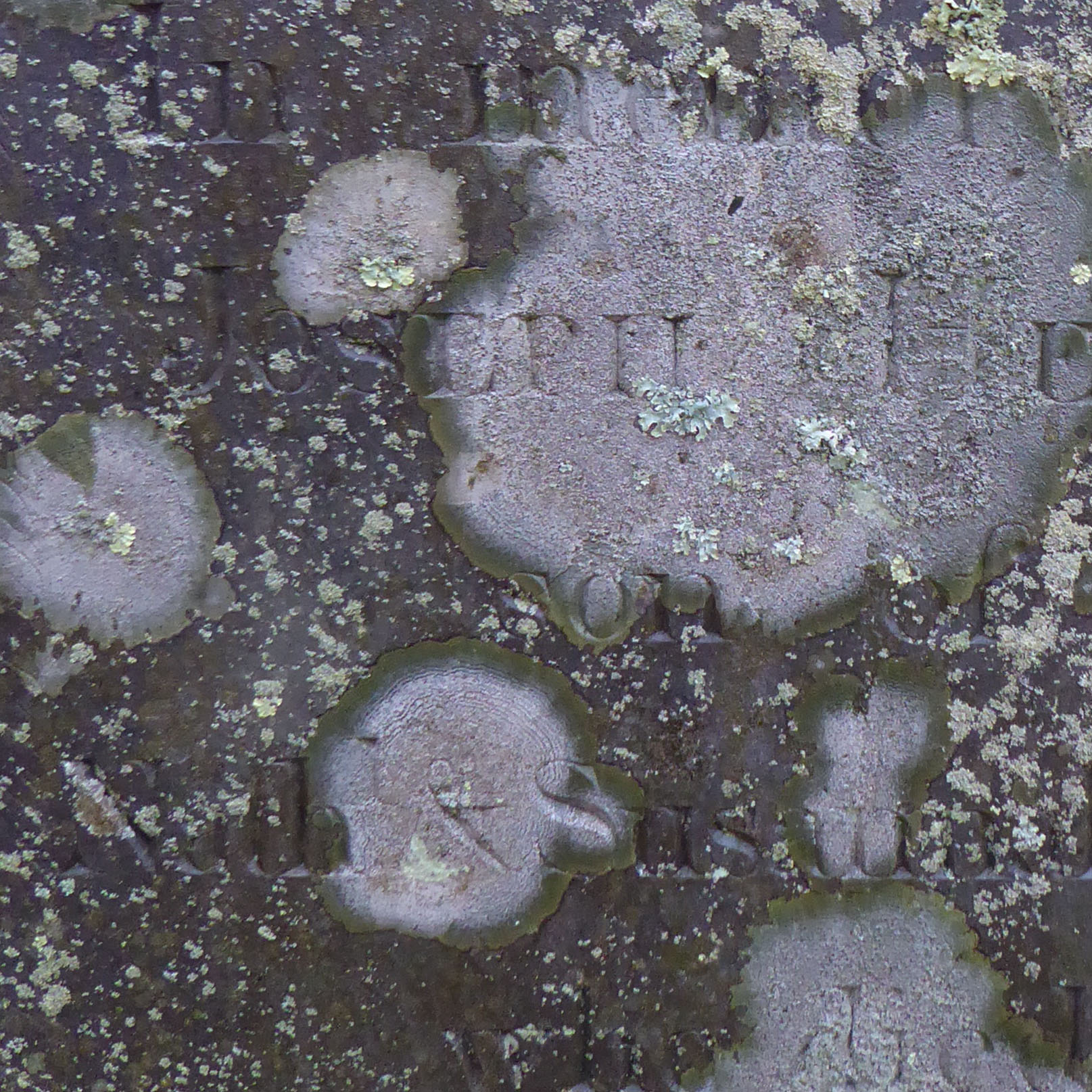
After some head-scratching, I will report a couple of specimens on slate as seemingly belonging to this genus, if not species. Both of the slate-based growths are surrounded by striking halos of olive green, which possibly fits with some some printed references but no images that I can find. In the example shown here, there are bits of other lichens scattered around.
One possibility is that the green comes from some interaction between the lichen and the chlorite-containing slate. Wikipedia notes,
The name chlorite is from the Greek chloros (χλωρός), meaning "green", in reference to its color.
There are various technical tests that could be made, beginning with simple chemical assays. I am holding off on moving to that level, however. I am feeling like a beginning bird-watcher who has learned to tell a crow from a robin from a turkey, but doubts that that his abilities are quite up to a top-line set of binoculars. More likely, a firmer grasp of lichen anatomy would be the best next step.
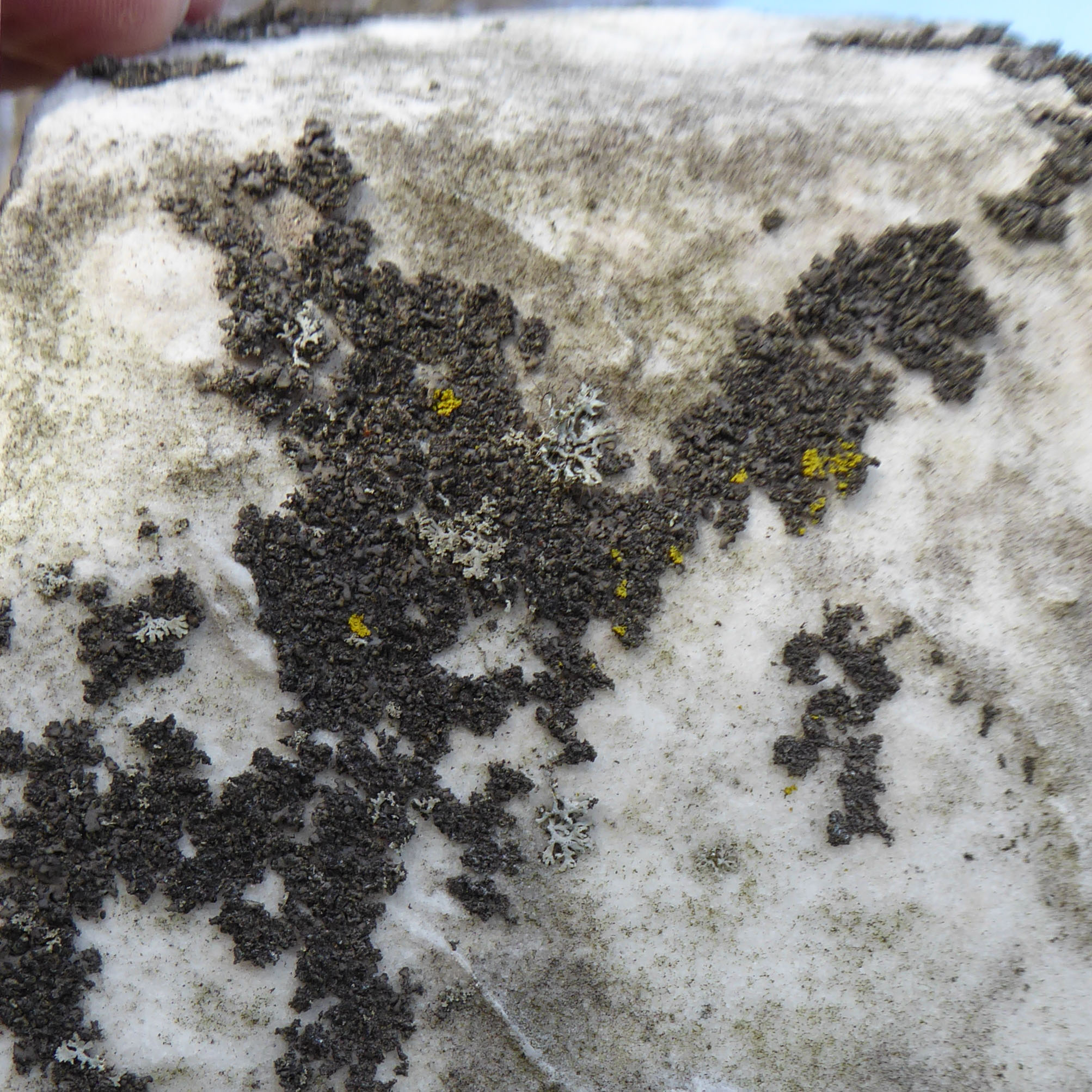
"Coal dust lichen" is a common term for a common lichen, aptly named. Beyond that, there is considerable variation and evolution in the story.
Acarospora privigna is also called Polysporina simplex. The Consortium of Lichen Herbaria reports that it is found "on acidic [i.e. siliceous] or carbonaceous rocks, in sunny, open sites." Lichens of North America reports that "Polysporina urceolata is a related species on limestone." That is a neat fit for the substrate shown here, but I have not been able to find a geographical range described for urceolata. Simplex is widely reported to be found in this area.
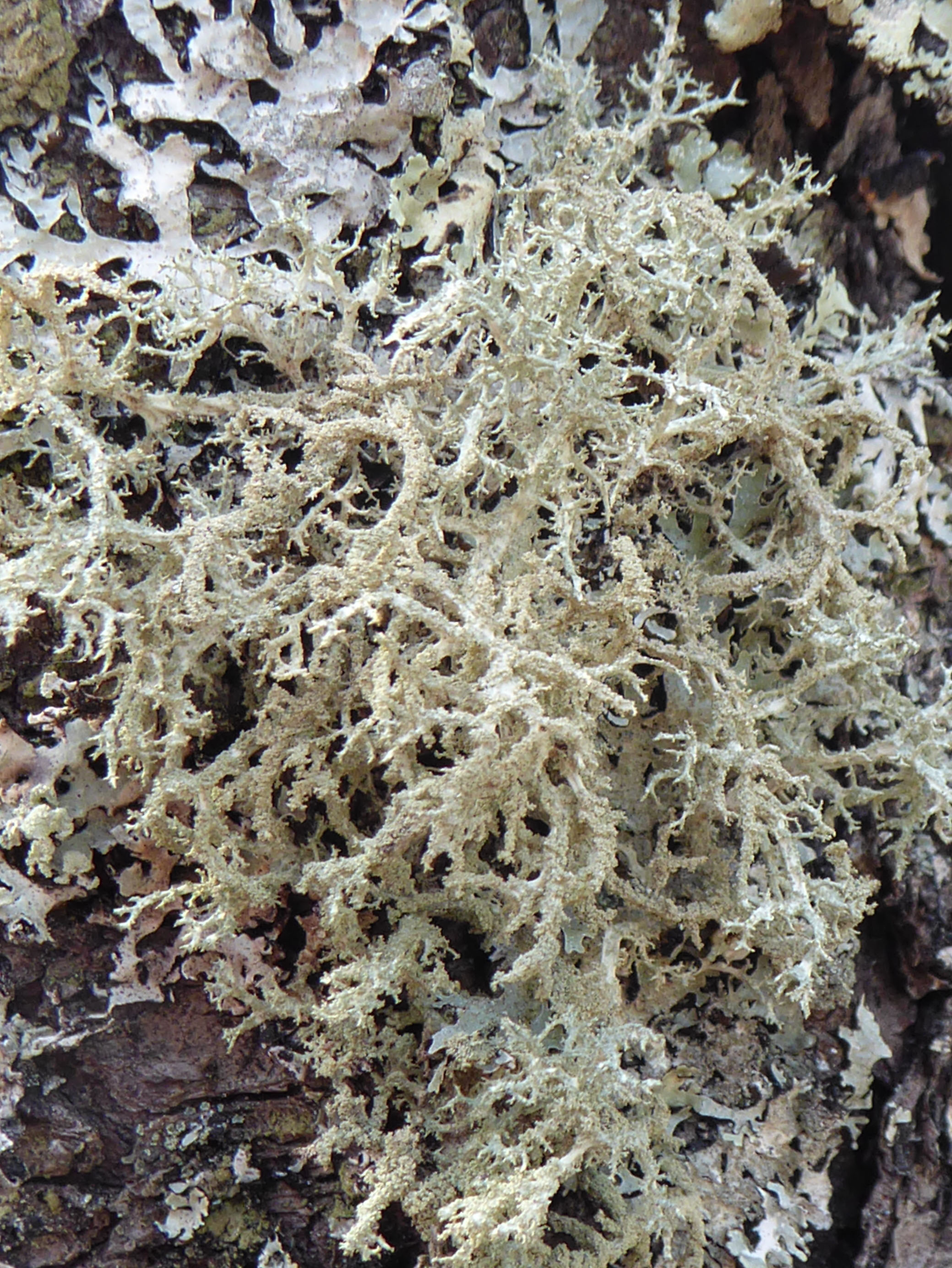
Though its bushy appearance resembles that of Usnea subfloridana, noted below, this lichen caught my eye with its differing texture and tree-trunk location – I have only seen the former on twigs. Initially, my impression was that it was Usnea hirta. After microscopic examination and further research, I believe now that it is more likely boreal oakmoss lichen (Evernia mesomorpha). Both are present in this area.
* * *
I have since come across countless other specimens at Crane Beach that fit with this identification, and found records of sightings there by others. The species is distinguishable, even to the naked eye, by the dense covering of what looks like coarse, granular powder – soredia, to use the technical term for these reproductive bodies.
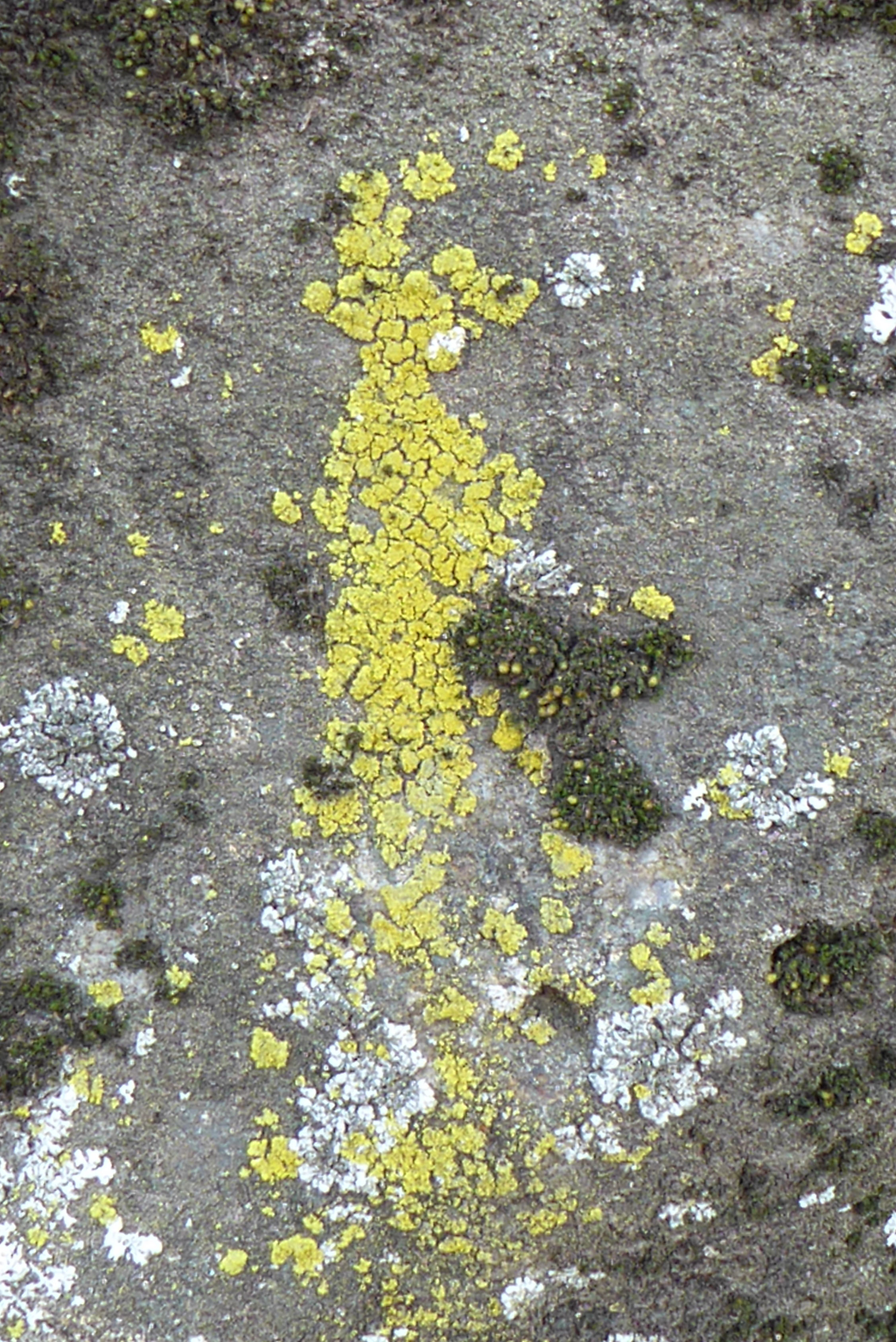
As the Consortium of Lichen Herbaria notes, "Candelariella vitellina is a common and widespread species."
The example shown here – the light green growth – is one of a number on granite and other hard stones in the center of Ipswich. Their age might be measured in decades, certainly not in centuries.
The smaller, lighter-colored growths are apparently moonglow lichens, the dark green an unidentified moss.

Melanelixia subaurifera was formerly assigned to the genus Melanelia The genus cited here, Melanelixia, is a relatively recent one, the subject of ongoing research by specialists. Initially, I had identified the species as M. glaburata. In any case, that would not be not far off.

My discovery of new lichens seems to be proceeding apace, facilitated by breaking weather, learning what to look for, and encouragement from a bit of recent success.
Xanthoria parietina was first described by Carl Linnaeus in 1753. In North America, it shows a strong preference for coastal habitats, rarely appearing further inland.
As always with things lichen, my beginner's state of knowledge is very modest, in an area where experts may be unsure or disagree. I am relying in my identification on the fact that Xanthoria is well known, and multiple reports that it is common along the seashore of New England.
A few weeks later, I found extensive, even overwhelming growths of X. parietina in headstones in Old South Cemetery, some four miles away.
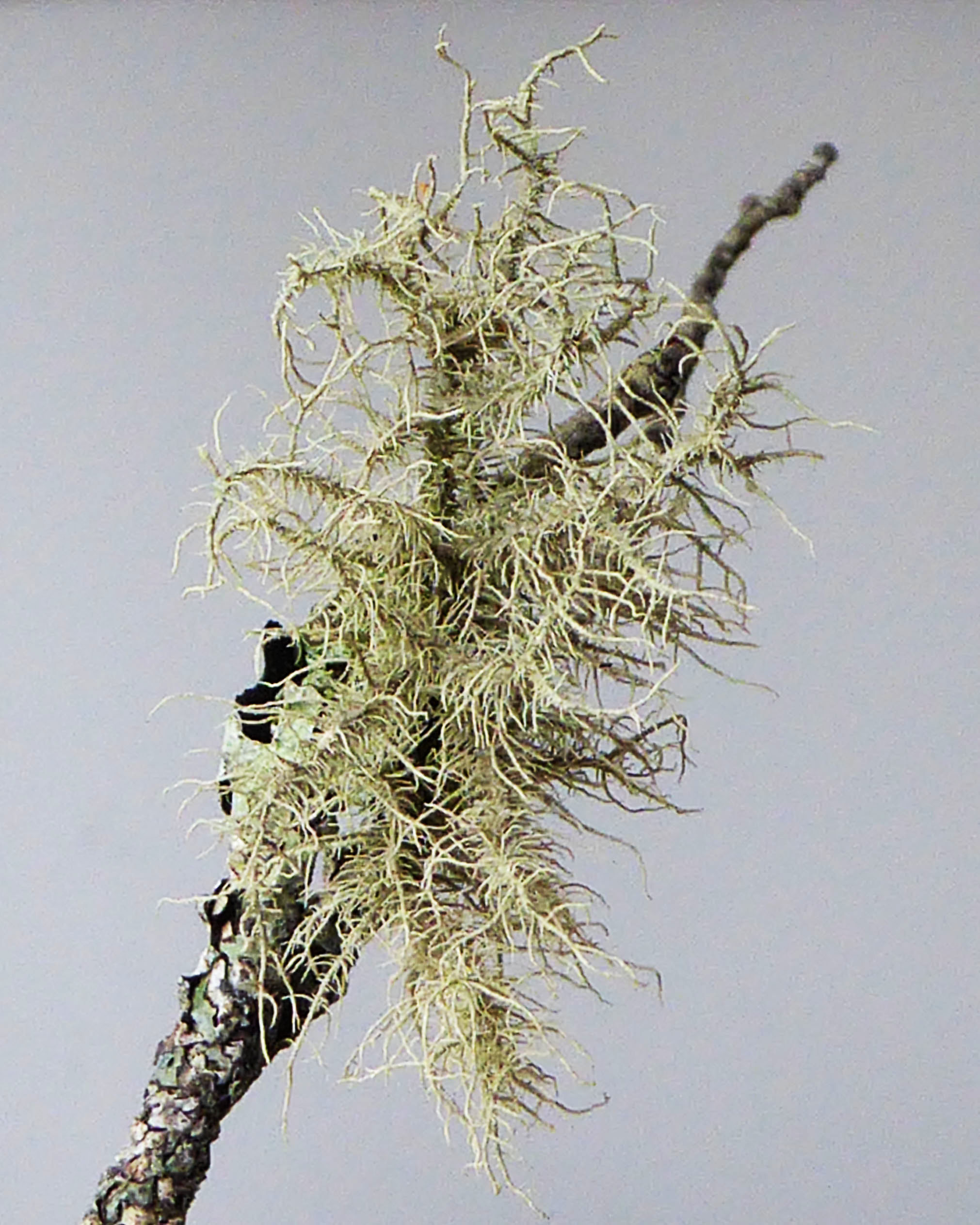
Now that the stubborn ice of the last months has melted, I have been looking again for lichens during my daily run through the dunes of Crane Beach. There are two that are extremely widespread, common greenshield lichen and reindeer lichen. I had nearly decided that that was it: the sandy soil is almost devoid of nutrients, and whatever grows needs to be salt-tolerant. It is a very specialized ecosystem of a small number of species. Better look in a different place if I want to find something different!
But I was mistaken. Today I came across a new one. I have learned that appearances may be deceiving, but the looks of this one fits classic lichen characteristics very well, on the surface of things. Lichens are made mostly of a fungus, of filamentary composition and usually very light in color, and a lesser bulk of an alga, usually green or less often blue. This growth is a thready, light-green structure.
It is clearly of the genus Usnea, most likely of the species subfloridana (I decided subsequently).
I am excited.
In passing: scrub oak (Quercus ilicifolia) is a long-lived species that has large taproots upon which several generations of above-ground parts may appear. This makes it a good place for a slow-growing twig lichen to be. Why twigs? – I don't know, but I have observed broken-off oak twigs with beard lichens far from any established clusters. It may be that wind-blown twigs are a good vehicle for the lichen to widen its propagation.
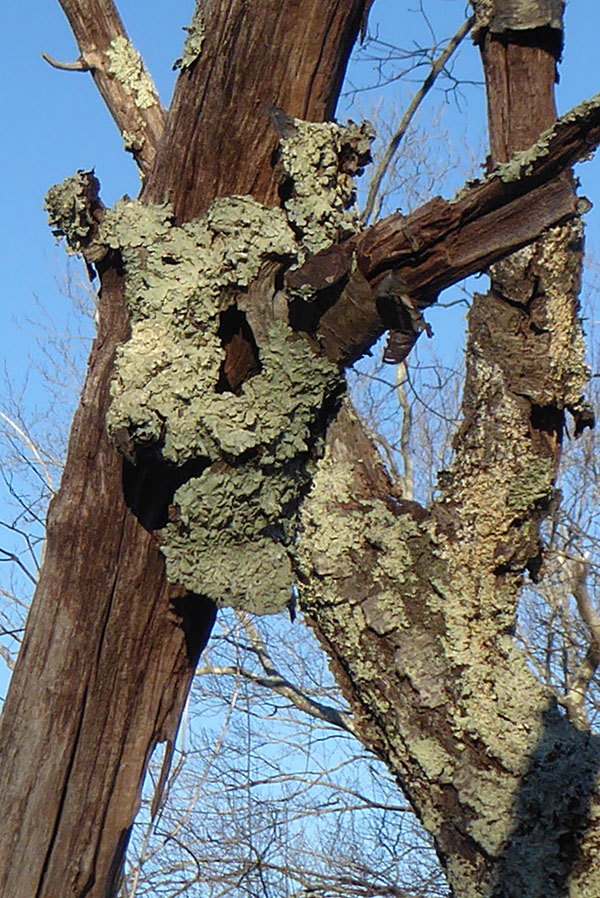
Though early January morning weather has been offering a wind chill factor of 0° F, it turns out that there have been good opportunities for field observation, prompted by my new lichen book.
The growth here is a common greenshield lichen, one of the most prevalent varieties globally and locally. It is a symbiotic combination of a fungus (Flavoparmelia caperata) and a green microalga (Trebouxia).
The microalga component has the capability of photosynthesis, deriving nutrient energy from the air and sunlight. It is notable here that the lichen displays a greenish tint even in mid-winter, in contrast to most of the deciduous plant life around it, now dead, brown and yellow.
The cells of the fungus are filamentary. As my reference notes, these threadlike structures weave into and around the alga, providing a firm base and skin. The durability of the composite is evident in the photograph. The lichen is still present and evidently alive, hanging loosely around the branch, long after the tree itself has died, the bark has dropped, and the wood itself is in marked decay.
Alphabetical by scientific name
© 2026 Paul Nordberg